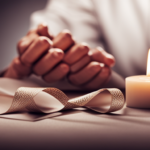Candles
What to Put Under a Candle

Ever thought about what to place beneath a candle to both elevate its aesthetic and safeguard your surfaces? Search no more! We, your devoted candle aficionados, are here to lead the way.
When it comes to serving others, we understand the importance of creating a warm and inviting atmosphere. That’s why we’ve compiled a list of practical and stylish options for you to choose from.
Coasters, trays, plates, and candle holders are all excellent choices for keeping your candle secure and your surfaces safe. For extra protection, consider heat-resistant mats, ceramic tiles, marble slabs, or stone coasters. And if you’re going for a rustic touch, wooden blocks will do the trick.
So, let’s dive in and discover the perfect foundation for your candle!
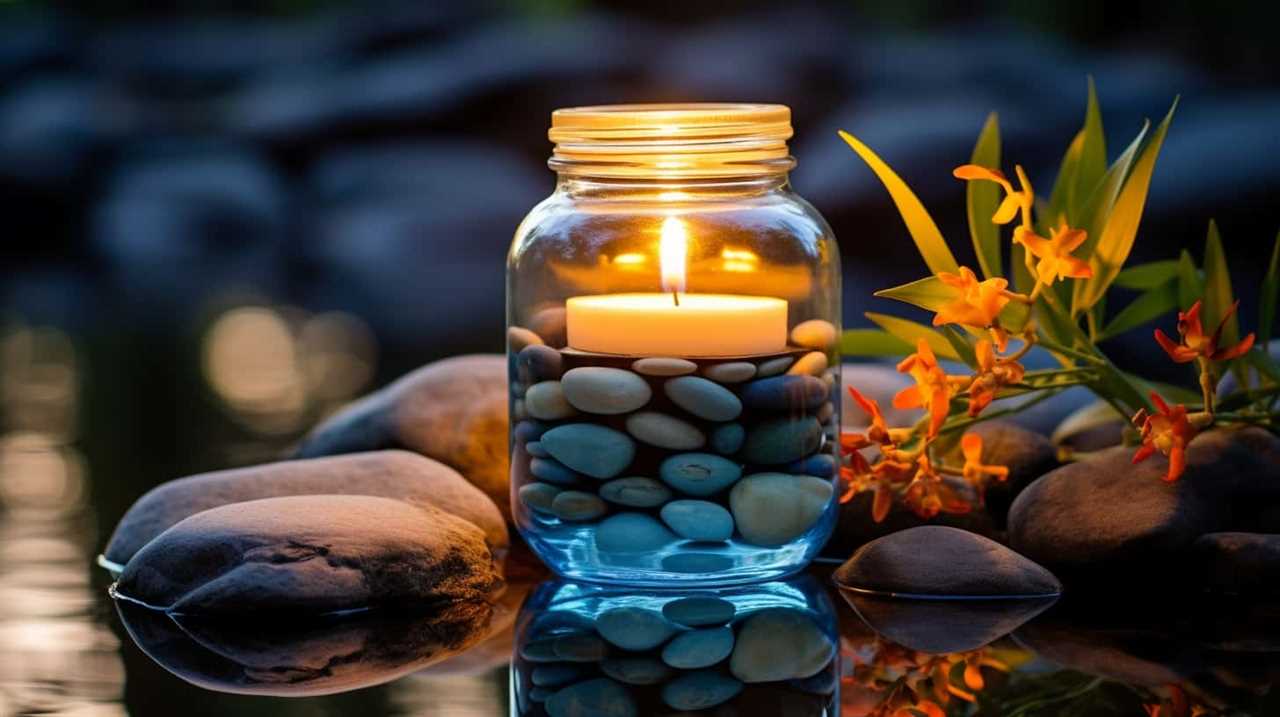
Key Takeaways
- Coasters, trays, plates, and heat-resistant mats are suitable options to place under a candle for protection.
- Candle holders, candle stands, wall sconces, mirrors, glass dishes, decorative saucers, ceramic tiles, and marble slabs can be used as decorative options for candle placement.
- It is important to consider safety precautions when choosing heat-resistant mats to ensure they can withstand the heat generated by the candle.
- When using candles, it is important to follow safety precautions to prevent accidents and ensure safe usage.
Coasters
We recommend using a set of sturdy coasters to protect your surfaces from the heat and wax of the candle. Coasters are a practical and stylish option for creating a barrier between your candle and your furniture.
There are various trivet options available in the market, ranging from sleek and modern designs to vintage-inspired ones. You can choose coasters made from materials such as wood, ceramic, or even marble, depending on your personal preference and decor style.
If you’re feeling crafty, you can also explore DIY alternatives. Get creative with materials like cork, felt, or even repurpose old tiles. DIY coasters allow you to add a personal touch and customize them to match your home’s aesthetic.
Trays
To further enhance the aesthetic appeal and functionality of your candle display, consider using a tray underneath. Trays not only provide a beautiful base for your candles, but they also serve a practical purpose by containing any wax drips or spills. With a wide variety of decorative options available, you can find a tray that perfectly complements your candles and fits seamlessly into your home decor. Here are some examples of trays you can use:
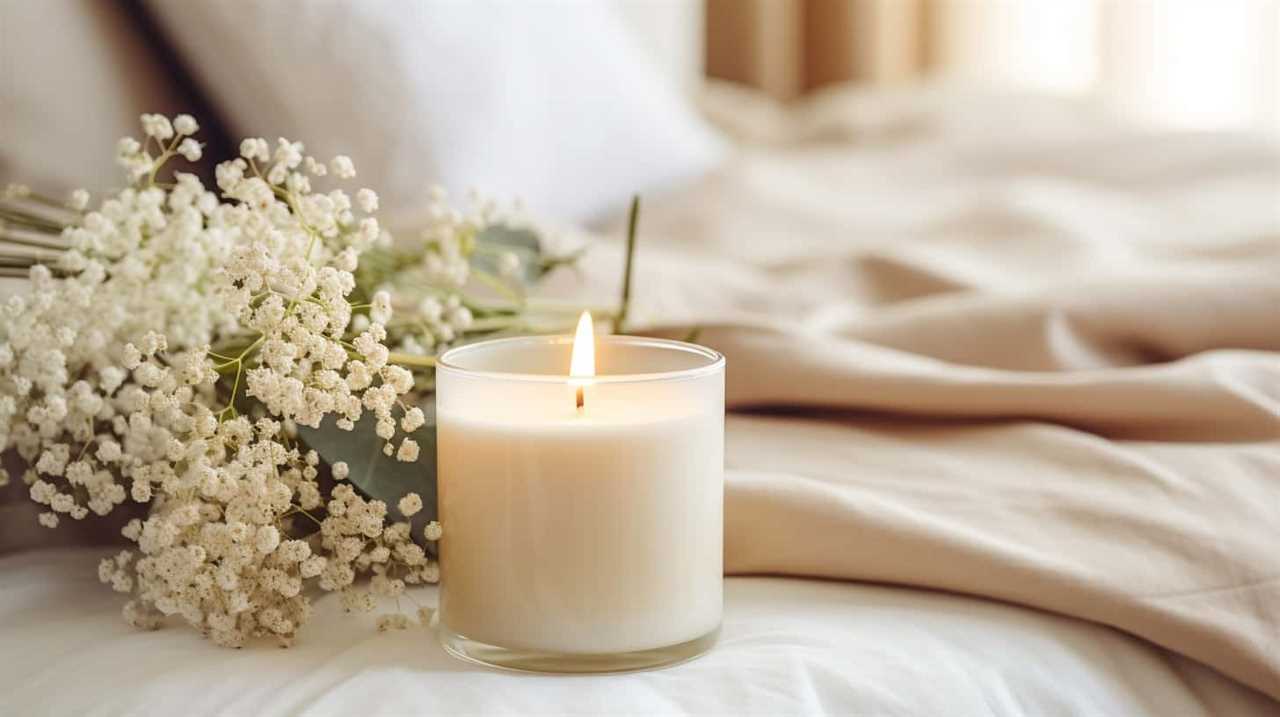
| Tray Material | Tray Shape | Tray Design |
|---|---|---|
| Wood | Rectangular | Carved Details |
| Metal | Round | Filigree Pattern |
| Glass | Oval | Mirrored Surface |
| Ceramic | Square | Hand-painted Tiles |
| Marble | Hexagonal | Veined Texture |
Choose a tray that matches your personal style and watch as it elevates your candle display to new heights of elegance.
Plates
One option to consider for placing under a candle is a set of small plates. Decorative plates can add an elegant touch to your candle display while also protecting your surfaces from any wax drips or heat damage.
Here are some alternative options to consider:
- Vintage China Plates: These delicate and intricately designed plates can add a touch of nostalgia to your candle arrangement.
- Ceramic Plates: Choose plates with unique patterns or vibrant colors to complement the style of your candles.
- Glass Plates: Opt for transparent or colored glass plates to create a modern and sleek look.
- Metal Plates: For a more industrial or rustic vibe, metal plates in copper or silver tones can be a great choice.
With these decorative plates, you can enhance the aesthetic appeal of your candle display while protecting your furniture.
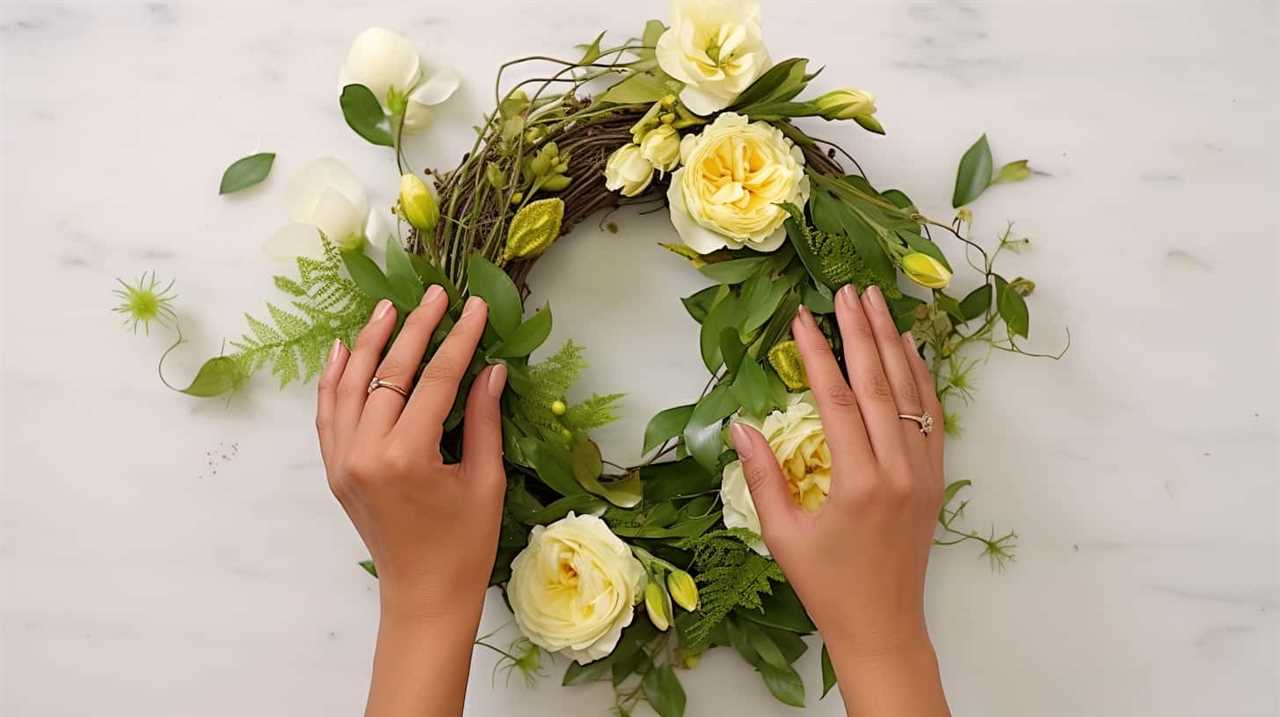
Speaking of protection, let’s now move on to the next section and explore some stylish candle holder options.
Candle Holders
For a variety of options, consider using different styles of candle holders to enhance your candle display. Candle holders not only provide a secure place for your candles but also add a touch of elegance and style to your home decor. There are various types of candle holders to choose from, including candle stands and wall sconces.
Candle stands are versatile and come in different heights and designs, allowing you to create visually appealing arrangements. On the other hand, wall sconces are perfect for adding a decorative touch to your walls while providing a safe spot for your candles. Whether you prefer a modern or traditional look, there are candle holders to suit every style and taste.
Now, let’s move on to the next section and explore the importance of heat-resistant mats.
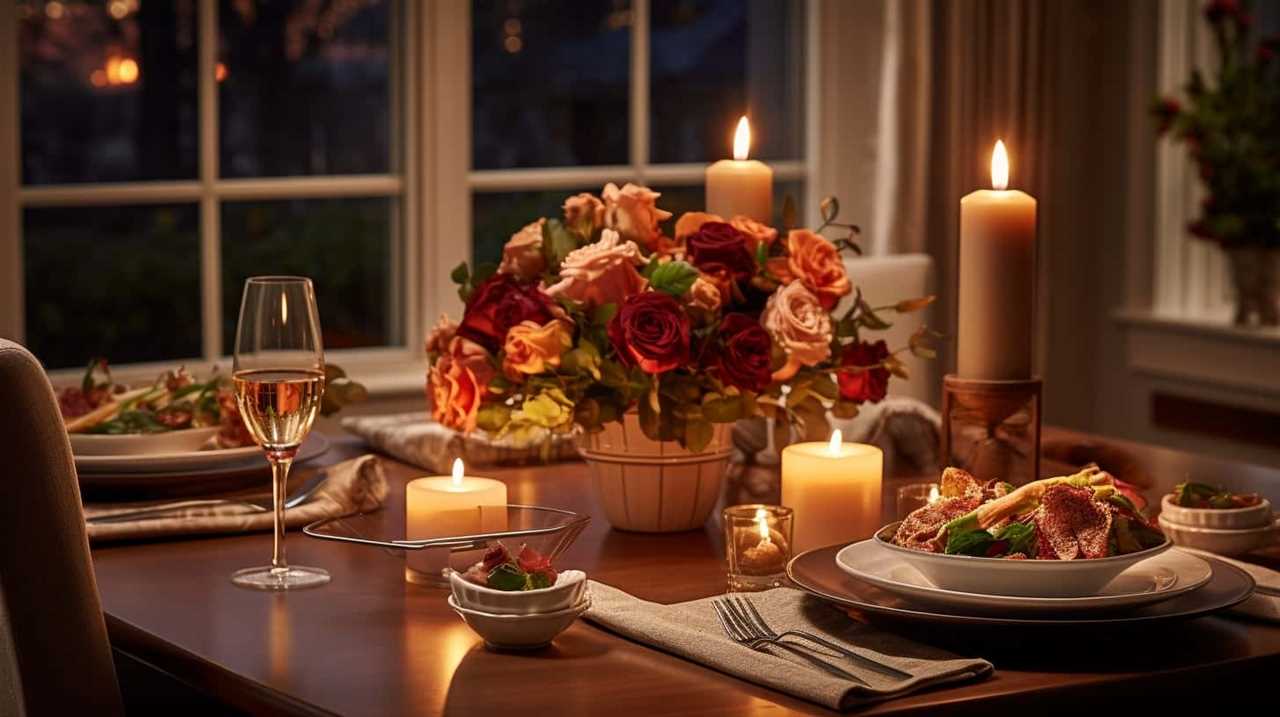
Heat-Resistant Mats
When it comes to protecting our surfaces from the heat of a candle, heat-resistant mats are a practical and stylish solution. There are various material options available, such as silicone or cork, that provide excellent heat resistance and durability.
It’s important to consider safety precautions when choosing a heat-resistant mat, ensuring it’s large enough to accommodate the size of the candle and made from non-flammable materials.
Additionally, there are decorative alternatives to traditional mats, like marble or ceramic coasters, that add a touch of elegance to our candle displays.
Material Options
Our preferred choice for protecting surfaces from heat damage caused by candles is using a heat-resistant mat. These mats are specifically designed to withstand high temperatures, ensuring the safety of your furniture and decor.
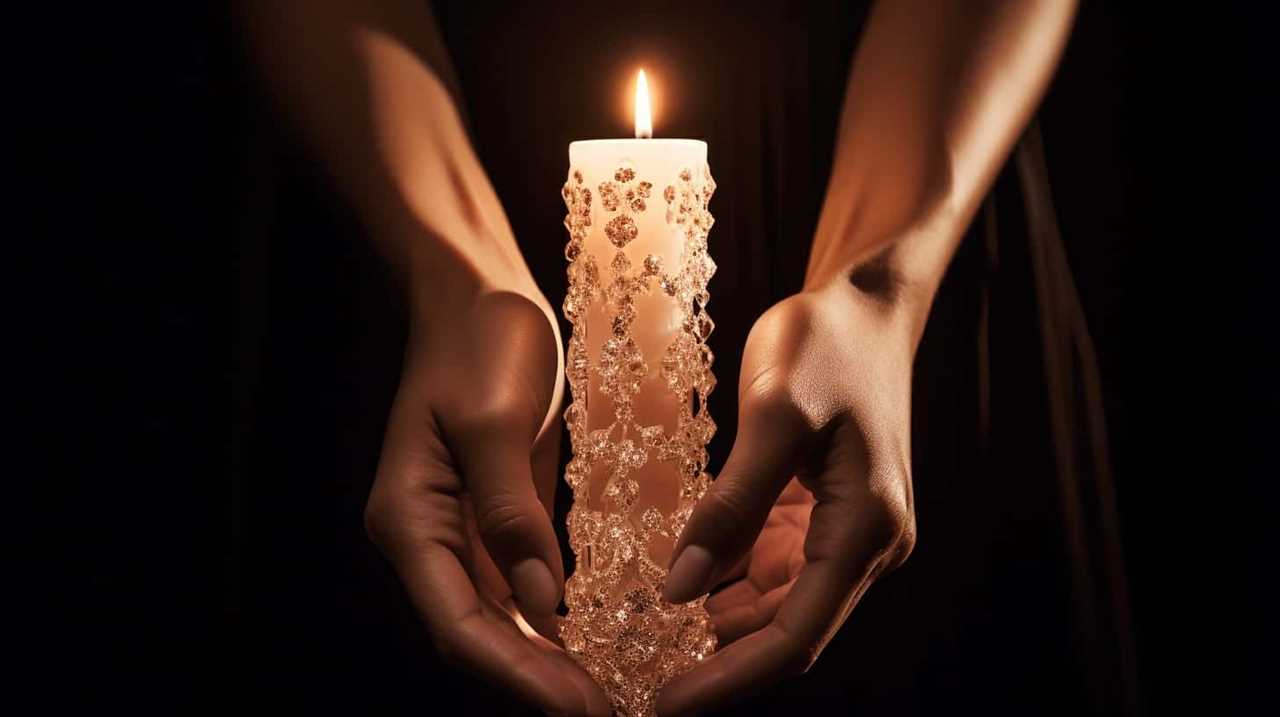
Here are some creative options for heat-resistant mats:
- Ceramic Coasters: These stylish coasters not only protect your surfaces but also add a touch of elegance to your space. They’re made from heat-resistant materials, preventing any damage caused by the candle’s heat.
- Silicone Mats: These versatile mats aren’t only heat-resistant but also non-slip, providing an extra layer of protection. They come in various colors and patterns, allowing you to choose one that matches your aesthetic.
- Glass Trivets: These transparent mats are perfect for showcasing your beautiful tablecloth or wooden table while still protecting them from heat. They’re both practical and visually appealing.
- Metal Heat-Resistant Pads: These durable pads are made from heat-resistant materials such as stainless steel or aluminum. They provide excellent heat insulation and can withstand high temperatures without warping or melting.
Using a heat-resistant mat is an essential safety precaution to prevent any damage to your surfaces. However, there are other precautions to consider when using candles.
Safety Precautions
To ensure the safety of our furniture and decor, it is important to use heat-resistant mats when placing a candle. These mats are specially designed to protect surfaces from heat damage and prevent any potential fire hazards. Heat-resistant materials, such as silicone or ceramic, are used to make these mats, ensuring that they can withstand high temperatures without melting or catching fire. By using a heat-resistant mat, you can enjoy the warm ambiance of a candle without worrying about accidental fires or damage to your furniture. It is always better to be safe than sorry, and investing in a heat-resistant mat is a small but important step towards fire safety precautions in your home.
| Heat-Resistant Mat Options | Advantages | Disadvantages |
|---|---|---|
| Silicone mats | Highly heat-resistant | May be less aesthetically pleasing |
| Ceramic mats | Stylish and durable | Can be more expensive |
| Glass mats | Heat-resistant and stylish | Can be fragile |
Decorative Alternatives
For our safety and to protect our furniture, we can explore decorative alternatives to heat-resistant mats for placing candles. Here are four stylish options:
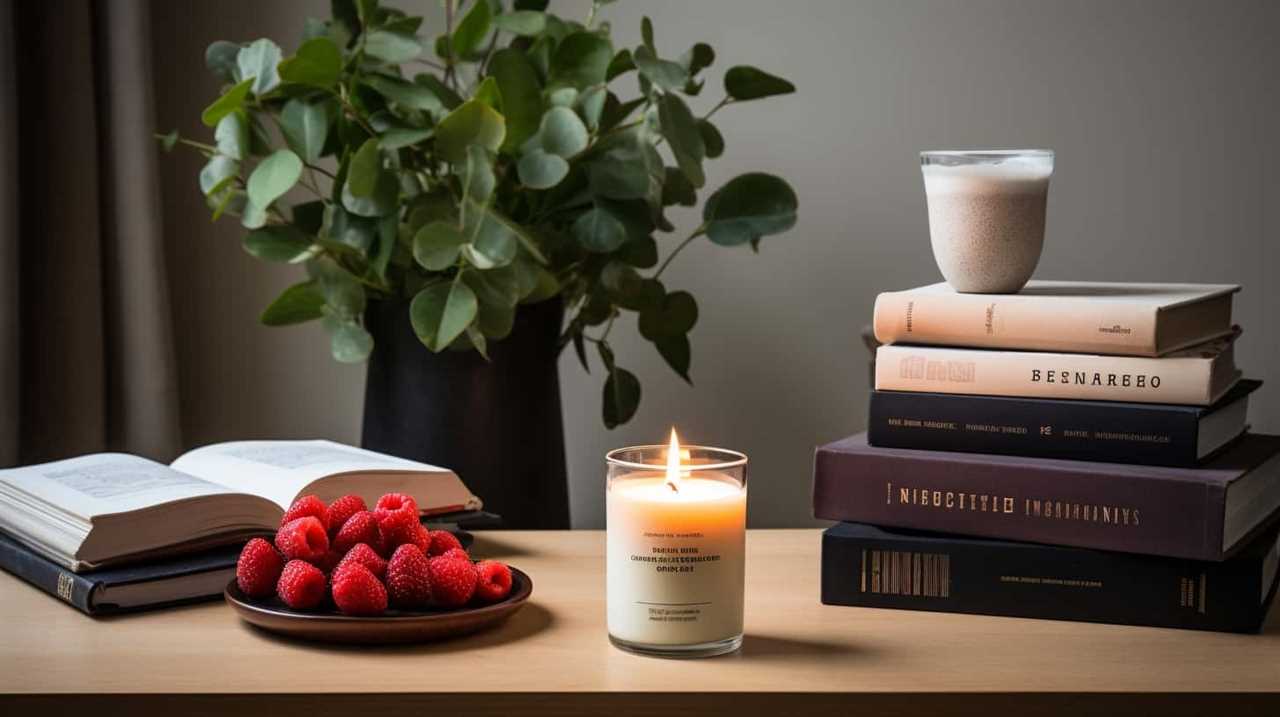
- Decorative Bowls: Transform your candle display by placing them in beautiful decorative bowls. Choose bowls made of heat-resistant materials like ceramic or glass. The bowl won’t only catch any wax drippings, but it will also enhance the overall aesthetic of your space.
- Flower Arrangements: Create a stunning centerpiece by incorporating candles into your flower arrangements. Use heat-resistant candle holders or insert the candles directly into the floral foam. The soft glow of the candles will add a warm and romantic touch to your arrangement.
- Mirrored Trays: Place your candles on a mirrored tray to create an elegant and reflective surface. The mirror won’t only protect your furniture from heat but will also amplify the candlelight, creating a mesmerizing visual effect.
- Succulent Gardens: Build a mini succulent garden around your candles. Use heat-resistant containers and arrange succulents of various shapes and sizes around the candles. The combination of greenery and candlelight will create a soothing and inviting atmosphere.
Mirrors
One popular option to place under a candle is a small, reflective mirror. Decorative mirrors and other reflective surfaces not only add a touch of elegance to your candle display, but they also serve a practical purpose. By reflecting the light from the flame, mirrors create a beautiful, luminous effect that enhances the ambiance of any room. Additionally, mirrors can help to amplify the glow of the candle, making it appear brighter and more radiant. To help you understand the impact of mirrors on candlelight, take a look at the table below:
| Mirror Size | Candle Size | Effect |
|---|---|---|
| Small | Small | Intimate glow |
| Medium | Medium | Soft, gentle light |
| Large | Large | Dramatic illumination |
As you can see, the size of the mirror and candle can influence the overall effect. Now, let’s explore another option to enhance your candle display: glass dishes.
Glass Dishes
Placing a candle on top of glass dishes can provide a stylish and versatile base for your candle display. Glass dishes, such as glass bowls, are a popular choice for creating a beautiful centerpiece or adding a touch of elegance to any room.
Here are four reasons why glass dishes are a great option for displaying your candles:
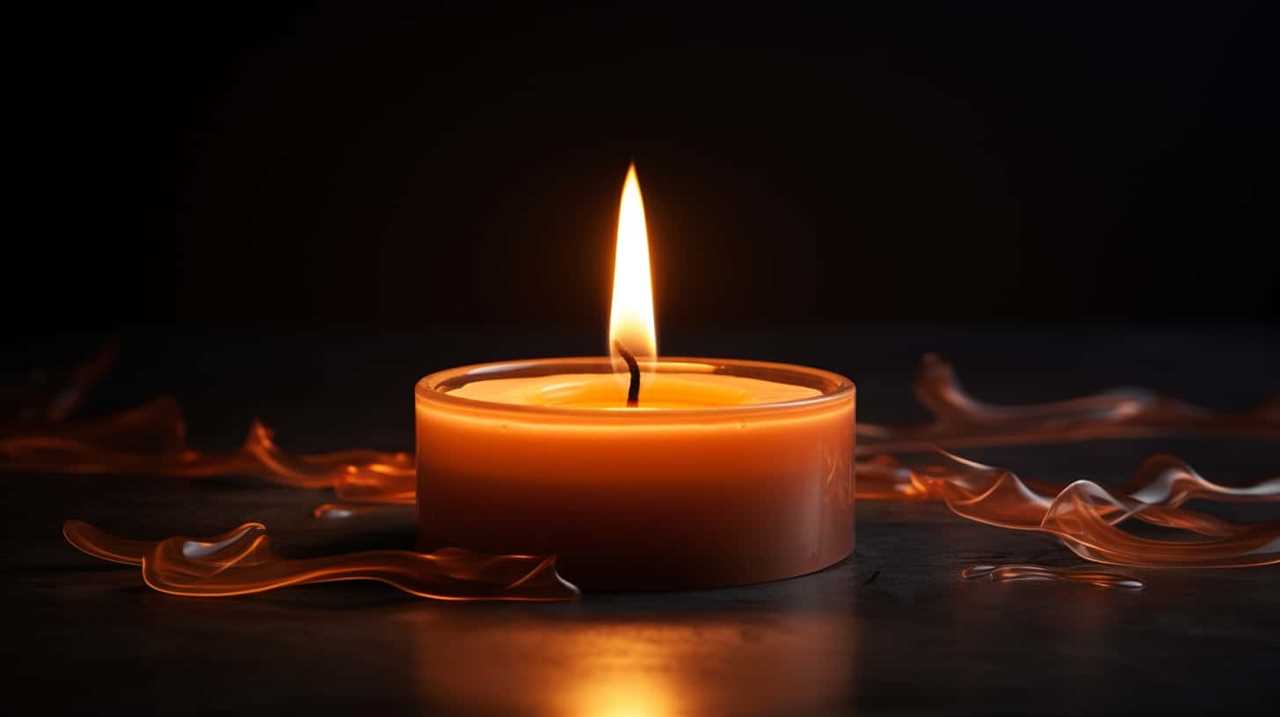
- Reflective surface: Glass dishes have a reflective surface that can enhance the ambient lighting created by the candle. This creates a warm and inviting atmosphere in your space.
- Heat resistance: Glass dishes are heat-resistant, making them a safe choice for holding candles. You can enjoy the beauty of the flickering flame without worrying about damaging the dish.
- Easy to clean: Glass dishes are easy to clean and maintain. Simply wash them with warm soapy water and dry them thoroughly before your next use.
- Creative possibilities: Glass dishes come in various shapes and sizes, allowing you to get creative with your candle displays. You can even use silicone molds to create unique and decorative candle holders.
With their beauty, practicality, and versatility, glass dishes make the perfect base for showcasing your candles. So go ahead and let your creativity shine!
Decorative Saucers
Glass dishes aren’t the only option for displaying your candles; another stylish choice is decorative saucers. When it comes to adding an elegant touch to your candle arrangements, decorative ceramic or porcelain saucers are perfect.
These saucers come in a variety of designs, from intricate patterns to simple and minimalist styles, allowing you to find the perfect match for your home decor. The smooth surface of these saucers provides a stable base for your candles, ensuring they stay in place while adding a touch of sophistication to any room.
Additionally, the delicate beauty of decorative saucers enhances the ambiance created by the flickering candlelight.
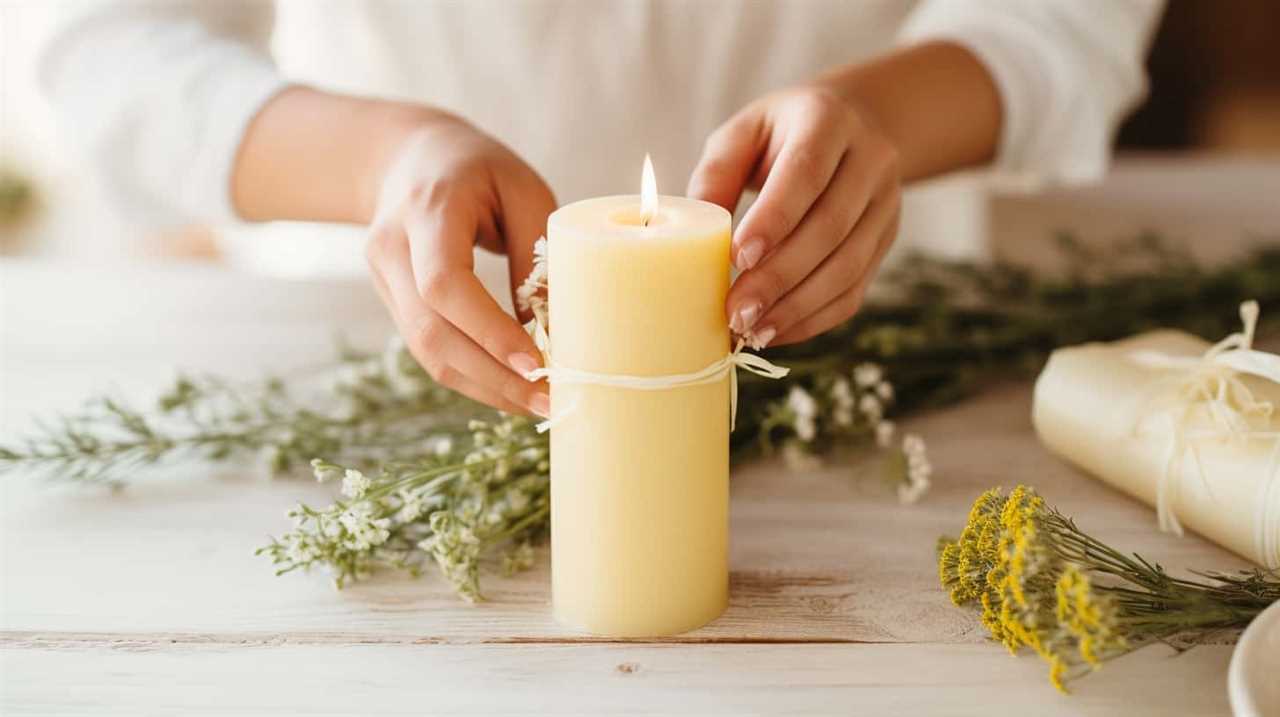
Now, let’s move on to another option for displaying your candles: ceramic tiles.
Ceramic Tiles
We have found that using a few ceramic tiles can be a great option for placing your candles on. Ceramic tiles not only provide a stable and heat-resistant surface for your candles, but they also add an elegant touch to your decor.
Here are four reasons why ceramic tiles are a fantastic choice for candle placement:
- Versatility: Ceramic tiles come in various shapes, sizes, and colors, allowing you to find the perfect match for your candle and overall aesthetic.
- Heat resistance: Unlike some other materials, ceramic tiles can withstand high temperatures without cracking or warping, ensuring the safety of your candles.
- Easy to clean: Ceramic tiles are non-porous, making them easy to wipe clean in case of any wax spills or drips.
- Durability: Ceramic tiles are known for their durability, so you can trust that they’ll provide a stable base for your candles for years to come.
When using ceramic tiles as candle holders, it’s important to take safety precautions such as keeping them away from flammable materials and never leaving a burning candle unattended.
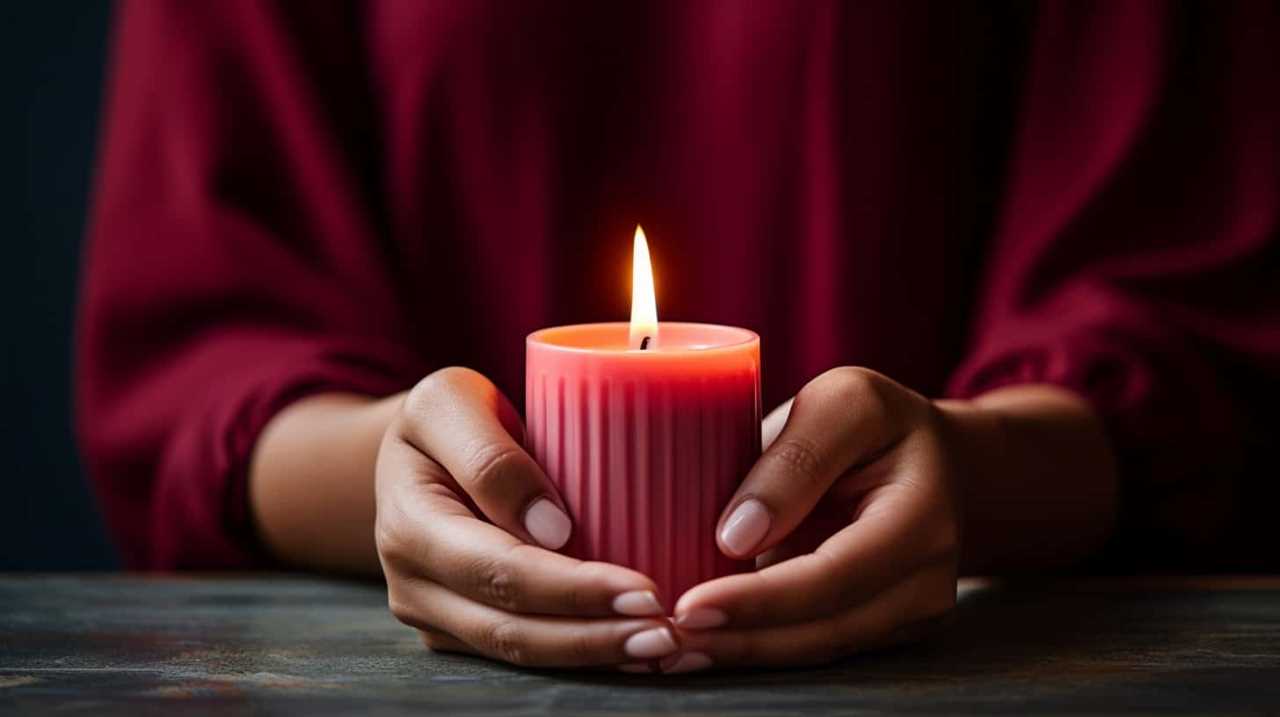
Marble Slabs
As candle enthusiasts, we can appreciate the heat resistance of marble slabs, which makes them the perfect choice for protecting surfaces from damage caused by hot wax and flames.
Not only do they serve a practical purpose, but marble slabs also add a touch of elegance and style to any candle arrangement.
The smooth, sleek surface of marble creates a beautiful contrast against the flickering flame, enhancing the overall aesthetic appeal of your decor.
Heat Resistance of Marble
Marble slabs exhibit exceptional heat resistance, making them an excellent choice for surfaces that come into contact with heat, such as marble countertops. Here are four reasons why marble slabs are a reliable option when it comes to fire safety:
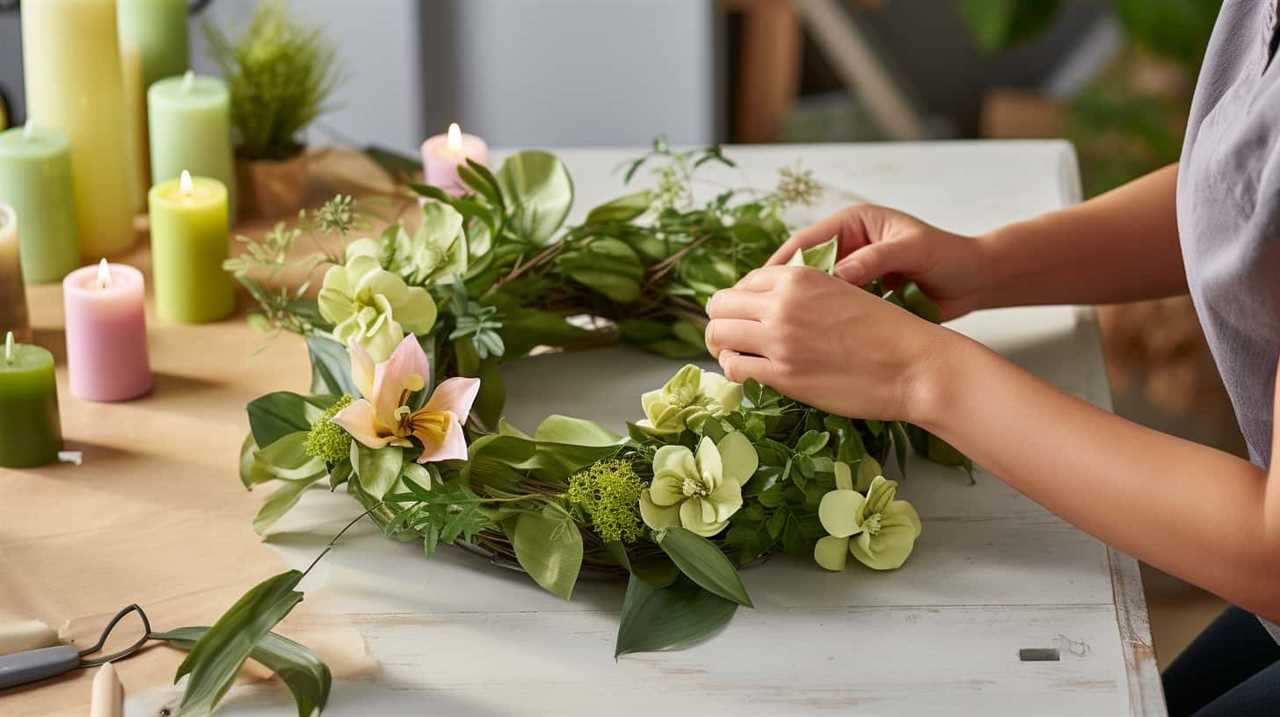
- Natural heat resistance: Marble has natural properties that make it highly resistant to heat, allowing it to withstand high temperatures without cracking or warping.
- Slow heat transfer: Marble has a low thermal conductivity, meaning it doesn’t conduct heat quickly. This helps to prevent the spread of heat and minimizes the risk of fire hazards.
- Non-combustible material: Marble is a non-combustible material, which means it doesn’t catch fire or contribute to the flames in case of a fire incident.
- Durability and longevity: Marble slabs are known for their durability, and their heat resistance adds to their longevity. With proper care, marble countertops can last for many years while maintaining their fire-resistant properties.
When it comes to fire safety, choosing marble slabs for surfaces like countertops can offer peace of mind and a stylish addition to any space.
Stylish and Elegant
One of the reasons marble slabs are a stylish and elegant choice is their timeless beauty. The natural veining and unique patterns found in marble create a visually stunning backdrop for your candles, elevating the overall aesthetic. Whether you choose a classic white marble or opt for a more dramatic black marble, the smooth and polished surface of the slab enhances the glow and flicker of the candlelight.
When it comes to candle displays and centerpiece ideas, marble slabs add a touch of sophistication and luxury to any setting. Additionally, marble slabs are versatile and can be used in various ways, such as a base for a cluster of candles or as a tray to hold smaller decorative elements.
With their elegance and charm, marble slabs are the perfect choice for creating stylish and memorable candle displays.
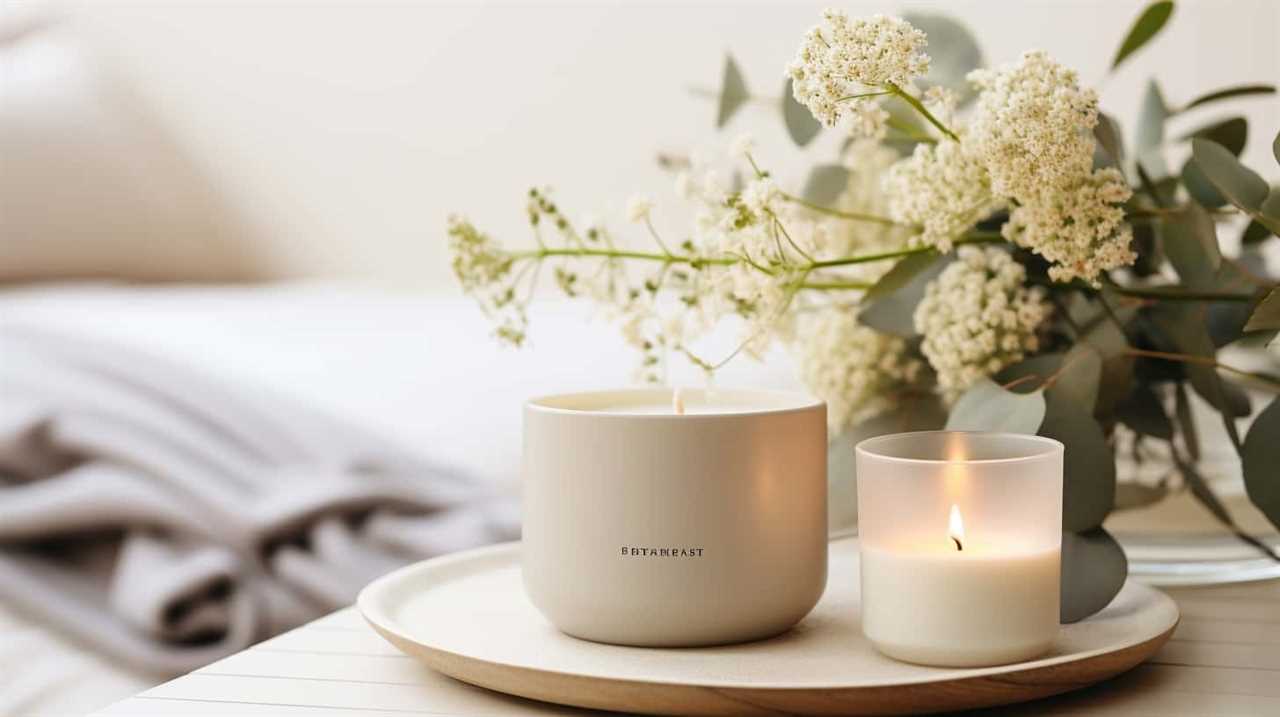
Protecting Surfaces From Damage
To ensure the longevity and pristine condition of our elegant marble slabs, it’s essential to take precautions in protecting the surfaces from any potential damage caused by candles. Here are four effective ways to safeguard your marble slabs:
- Use protective covers: Invest in heat-resistant covers specifically designed for candles. These covers will create a barrier between the candle and the marble surface, preventing any direct contact and potential damage.
- Apply surface protectors: Place adhesive surface protectors on the bottom of your candles. These protectors, made of felt or rubber, will act as a cushion and prevent scratches or marks on the marble surface.
- Utilize decorative trays: Place your candles on decorative trays made from materials like glass or metal. These trays not only add a stylish touch but also provide an extra layer of protection for your marble slabs.
- Opt for flameless candles: Consider using flameless candles that operate on batteries or LED lights. These candles eliminate the risk of heat damage altogether, ensuring the safety and preservation of your marble surfaces.
Stone Coasters
Our favorite choice for a candle base is a stone coaster. Stone coasters not only add a touch of elegance to any space but also provide excellent protection against heat.
Marble, in particular, is known for its exceptional heat resistance, making it an ideal material for stone coasters. The natural cooling properties of marble ensure that the heat from the candle is evenly distributed and doesn’t damage the surface underneath.
Additionally, stone coasters are sturdy and durable, ensuring that they can withstand the weight of the candle and prevent any accidental spills or damage.
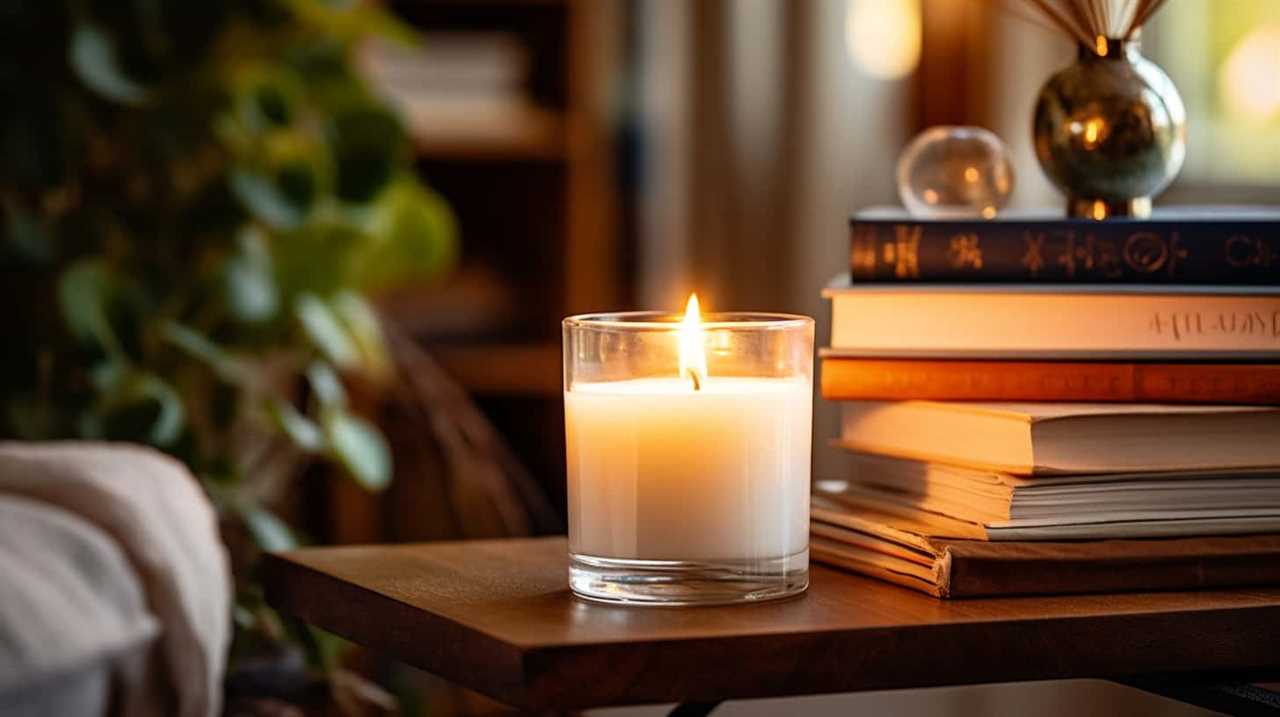
With their timeless beauty and practical functionality, stone coasters are the perfect choice for serving others and creating a warm, inviting atmosphere in any room.
Wooden Blocks
We prefer using wooden blocks as a base for our candles due to their natural charm and versatility. Here are four reasons why wooden blocks make the perfect choice for candle placement:
- Aesthetics: Wooden blocks add a rustic and organic touch to any space. Their natural grain and warm tones create a cozy ambiance that complements the flickering candlelight.
- Stability: Unlike stone coasters, wooden blocks provide a stable and sturdy base for candles. They prevent any wobbling or tipping, ensuring your candles stay upright and secure.
- Customization: Wooden blocks can be easily personalized to match your decor. You can paint or stain them in different colors, add patterns or designs, or even carve unique shapes to make them truly one-of-a-kind.
- Versatility: Wooden blocks come in various sizes and shapes, allowing you to choose the perfect one for your candles. Whether you have tall pillar candles or small votives, there’s a wooden block that will accommodate them beautifully.
When it comes to candle placement, wooden blocks offer both functionality and style, making them an excellent choice for any candle lover.
Frequently Asked Questions
Can I Use a Regular Plate as a Base for My Candle?
We recommend using a candle coaster or a glass dish as a base for your candle. They provide stability and protect surfaces from heat and wax. A regular plate may not be suitable for this purpose.
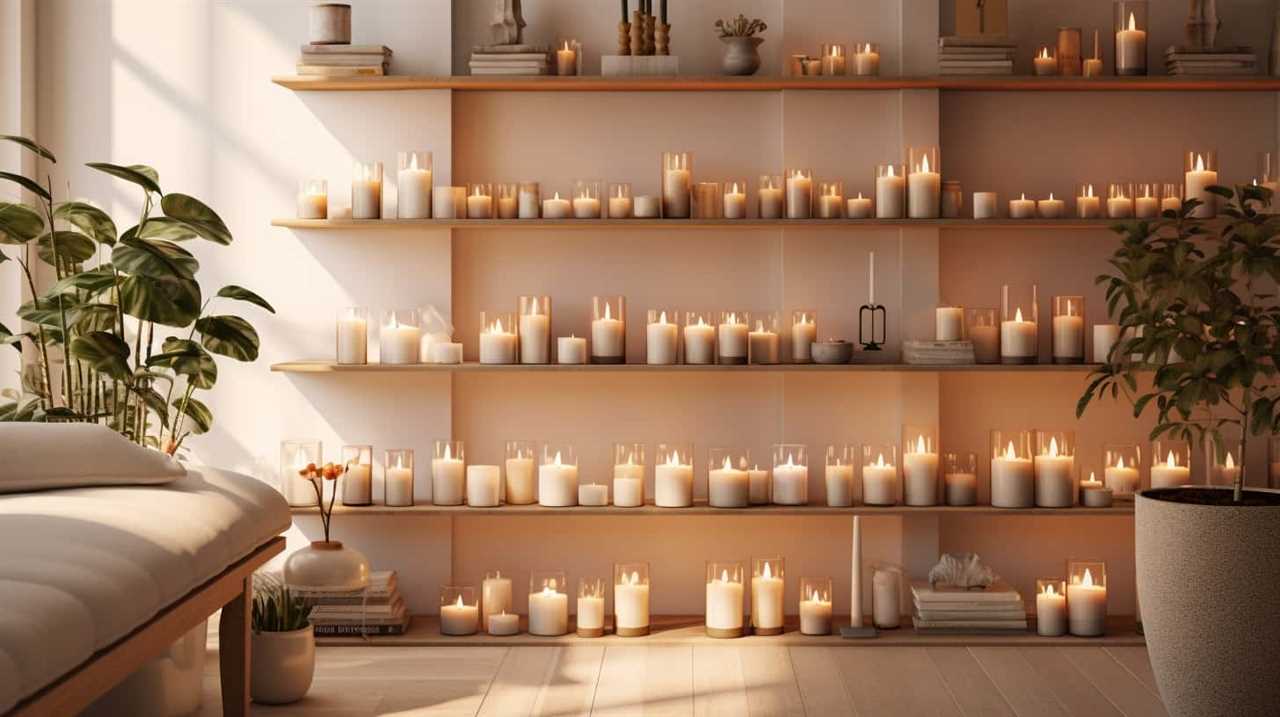
What Is the Best Material for a Heat-Resistant Mat?
The best materials for a heat-resistant mat are silicone, cork, or ceramic. These alternatives provide a stable and protective surface for your candle. They prevent heat transfer and ensure the safety of your home.
Is It Safe to Place a Candle Directly on a Wooden Surface?
Placing a candle directly on a wooden surface is not safe as it can cause a fire hazard. To protect your home, consider using heat-resistant mats or candle holders made of non-flammable materials as alternative bases.
Can I Use a Mirror as a Base for My Candle?
Using a mirror as a base for a candle can be a stylish and unique alternative to traditional candle bases. It adds a touch of elegance and reflects the candle’s light beautifully.
Are Ceramic Tiles Suitable for Holding Candles?
When it comes to candle holders for different surfaces, ceramic tiles are a great option. They provide a sturdy and heat-resistant base, ensuring the safety of your candles while adding an elegant touch to any space.
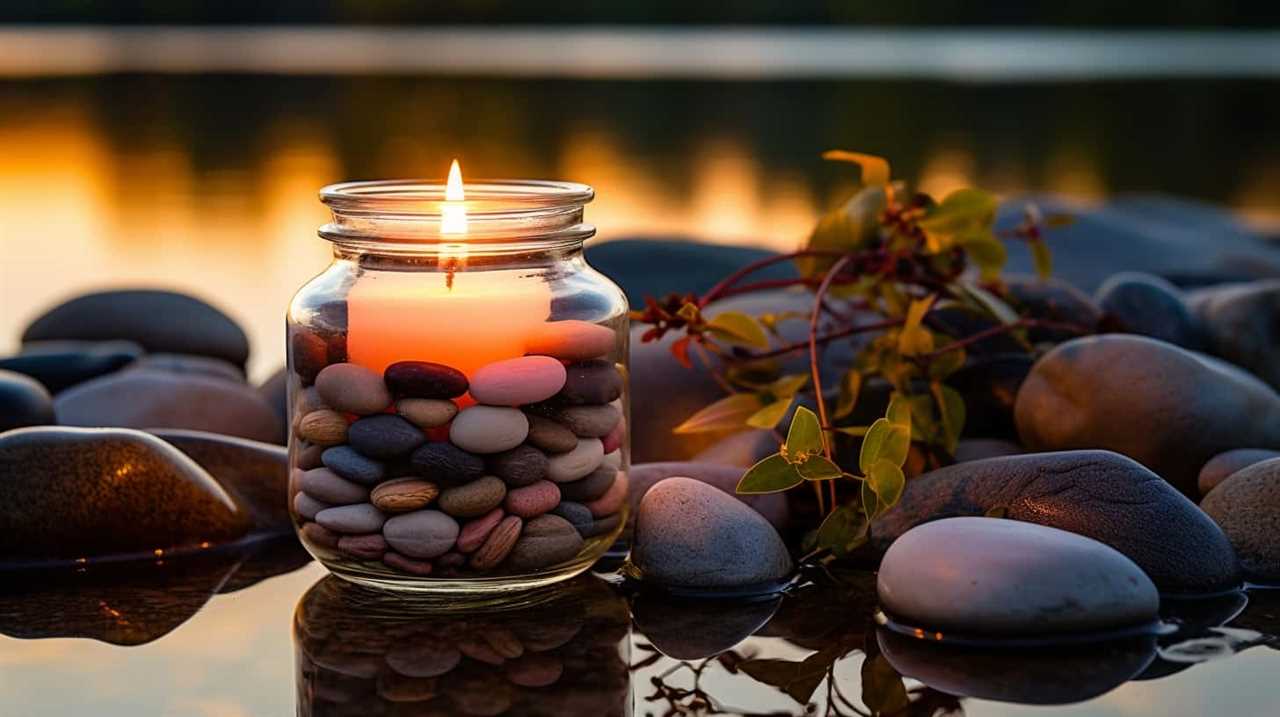
Conclusion
In the magical dance of flickering flames, our candles deserve a worthy stage. Coasters, trays, and plates offer a touch of elegance, while candle holders provide a regal pedestal.
Heat-resistant mats protect our surfaces with grace, while ceramic tiles and marble slabs bring a touch of sophistication. Stone coasters and wooden blocks add a rustic charm to the enchanting scene.
Whatever you choose, let your candles bask in the spotlight, casting their warm glow upon the world.
I’m Jane and I love candles. I have candles everywhere in my house–in every room, on every surface. I love the smell of candles, and I love how they make my place feel warm and cozy.
Candles are really important to me. They help me relax and de-stress after a long day. They remind me of happy memories, and they make me feel calm and peaceful. I can’t imagine my life without candles!
Candles
What Is a Candle Vigil

Have you ever considered the significance and impact of holding a candlelight vigil?
Well, let us shed some light on this solemn yet powerful act of unity and remembrance.
A candle vigil is a gathering where individuals come together, holding flickering flames in their hands, to honor and remember a person, event, or cause.
It is a way for us to show support, empathy, and solidarity with those who are hurting or in need.
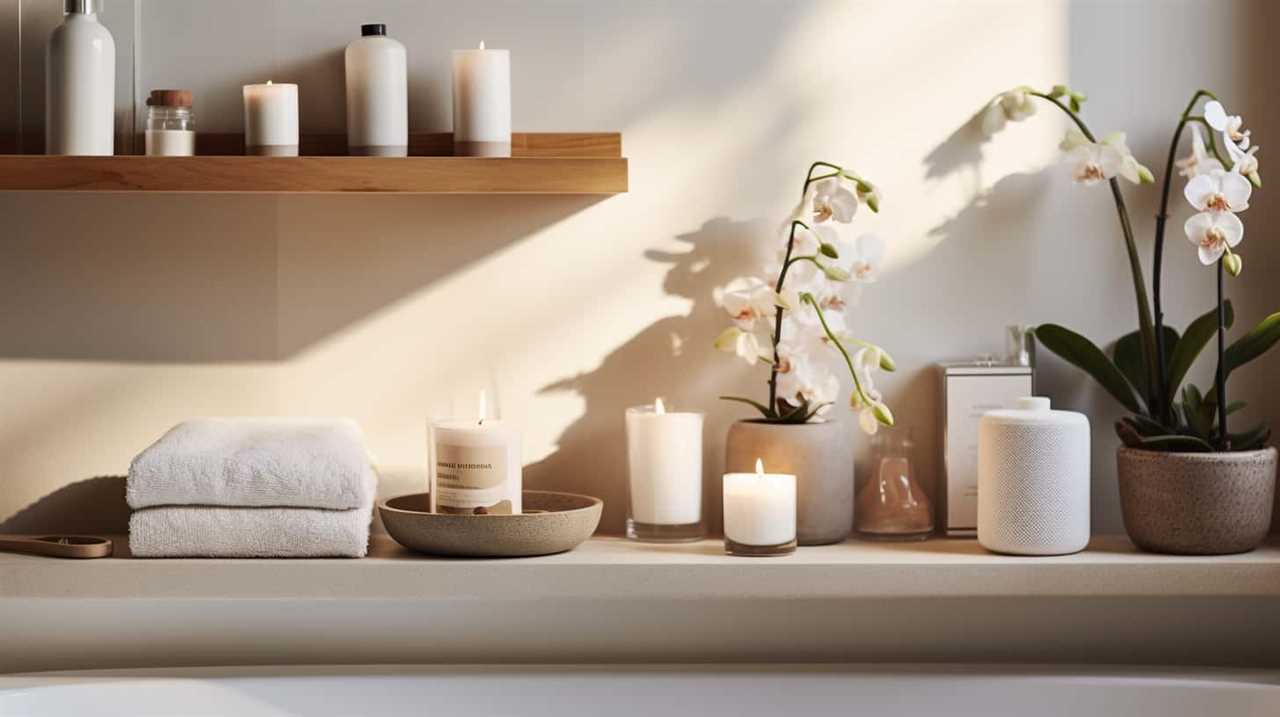
By lighting a candle, we symbolize our commitment to stand by them, offer solace, and bring hope in times of darkness.
Through this simple act, we can create a lasting impact and bring comfort to those who are struggling.
Key Takeaways
- Candle vigils have ancient origins and are rooted in the belief in the power of light.
- Lighting candles represents unity, hope, and remembrance.
- Candle vigils foster connection, healing, and support within communities.
- Participating in candle vigils promotes resilience and aids in emotional healing.
Origins and History
The origins and history of a candle vigil can be traced back to ancient times when communities would gather to honor and remember loved ones. This tradition has deep cultural significance, as it symbolizes unity, remembrance, and hope.
The practice of lighting candles during vigils originated from the belief that light has the power to dispel darkness and bring comfort to those in mourning. Over time, candle vigils have evolved to serve various purposes, such as raising awareness for social causes or expressing solidarity in times of crisis.
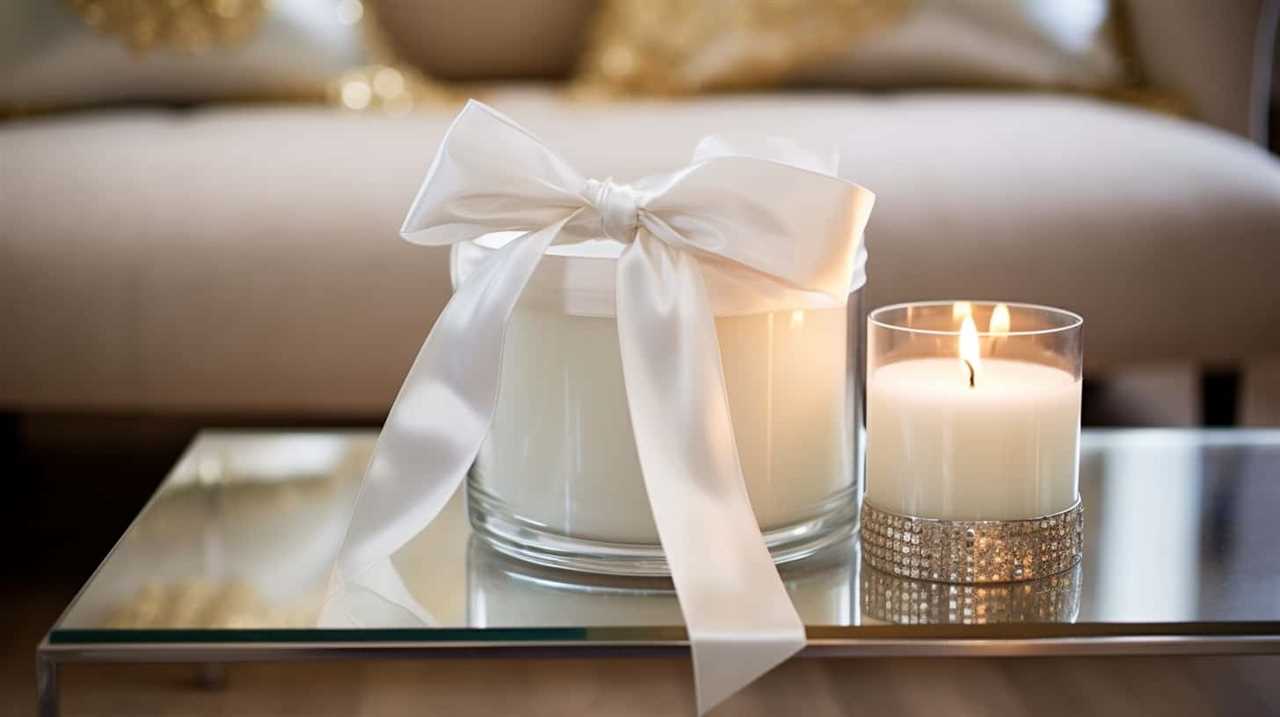
Regardless of the specific context, the act of coming together in candlelight fosters a sense of community and support. Now, let’s explore the symbolism and meaning behind this powerful tradition.
Symbolism and Meaning
One important aspect of candle vigils is their symbolism and meaning, which we’ll now delve into.
Candle vigils hold great cultural significance across different communities and religions. The act of lighting a candle represents unity, hope, and remembrance. It’s a way for individuals to come together and show solidarity in times of tragedy or loss.
The flickering flame symbolizes the light that guides us through darkness, offering comfort and solace. Candle vigils also serve as a form of emotional healing, allowing participants to express their grief and find support from others going through similar experiences.
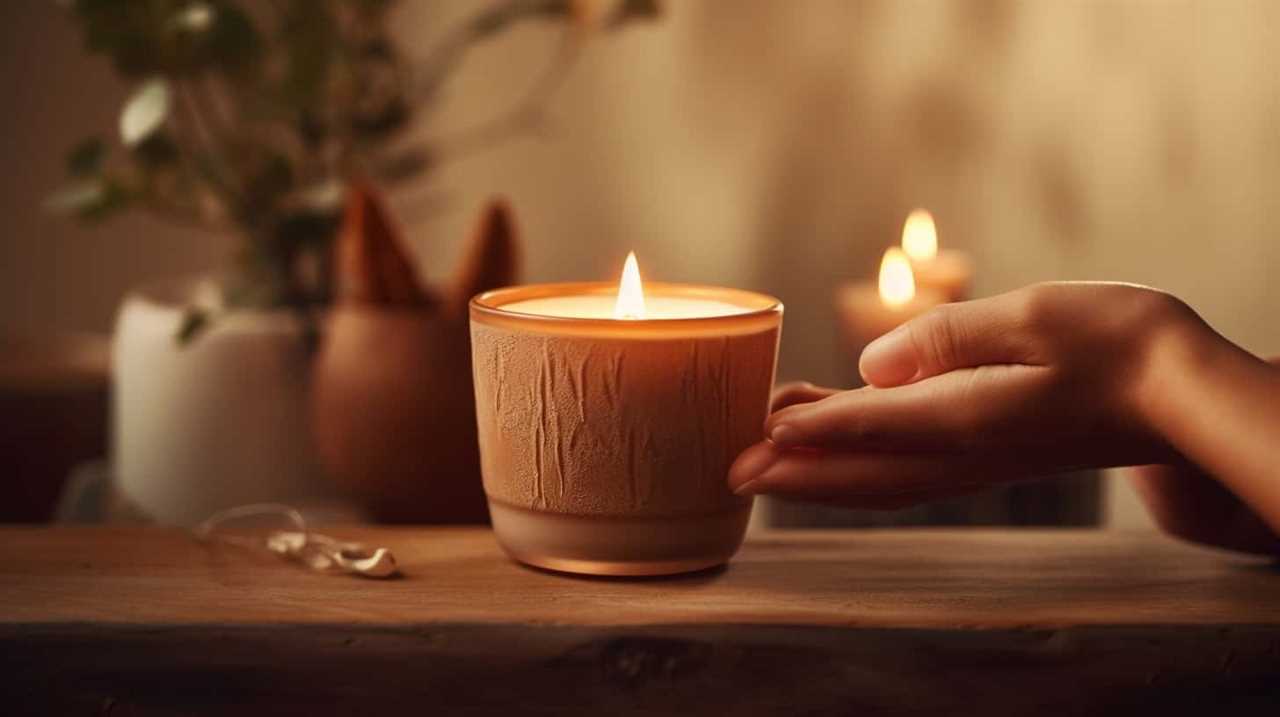
The soft glow of the candles creates a peaceful atmosphere, encouraging reflection and inner healing. Participating in a candle vigil can provide a sense of closure and promote community healing.
Purpose and Intent
Our purpose in holding candle vigils is to foster connection and healing within our community. These gatherings serve as a powerful means of emotional healing, allowing individuals to come together and support one another during times of grief and loss. Through the soft glow of candlelight, we create a sacred space for public remembrance, honoring the lives that have been touched by tragedy. To further illustrate the significance of candle vigils, let us reflect on the following table:
| Purpose | Intent | Outcome |
|---|---|---|
| Connection | To unite | Strengthened bonds |
| Healing | To comfort | Emotional solace |
| Remembrance | To honor | Collective healing |
| Reflection | To mourn | Personal growth |
These elements highlight the transformative nature of candle vigils, as they provide an opportunity for our community to come together, heal, and grow. Now, let’s explore the various elements and traditions associated with candle vigils.
Elements and Traditions
Now let’s delve into the rich tapestry of elements and traditions that make candle vigils such a meaningful and transformative experience for our community.
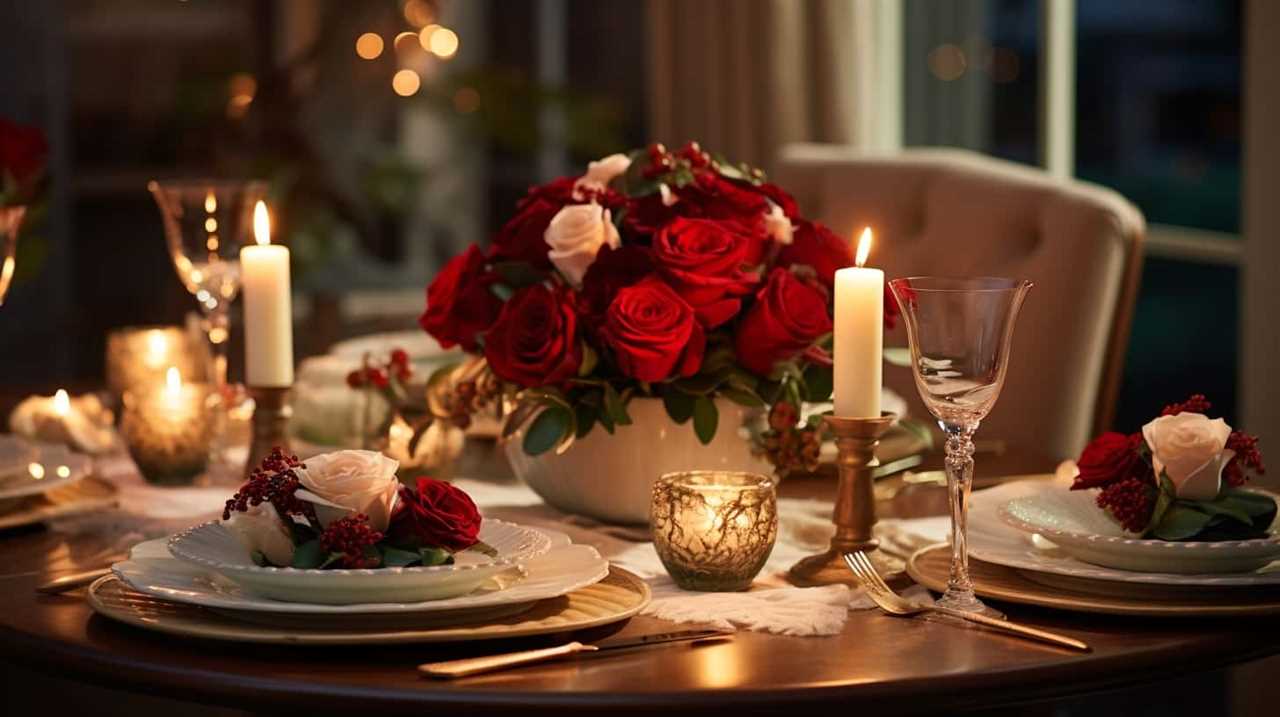
Candle lighting is an integral part of a candle vigil, symbolizing hope and unity. Participants gather in a designated area, each holding a lit candle, creating a warm and comforting atmosphere. The soft glow of the candles serves as a beacon of light amidst darkness, reminding us of the power of collective strength.
Another significant tradition during candle vigils is the formation of prayer circles. These circles allow individuals to join hands, fostering a sense of togetherness and support. Prayers are offered for healing, peace, and strength, providing solace to those in need.
These elements and traditions create a sacred space for reflection, connection, and communal healing, making candle vigils a transformative experience for all involved.
Planning and Organization
How do we effectively plan and organize a candle vigil?
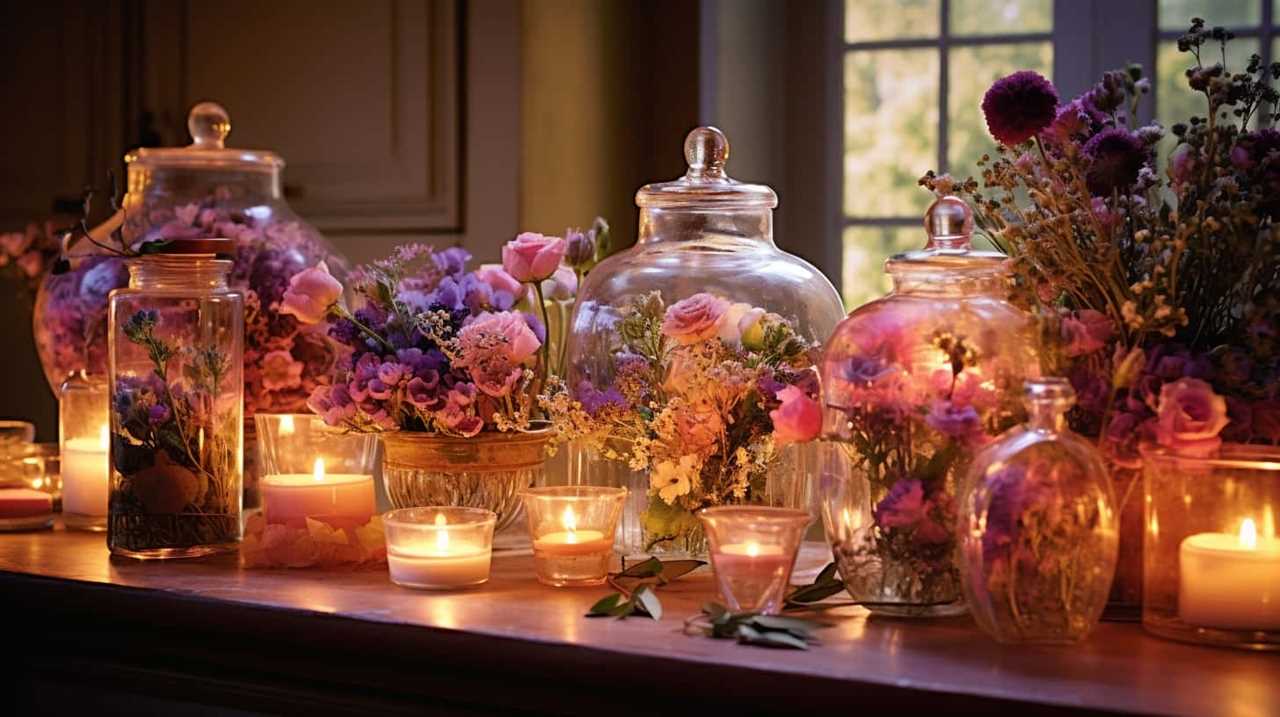
Planning and organizing a candle vigil requires careful attention to event logistics and participant engagement. Here are three key elements to consider:
- Location: Choose a venue that allows for a peaceful and reflective atmosphere. Consider factors such as accessibility, lighting, and seating arrangements to ensure the comfort and safety of participants.
- Program: Develop a thoughtful program that includes meaningful readings, music, and moments of silence. Engage participants by inviting them to share personal stories or memories, fostering a sense of community and support.
- Communication: Ensure clear communication with participants through various channels such as social media, email, or flyers. Provide detailed information about the vigil’s purpose, timing, and any specific instructions participants need to follow.
Conducting a Candle Vigil
To conduct a candle vigil, we must ensure that all participants are engaged and actively involved in the event.
The candle lighting ceremony is a central element of a candle vigil. It symbolizes the light of hope and unity in the face of darkness and despair.
Prior to the vigil, it’s important to prepare enough candles for all participants and designate a safe space for the candle lighting.
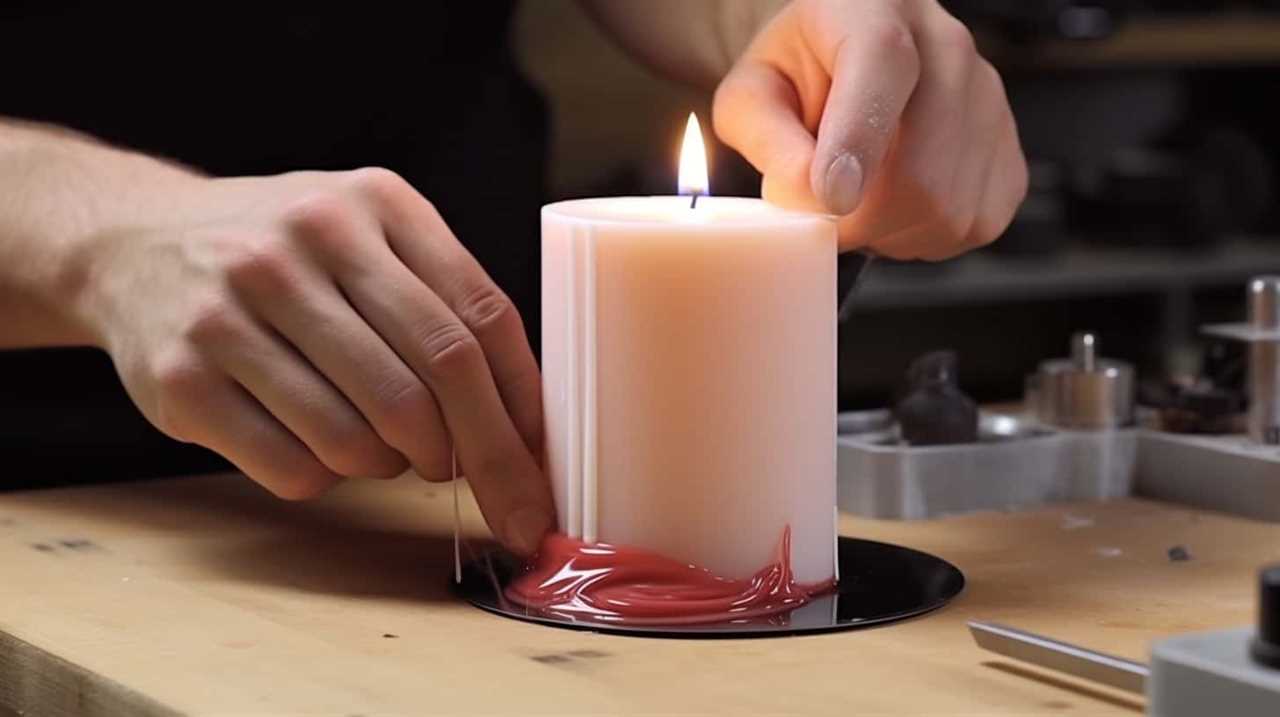
During the vigil, participants can gather in a circle or form rows, each holding a lit candle.
A prayer gathering can be conducted, where individuals can offer their personal prayers or listen to a designated speaker.
It’s crucial to create an atmosphere of reverence and respect, allowing participants to reflect and find solace in the shared experience.
Community Impact and Support
Community participation in a candle vigil can have a profound impact on individuals and foster a sense of support and unity. Here are three ways in which community engagement in candle vigils can promote emotional healing:
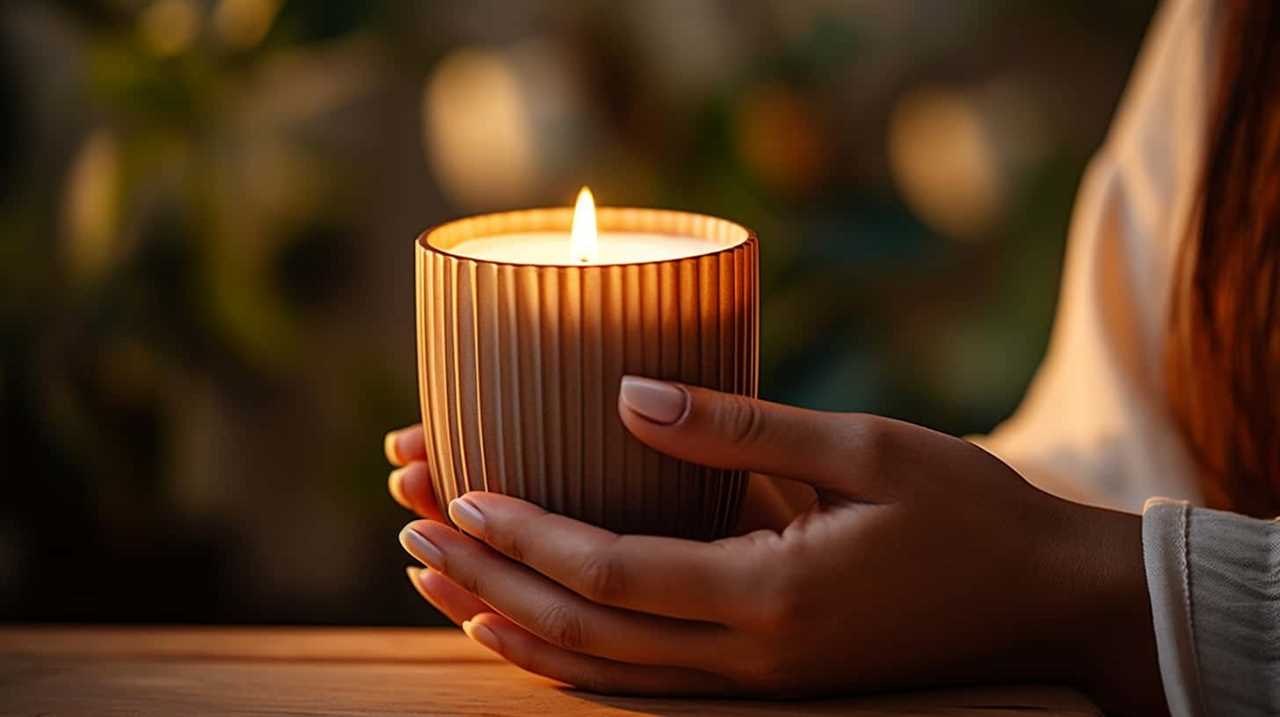
- Shared Grief: Coming together in a candle vigil allows individuals to acknowledge and share their grief with others who’ve experienced similar losses. This shared experience creates a supportive environment where individuals feel understood and validated.
- Connection and Empathy: Candle vigils provide an opportunity for individuals to connect with others who’ve gone through similar experiences, fostering empathy and a sense of belonging. This connection can be incredibly healing, as it reminds individuals that they aren’t alone in their pain.
- Symbolic Healing: Lighting candles during a vigil symbolizes hope, strength, and remembrance. This act can provide solace and promote emotional healing, as individuals find comfort in the collective act of honoring and remembering their loved ones.
By participating in candle vigils, communities can come together to support and heal one another.
Now let’s explore some examples and case studies to further understand the impact of candle vigils.
Examples and Case Studies
We have seen numerous examples and case studies that demonstrate the profound impact of candle vigils on individuals and communities. Candlelight gatherings have been found to provide emotional healing and support to those who are grieving or going through difficult times.
For example, after a tragic event such as a mass shooting or natural disaster, candle vigils often serve as a way for communities to come together, express their collective grief, and show support for the affected individuals and families. These gatherings offer a space for people to share their stories, offer condolences, and find comfort in the presence of others who are going through similar experiences.
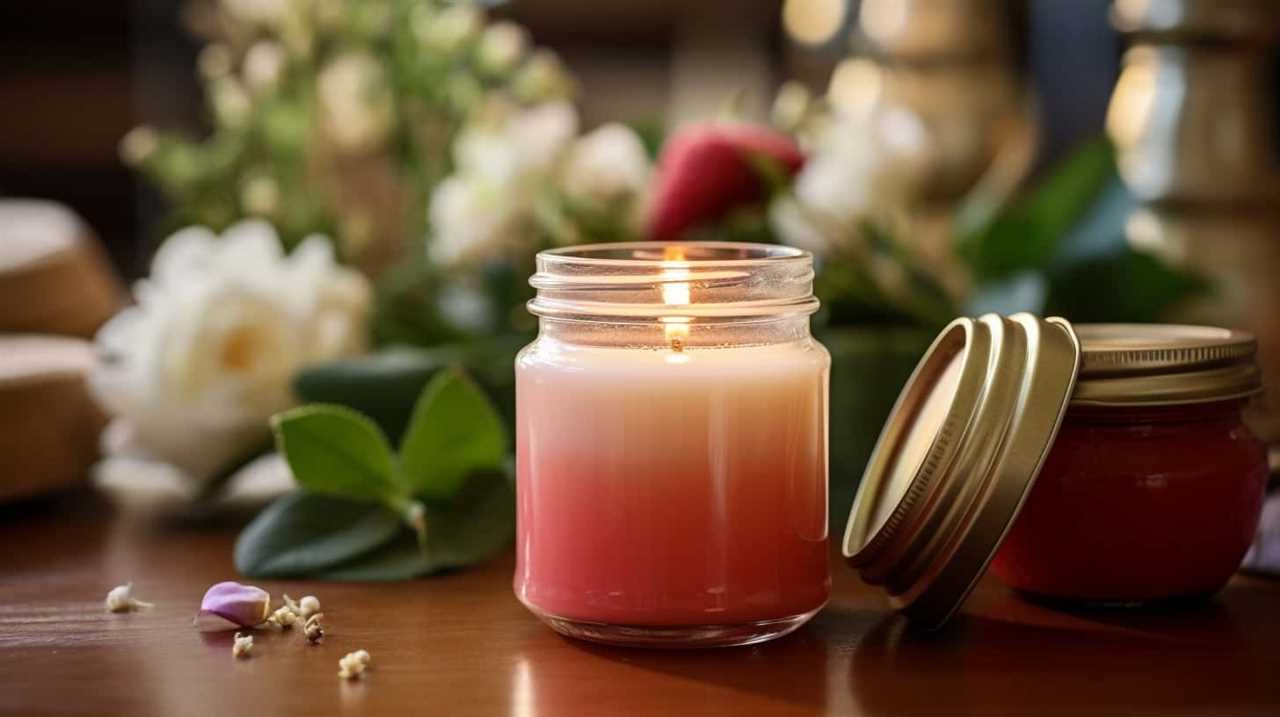
Research has shown that participating in candle vigils can promote a sense of belonging, unity, and resilience among community members, ultimately aiding in the process of emotional healing.
Frequently Asked Questions
What Are Some Common Types of Candles Used in Candle Vigils?
Different types of candles for candle vigils are often used. The symbolism of candle colors in vigils can vary. They provide a source of light and hope, fostering a sense of unity and remembrance.
Are There Any Specific Colors or Arrangements of Candles That Hold Special Significance in Candle Vigils?
Candle vigil colors and arrangements can hold special significance. Different colors may represent various emotions or causes, while specific arrangements can symbolize unity, remembrance, or hope. These elements contribute to the powerful and meaningful experience of a candle vigil.
How Can Individuals Involve Children in Candle Vigils?
Involving children in candle vigils can be a meaningful experience. Engaging them in creative activities like making their own candles or writing messages of hope can help them understand and participate in the event.
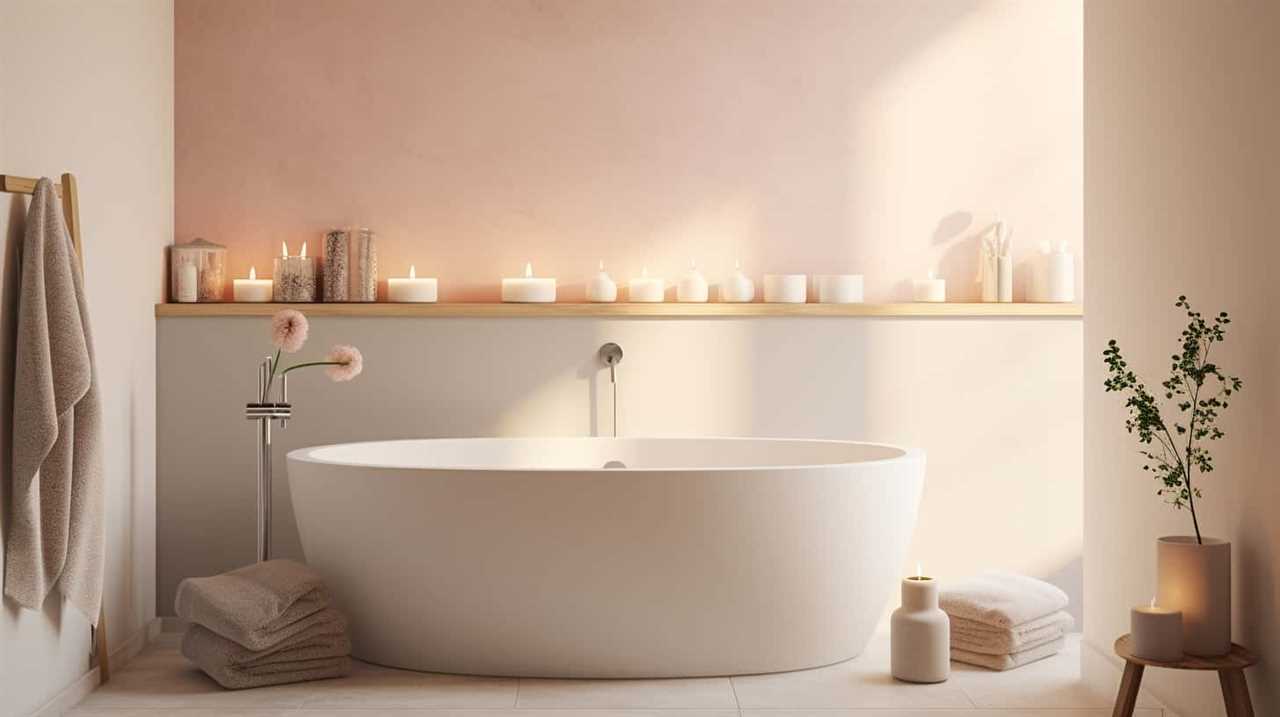
Are There Any Specific Prayers or Rituals That Are Commonly Used During Candle Vigils?
During candle vigils, we often come together in prayer, seeking solace and unity. Specific prayers may vary, reflecting different beliefs and intentions. Additionally, alternative rituals like lighting candles or holding moments of silence are commonly observed.
What Are Some Alternative Ways to Participate in a Candle Vigil for Those Who Are Physically Unable to Attend?
Virtual participation in a candle vigil allows those physically unable to attend to still be part of the event. Online platforms offer opportunities to light a candle, share prayers or thoughts, and connect with others in a meaningful way.
Conclusion
In conclusion, candle vigils have a rich history and hold deep symbolism and meaning. They serve as a powerful way to come together as a community, honor and remember loved ones, or raise awareness for a cause.
With careful planning and organization, candle vigils can have a profound impact on both individuals and the community as a whole.
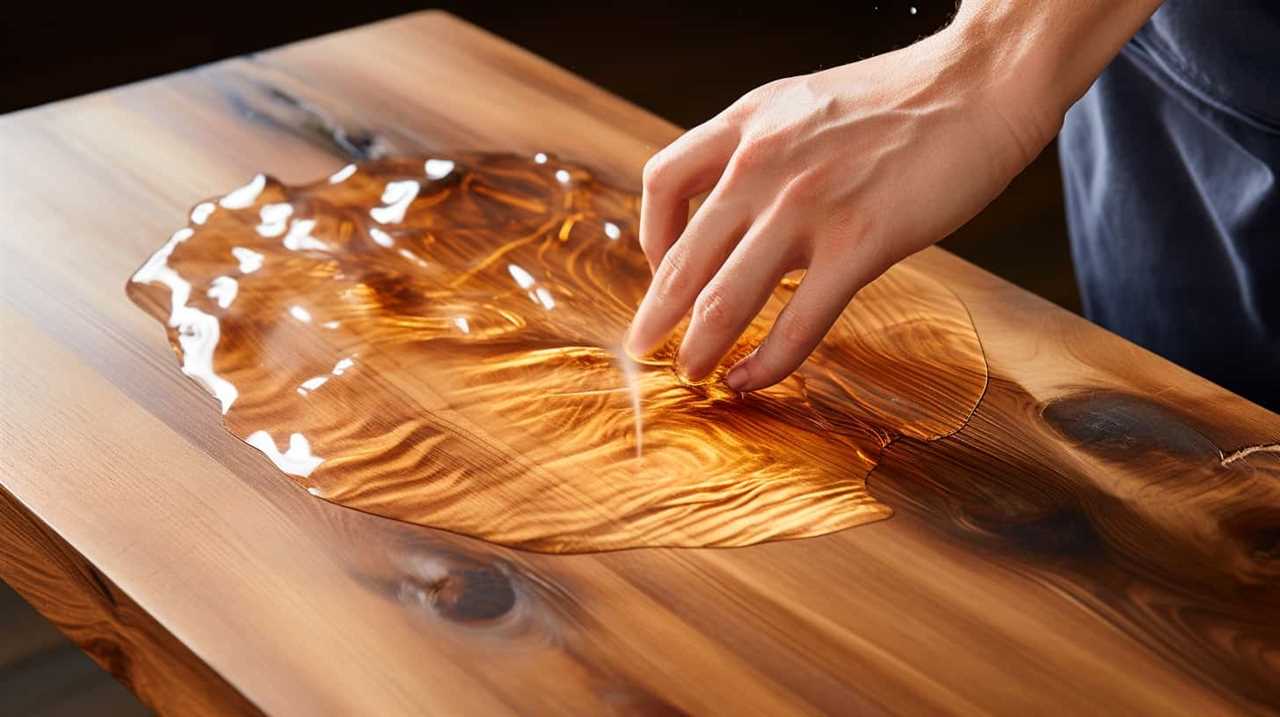
So, next time you see a candle vigil, ask yourself, how can a simple flame bring people together and ignite change?
I’m Jane and I love candles. I have candles everywhere in my house–in every room, on every surface. I love the smell of candles, and I love how they make my place feel warm and cozy.
Candles are really important to me. They help me relax and de-stress after a long day. They remind me of happy memories, and they make me feel calm and peaceful. I can’t imagine my life without candles!
Candles
What Is a Kwanzaa Candle Holder Called
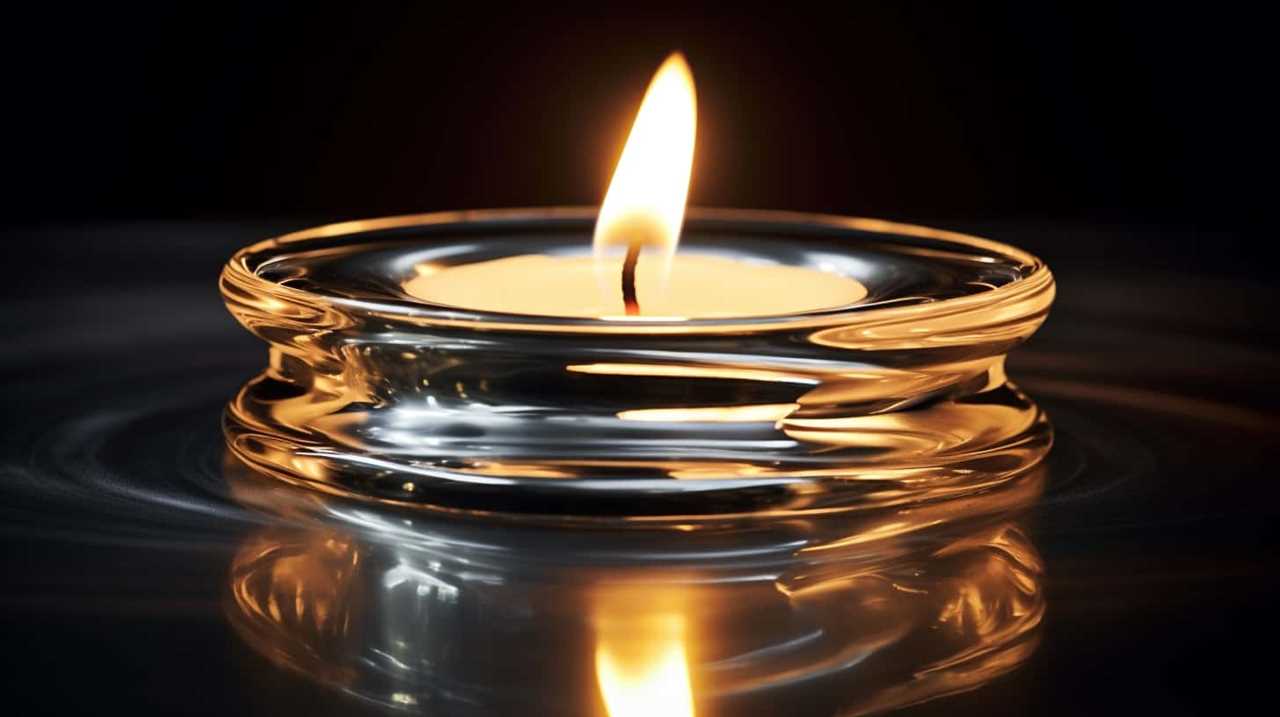
We all have a desire to assist others and broaden our understanding of different cultures. So, let’s dive into the fascinating world of Kwanzaa and learn about a Kwanzaa candle holder.
Kwanzaa, a celebration of African heritage, is marked by the lighting of seven candles. Each candle represents a different principle, such as unity, creativity, and faith. The Kwanzaa candle holder, known as a kinara, holds these candles and plays a significant role in the festivities.
Made from various materials like wood, brass, or clay, the kinara beautifully showcases the values and traditions of Kwanzaa. Join us as we explore the symbolism, meaning, and proper display of the Kwanzaa candle holder, enriching our understanding of this vibrant cultural celebration.
Key Takeaways
- The Kwanzaa candle holder is called the Kinara.
- It holds seven candles representing the Seven Principles of Kwanzaa.
- The Kinara is made from various materials like wood, brass, or clay.
- It represents African heritage and values and fosters a sense of unity and shared values.
The Origins of the Kwanzaa Candle Holder
The origins of the Kwanzaa candle holder can be traced back to the 1960s when Maulana Karenga, the founder of Kwanzaa, created the symbolic centerpiece known as the Kinara.
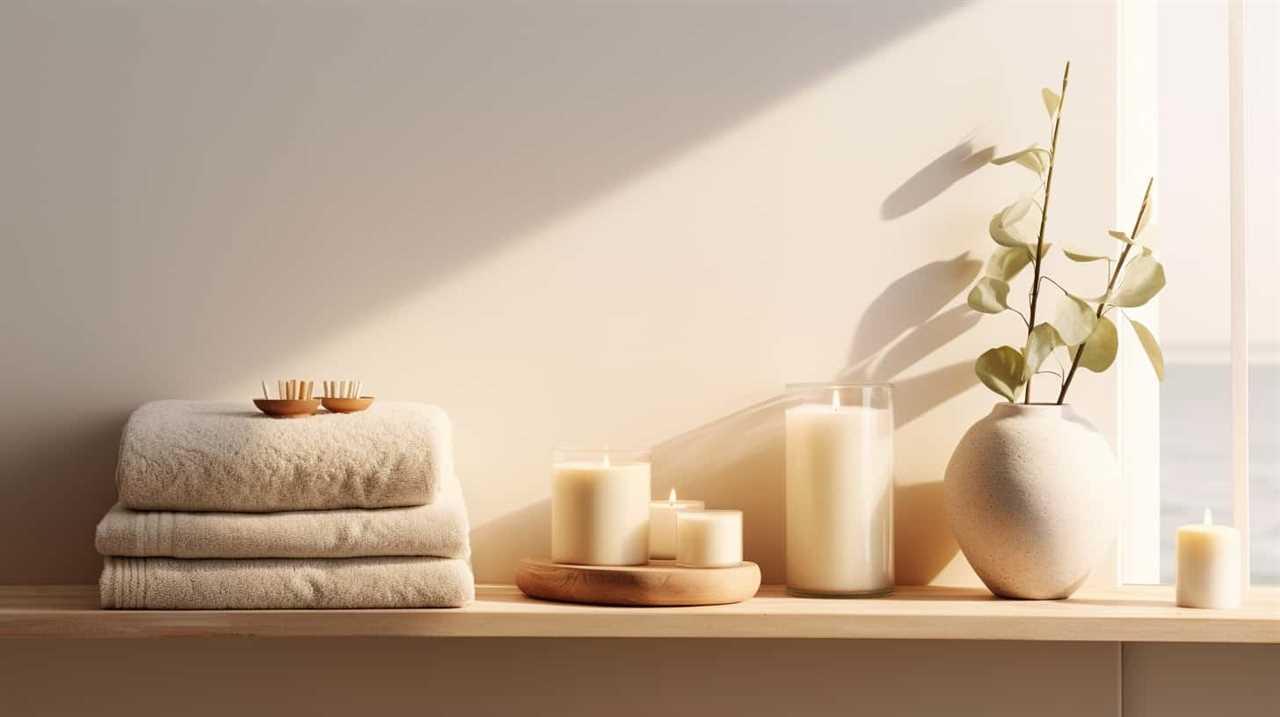
The Kinara holds seven candles, each representing one of the seven principles of Kwanzaa: unity, self-determination, collective work and responsibility, cooperative economics, purpose, creativity, and faith.
The Kinara isn’t only a practical tool for lighting the candles during the Kwanzaa celebration, but it also holds deep cultural significance. It serves as a visual representation of the principles that guide the holiday and a reminder of African heritage and values.
The act of lighting the candles on the Kinara each night of Kwanzaa symbolizes the collective effort to uphold these principles and the commitment to building strong communities.
The origins and cultural significance of the Kwanzaa candle holder, the Kinara, make it an essential element of the Kwanzaa celebration.
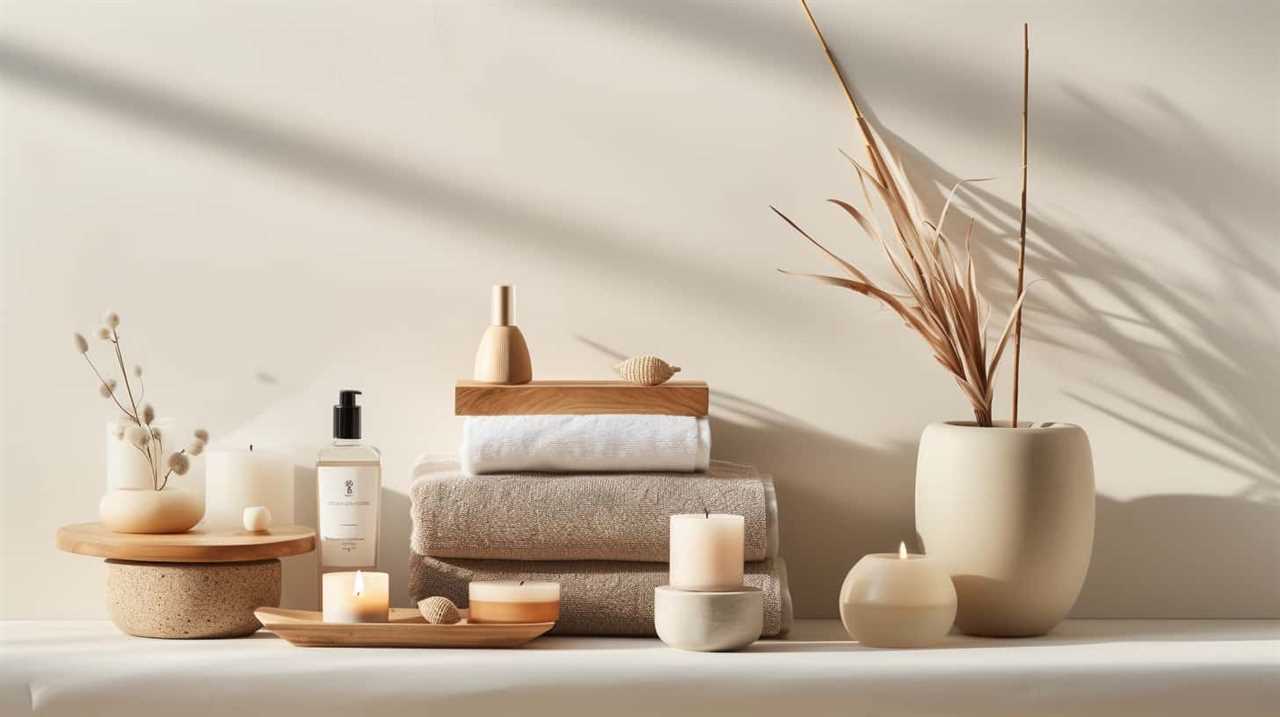
The Significance of the Kwanzaa Candle Holder
The Kwanzaa candle holder, known as the kinara, holds great significance in the celebration of Kwanzaa. It serves as a symbolic representation of unity, with its seven candles representing the Seven Principles of Kwanzaa.
Lighting each candle on its respective day allows individuals to reflect on and embody these principles, fostering a sense of cultural and spiritual importance.
Through the kinara, Kwanzaa participants are able to honor their African heritage and embrace the values that are central to the holiday.
Symbolic Representation of Unity
In our celebration of Kwanzaa, the Kwanzaa candle holder serves as a symbolic representation of unity through its use of a compound preposition.

The symbolism in Kwanzaa candle lighting lies in the seven candles that are placed in the holder, known as the Kinara. Each candle represents one of the seven principles of Kwanzaa, known as the Nguzo Saba, which include unity, self-determination, collective work and responsibility, cooperative economics, purpose, creativity, and faith.
As the candles are lit each night, it signifies the progress and growth of the African American community in upholding these principles.
The cultural significance of the Kwanzaa candle holder lies in its ability to bring families and communities together, fostering a sense of unity and shared values. It serves as a reminder of the importance of collective efforts and the power of unity in building a stronger community.
Lighting the Principles
As we continue exploring the symbolic representation of unity through the Kwanzaa candle holder, it’s important to understand the significance of lighting the principles it represents.
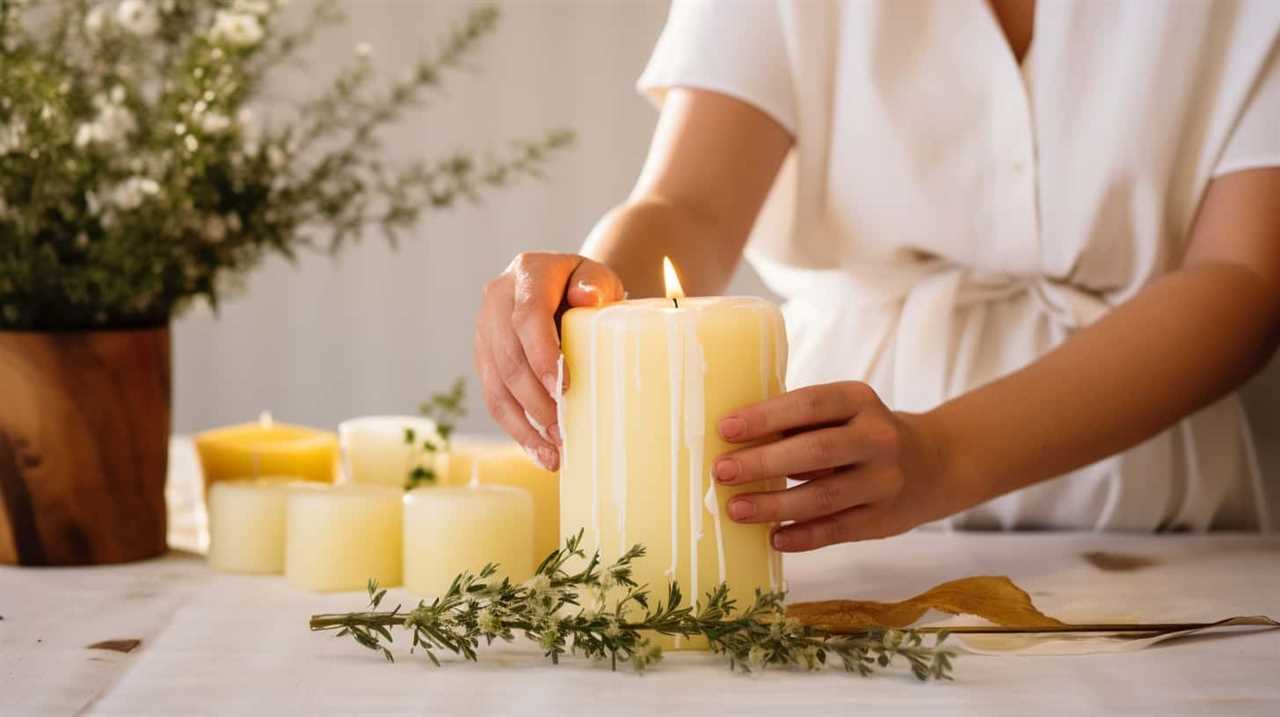
Lighting the principles during Kwanzaa is a powerful ritual that symbolizes the illumination of knowledge and the spreading of positive values within the community. The lighting techniques used vary, but the most common method involves lighting the central black candle, known as the ‘Mishumaa Saba,’ and then using it to light the other candles.
This act not only physically illuminates the principles but also serves as a metaphor for the sharing of knowledge, unity, and collective responsibility.
The cultural significance of lighting the Kwanzaa candle holder lies in its ability to reinforce the principles of Kwanzaa and bring people together in a spirit of unity and purpose. It’s a reminder of the importance of community and the collective effort needed to achieve progress and upliftment.
Cultural and Spiritual Importance
During Kwanzaa, we celebrate the cultural and spiritual importance of the Kwanzaa candle holder by reflecting on its significance in our community.
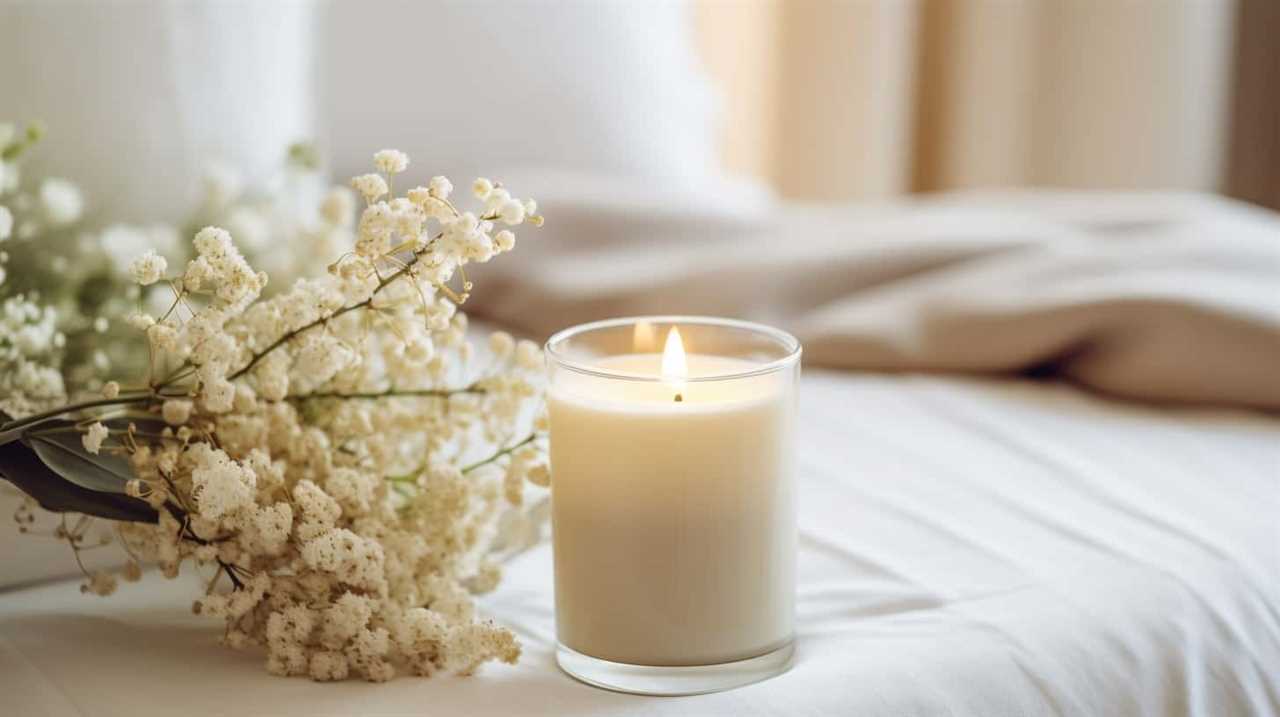
The candle holder, known as the Kinara, holds great significance in our cultural traditions and serves as a symbol of unity, heritage, and faith.
The Kinara is typically made of wood and holds seven candles, representing the Seven Principles of Kwanzaa. Each candle represents one of these principles, such as unity, self-determination, and collective work and responsibility.
As we light each candle throughout the celebration, we’re reminded of the importance of these principles in our lives and in our community.
The Kinara’s spiritual symbolism connects us to our African roots and serves as a reminder of our ancestors’ resilience and wisdom.
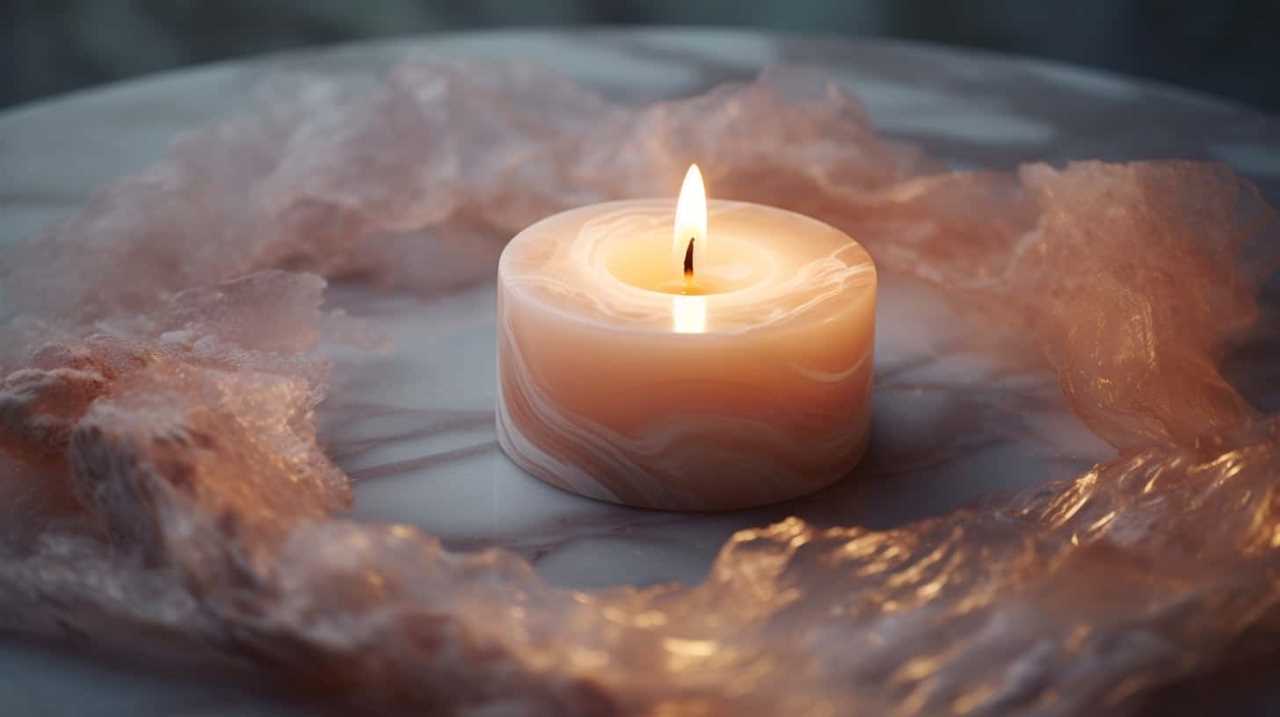
The Traditional Materials Used for Kwanzaa Candle Holders
We typically make Kwanzaa candle holders out of various traditional materials. These materials are carefully chosen for their cultural significance and symbolic representation of the values and principles of Kwanzaa.
One of the most common materials used for making Kwanzaa candle holders is wood. Wood represents the importance of growth and the roots of the African diaspora.
Other traditional materials include clay, which symbolizes the earth and the connection to the land, and metal, which represents strength and resilience.
These materials not only serve as the foundation for the candle holders but also embody the spirit of Kwanzaa itself.
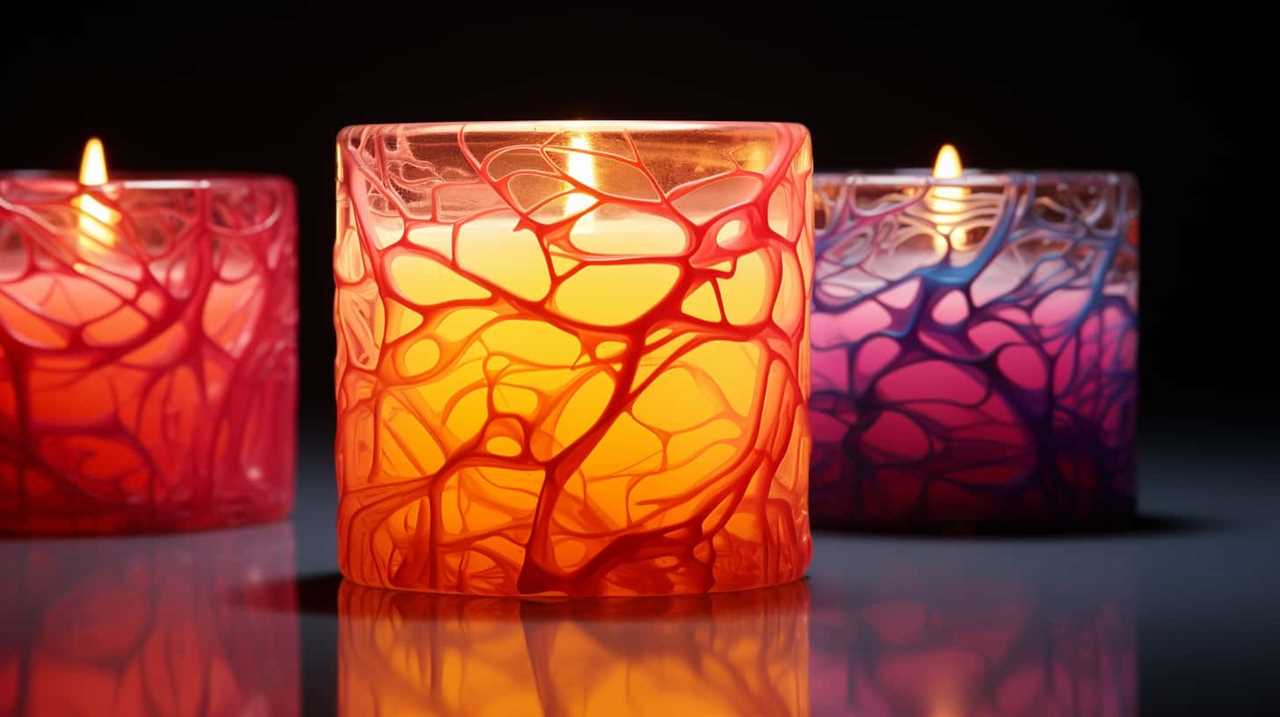
The use of traditional materials in the creation of Kwanzaa candle holders helps to preserve and honor the rich cultural heritage and traditions of African people.
The Symbolism Behind Each Candle on the Kwanzaa Candle Holder
The meaning behind each candle on the Kwanzaa candle holder holds significant symbolism. Lighting the candles during Kwanzaa represents the principles and values celebrated during this cultural holiday.
There are seven candles in total, each representing one of the seven principles of Kwanzaa: unity, self-determination, collective work and responsibility, cooperative economics, purpose, creativity, and faith.
The first candle, located in the center and black in color, represents unity. The three red candles symbolize self-determination, collective work and responsibility, and cooperative economics. The three green candles represent purpose, creativity, and faith.
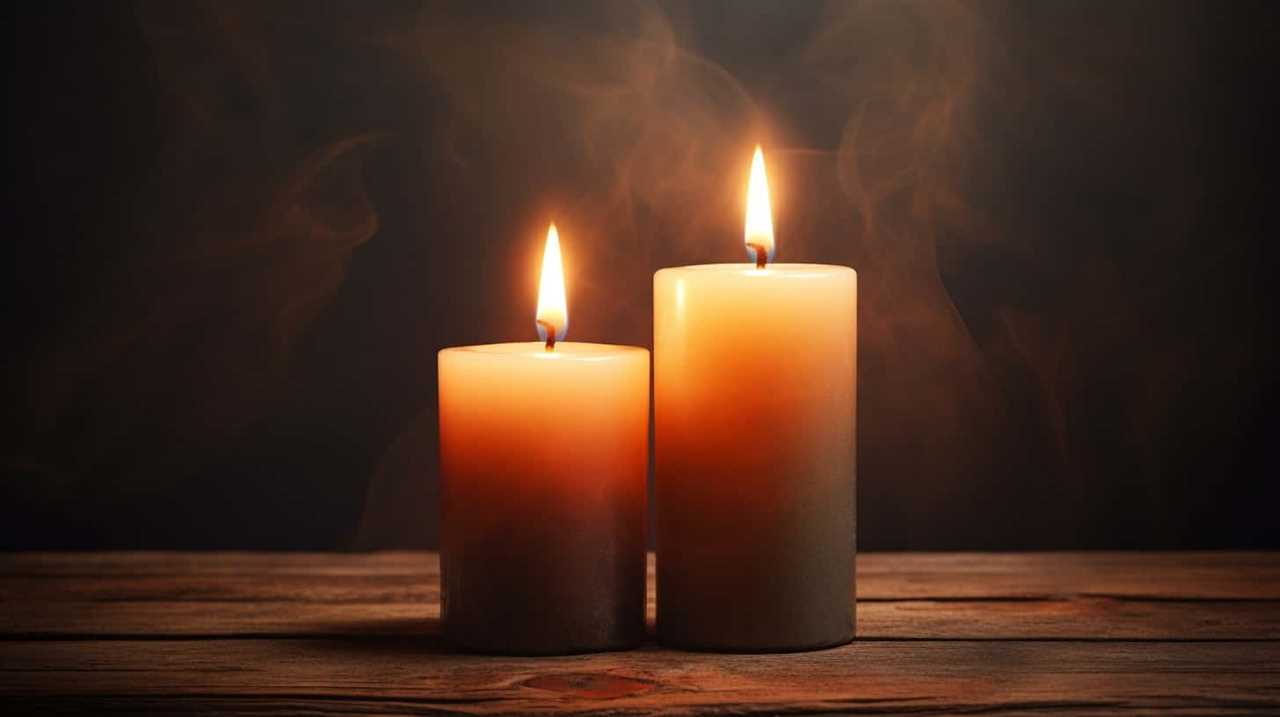
Lighting these candles throughout the seven days of Kwanzaa serves as a reminder of the importance of these principles in building a strong and prosperous community.
This symbolism behind lighting the candles is deeply rooted in African cultural traditions and serves as a way to honor and celebrate African heritage.
The Role of the Kwanzaa Candle Holder in the Kwanzaa Celebration
The Kwanzaa candle holder, also known as the kinara, plays a significant role in the Kwanzaa celebration. It serves as a central symbol of unity and collective purpose.
The traditional design variations of the kinara reflect the diverse cultural heritage of African people, highlighting the principles and values of Kwanzaa.
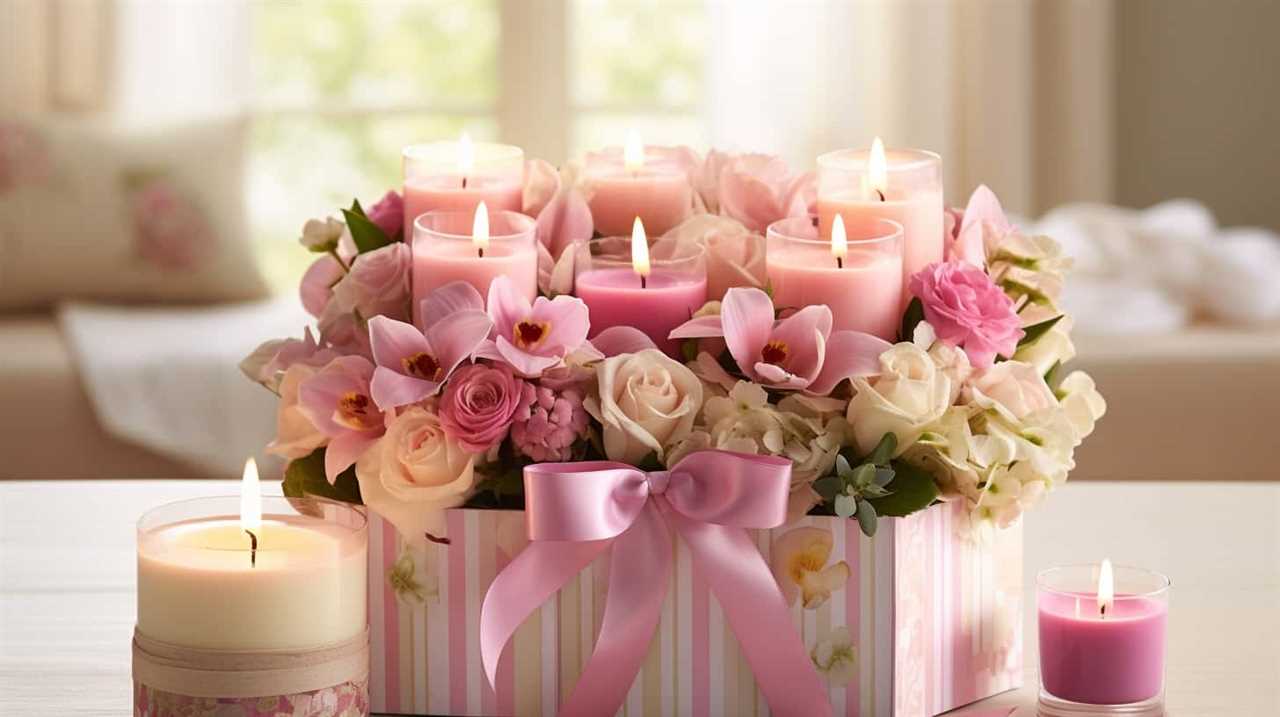
During the lighting ceremony, each candle represents one of the seven principles of Kwanzaa, and the kinara serves as a visual reminder of the importance of these principles in daily life.
Symbolic Significance of Holder
During Kwanzaa, the candle holder known as a kinara plays a vital role in our celebration, symbolizing the principles and values we honor as a community.
The kinara serves as a symbolic representation of African culture and heritage, reflecting the cultural significance of Kwanzaa itself.
The kinara typically consists of seven candle holders, each representing one of the seven principles of Kwanzaa. These principles, known as the Nguzo Saba, include unity, self-determination, collective work and responsibility, cooperative economics, purpose, creativity, and faith.
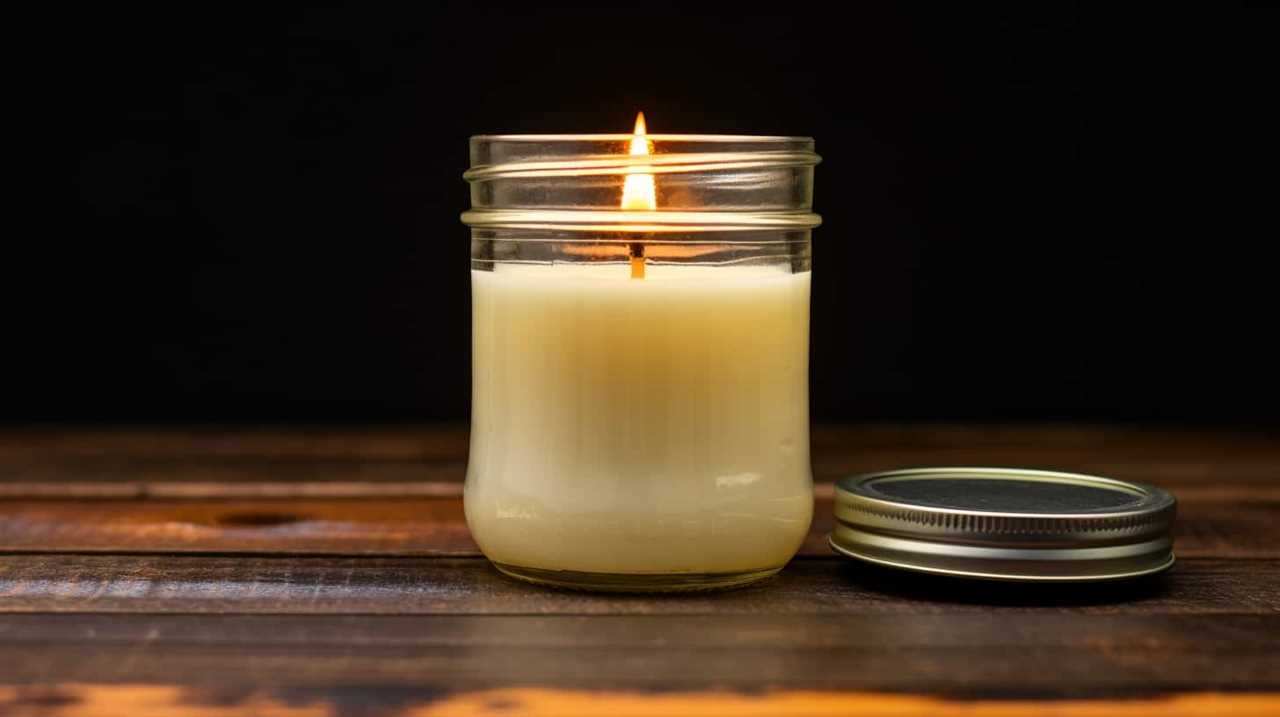
Each candle is lit on a specific day of the celebration, with the center candle, known as the ‘Mishumaa Saba,’ representing the African people and their shared ancestry.
The kinara, therefore, serves as a visual reminder of the values and ideals that unite us as a community.
As we explore traditional design variations of the kinara, we further appreciate the rich diversity and artistic expressions within our African heritage.
Traditional Design Variations
As we explore the traditional design variations of the kinara, we gain a deeper understanding of its role in the Kwanzaa celebration. The kinara, or Kwanzaa candle holder, holds great cultural significance and embodies the principles and values of Kwanzaa.
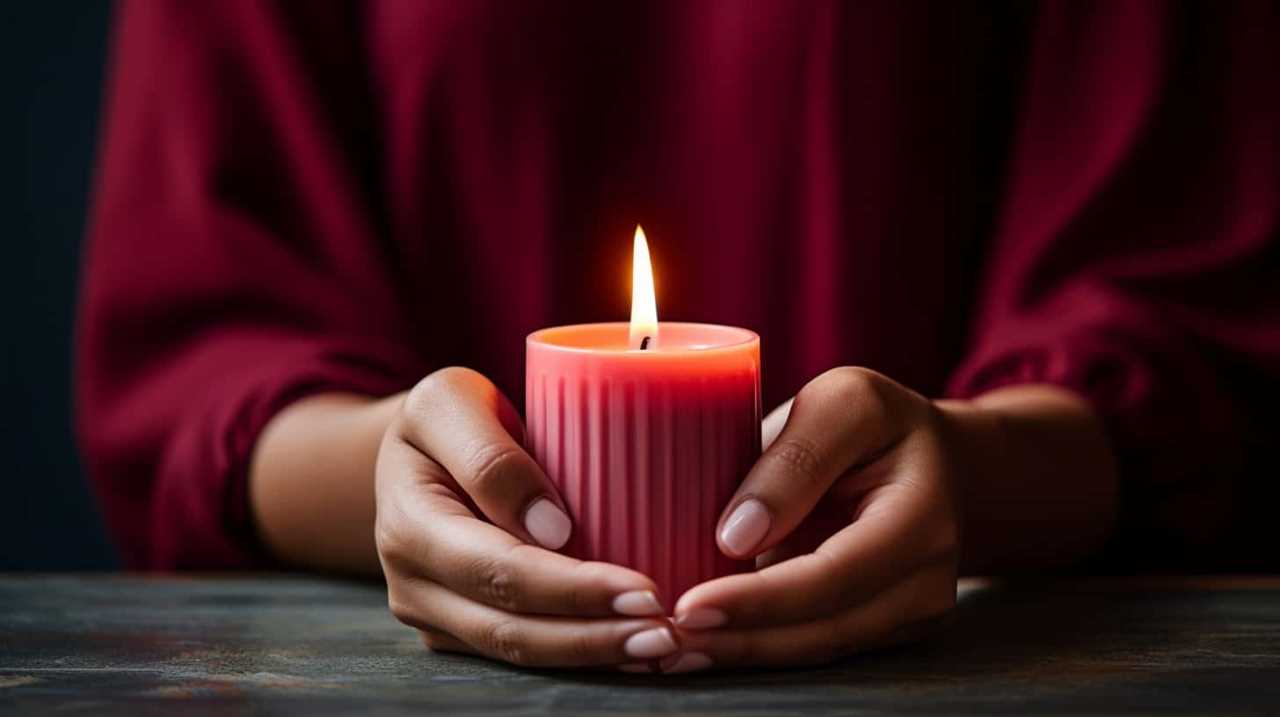
Here are three traditional design variations of the kinara:
- Material: Kinara is typically made from wood, symbolizing the importance of nature and the earth in African culture. Different types of wood, such as mahogany or ebony, may be used to create unique and intricate designs.
- Shape: The shape of the kinara can vary, but it commonly consists of a long rectangular base with seven candle holders. Some designs may incorporate curves or African-inspired motifs, representing the diversity and richness of African heritage.
- Symbolism: Each candle holder on the kinara represents one of the seven principles of Kwanzaa. The central black candle represents unity, surrounded by three red candles symbolizing self-determination, cooperative economics, and creativity, and three green candles representing collective work and responsibility, purpose, and faith.
Through these traditional designs, the kinara serves as a visual representation of the principles and cultural significance of Kwanzaa, fostering unity, self-reflection, and community building.
Lighting Ceremony Traditions
While lighting the candles, we honor the role of the Kwanzaa candle holder in the Kwanzaa celebration. The lighting ceremony symbolism holds deep cultural and spiritual significance.
The Kwanzaa candle holder, also known as the kinara, is a central element in the celebration. It typically consists of seven candle holders, representing the seven principles of Kwanzaa, called the Nguzo Saba. Each candle represents one of these principles: Umoja (unity), Kujichagulia (self-determination), Ujima (collective work and responsibility), Ujamaa (cooperative economics), Nia (purpose), Kuumba (creativity), and Imani (faith).
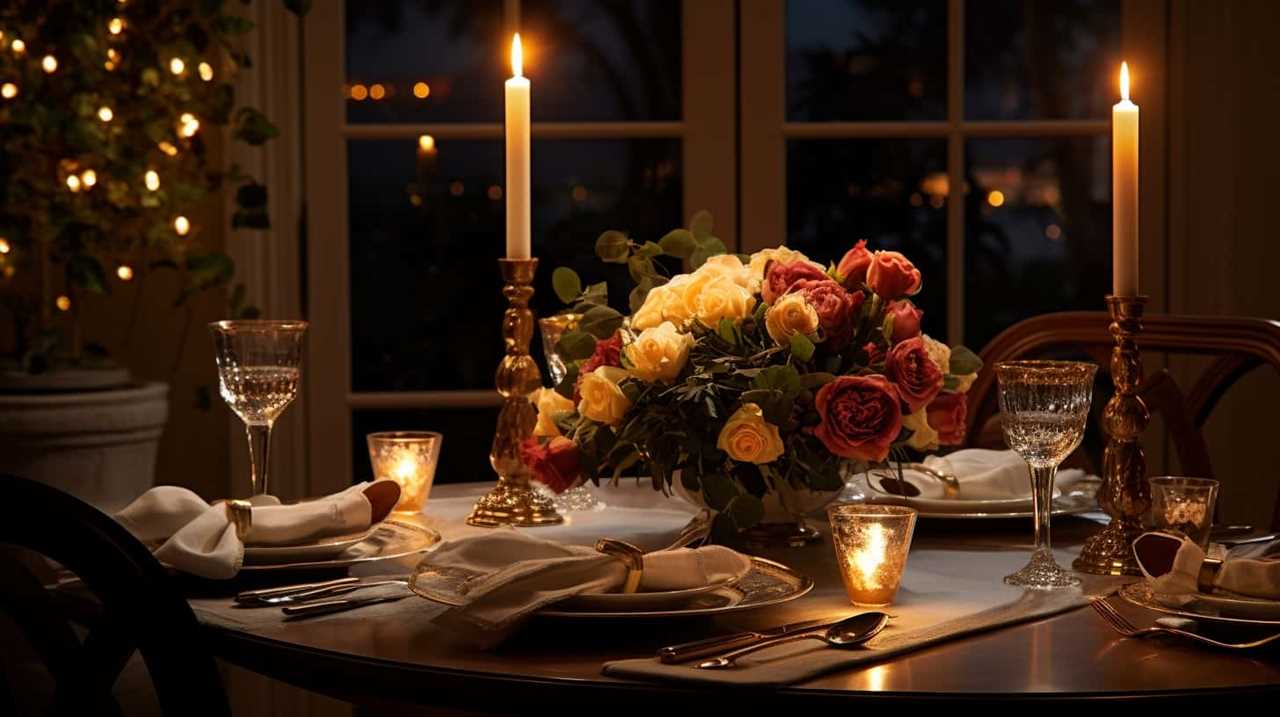
The kinara serves as a visual reminder of the importance of these principles in our lives and in the community. As we light each candle, we’re reminded to reflect on these principles and strive to incorporate them into our daily lives.
The Kwanzaa candle holder plays a vital role in emphasizing the values and principles that Kwanzaa represents.
Different Styles and Designs of Kwanzaa Candle Holders
We have observed various styles and designs of Kwanzaa candle holders, each uniquely crafted to symbolize the principles and values of the holiday. These candle holders aren’t only functional but also hold cultural significance, reflecting the rich traditions of Kwanzaa.
Here are three different styles and designs of Kwanzaa candle holders:
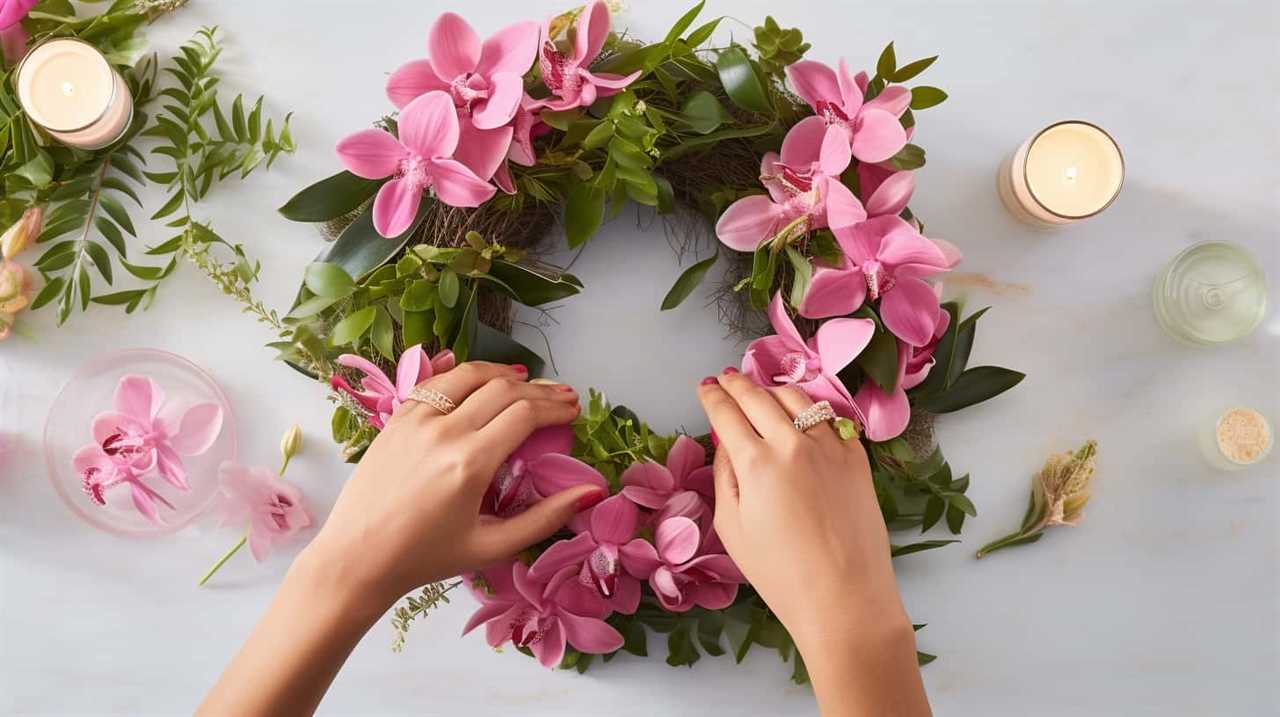
- Kinara: The most common type of Kwanzaa candle holder is the kinara, which typically holds seven candles. It’s often made from wood, symbolizing the African roots of the holiday. The seven candles represent the seven principles of Kwanzaa, known as the Nguzo Saba.
- Handcrafted ceramics: Another popular style of Kwanzaa candle holder is made from handcrafted ceramics. These pieces are often adorned with colorful African-inspired patterns and motifs, celebrating African heritage and craftsmanship.
- Metalwork: Kwanzaa candle holders made from metalwork, such as brass or copper, are also prevalent. These pieces showcase intricate designs and symbols, reflecting the importance of unity and community in Kwanzaa celebrations.
These diverse styles and designs of Kwanzaa candle holders allow individuals to express their cultural identity and celebrate the values of Kwanzaa in a meaningful way.
How to Make Your Own Kwanzaa Candle Holder
To create your own Kwanzaa candle holder, you can start by gathering the necessary materials and following these step-by-step instructions.
Making a DIY candle holder for Kwanzaa is a meaningful way to celebrate the holiday and honor its principles.
Here’s what you’ll need: a wooden block, sandpaper, acrylic paint in the colors of Kwanzaa (red, black, and green), paintbrushes, a ruler, and 7 candle holders.
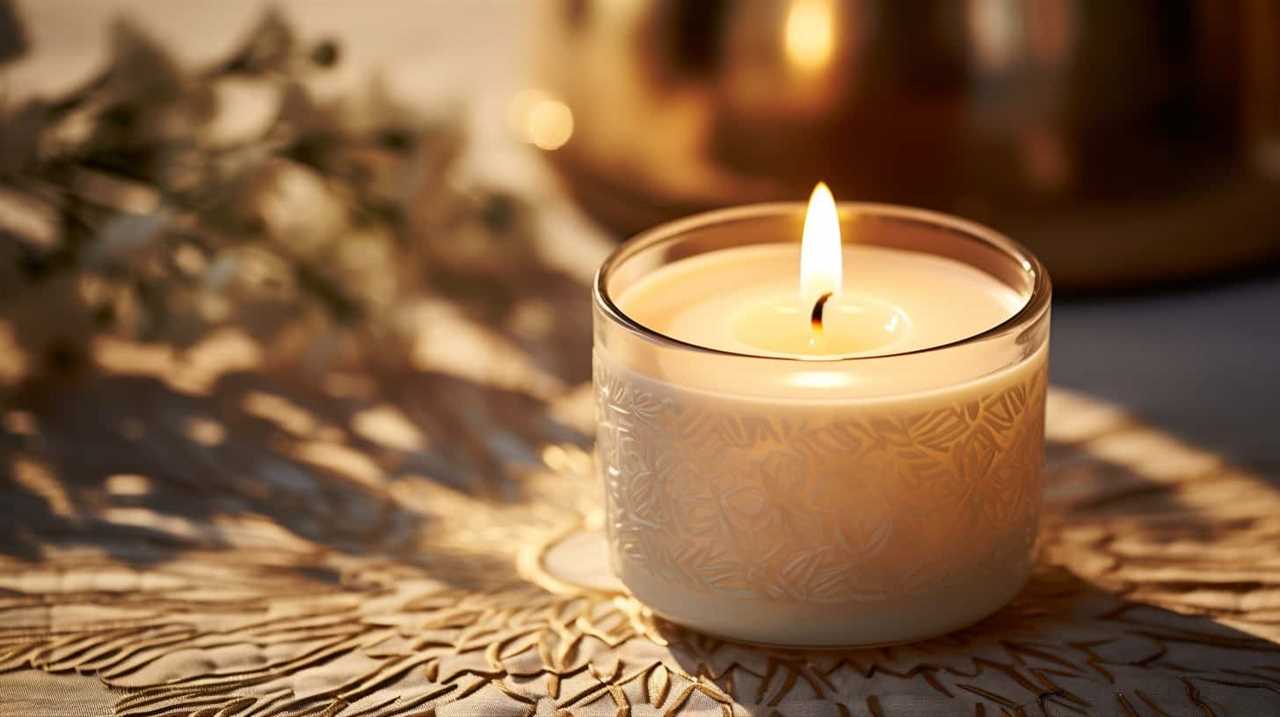
Start by sanding the wooden block to create a smooth surface.
Next, use the ruler to measure and mark the placement of the candle holders evenly across the block.
Then, paint the block with the Kwanzaa colors, using a different color for each side.
Allow the paint to dry before attaching the candle holders to the marked spots.
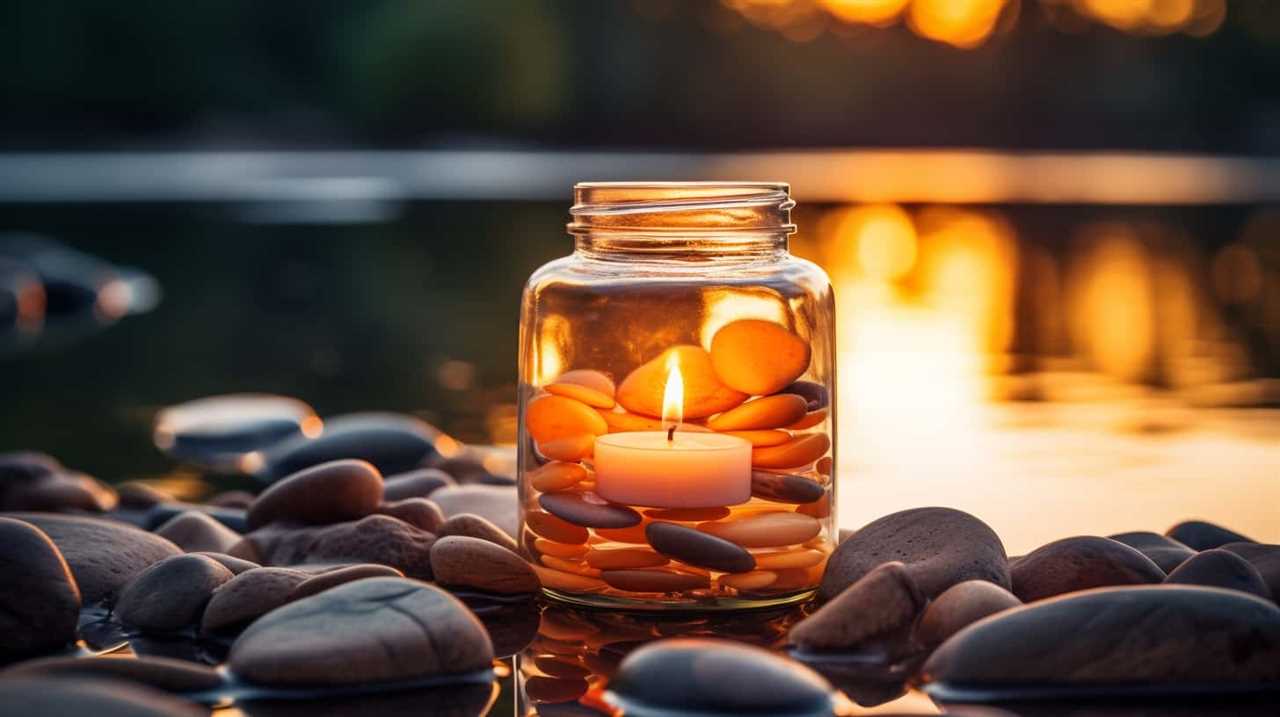
Once the candle holders are securely in place, your DIY Kwanzaa candle holder is ready to be used during the celebration.
Remember to light each candle on its corresponding day to honor the principles of Kwanzaa.
The Names and Meanings of the Seven Candles on the Kwanzaa Candle Holder
Continuing from the previous subtopic, let’s explore the names and meanings of the seven candles on the Kwanzaa candle holder.
The candles hold deep symbolic meanings and cultural significance in the celebration of Kwanzaa.
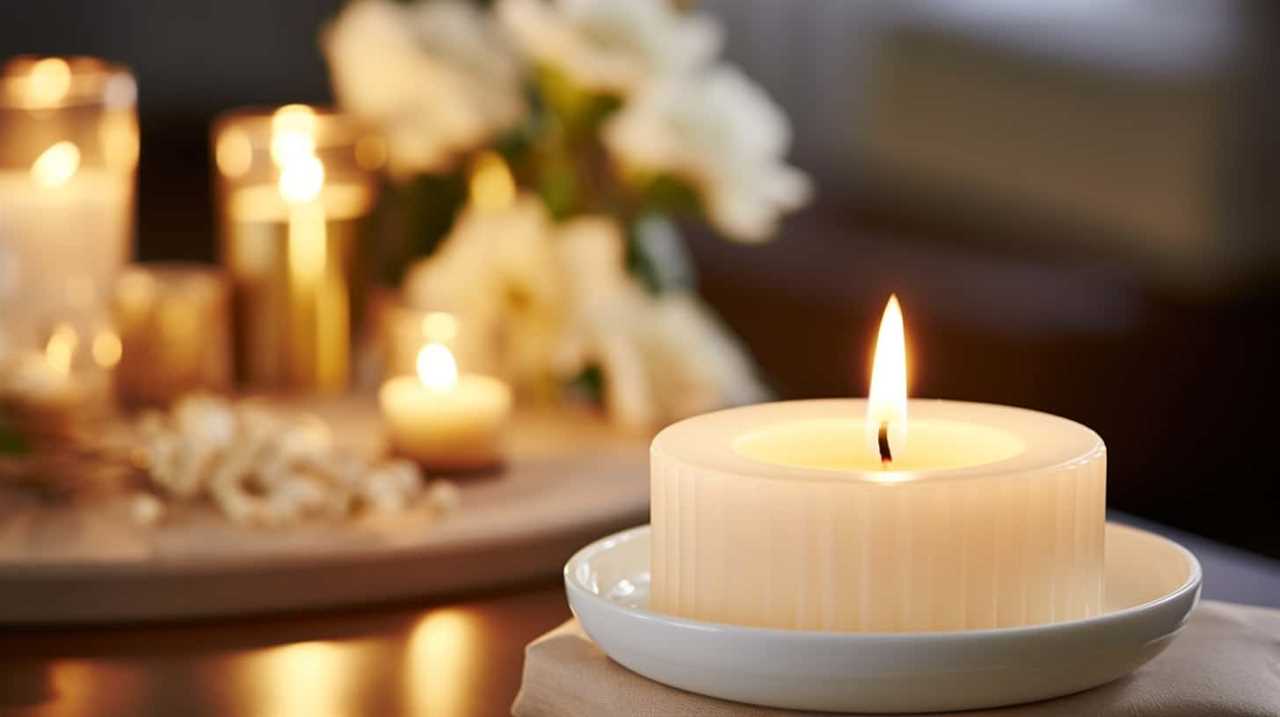
- Mishumaa Saba: This is the central candle, also known as the Unity Candle. It represents the unity and collective work of the African American community.
- Kinara: The Kinara is the candle holder that holds the seven candles. It symbolizes the ancestral roots and heritage of African Americans.
- Nguzo Saba: The seven candles on the Kinara are collectively known as the Nguzo Saba, which means the Seven Principles in Swahili. Each candle represents one of the seven principles of Kwanzaa: Umoja (Unity), Kujichagulia (Self-determination), Ujima (Collective work and responsibility), Ujamaa (Cooperative economics), Nia (Purpose), Kuumba (Creativity), and Imani (Faith).
These candles, with their symbolic meanings and cultural significance, serve as a reminder of the values and principles that guide the African American community during the celebration of Kwanzaa.
The Importance of Lighting the Candles in a Specific Order
When it comes to lighting the candles on a Kwanzaa candle holder, the specific order holds great symbolic meaning and ritual significance. Each candle represents one of the seven principles of Kwanzaa, and the order in which they’re lit reflects the journey of the celebration.
Understanding the importance of lighting the candles in a specific order helps to deepen our understanding of the values and principles that Kwanzaa seeks to promote.
Symbolic Meaning Behind Order
We light the candles on a Kwanzaa candle holder in a specific order to symbolize the values and principles of the holiday. This symbolic order holds cultural significance and serves as a powerful reminder of the importance of community and unity.

- The First Candle: The black candle, known as the ‘Umoja’ candle, is lit on the first day of Kwanzaa. It represents unity and reminds us of the collective responsibility we’ve towards one another.
- The Second Candle: The red candle, also known as the ‘Kujichagulia’ candle, is lit on the second day. It symbolizes self-determination, encouraging individuals to define and shape their own destinies.
- The Third Candle: The green candle, called the ‘Ujima’ candle, is lit on the third day. It signifies collective work and responsibility, reminding us of the importance of coming together to build and uplift our communities.
Ritual Significance of Sequence
Highlighting the significance of lighting the candles in a specific order, the ritual sequence holds profound meaning in the celebration of Kwanzaa.
The specific order in which the candles are lit is an essential part of the Kwanzaa ritual practices and has deep cultural significance.
Each of the seven candles represents one of the seven principles of Kwanzaa, known as the Nguzo Saba. These principles include unity, self-determination, collective work and responsibility, cooperative economics, purpose, creativity, and faith.
The lighting of the candles in a specific order symbolizes the progressive growth and development of these principles throughout the week-long celebration.
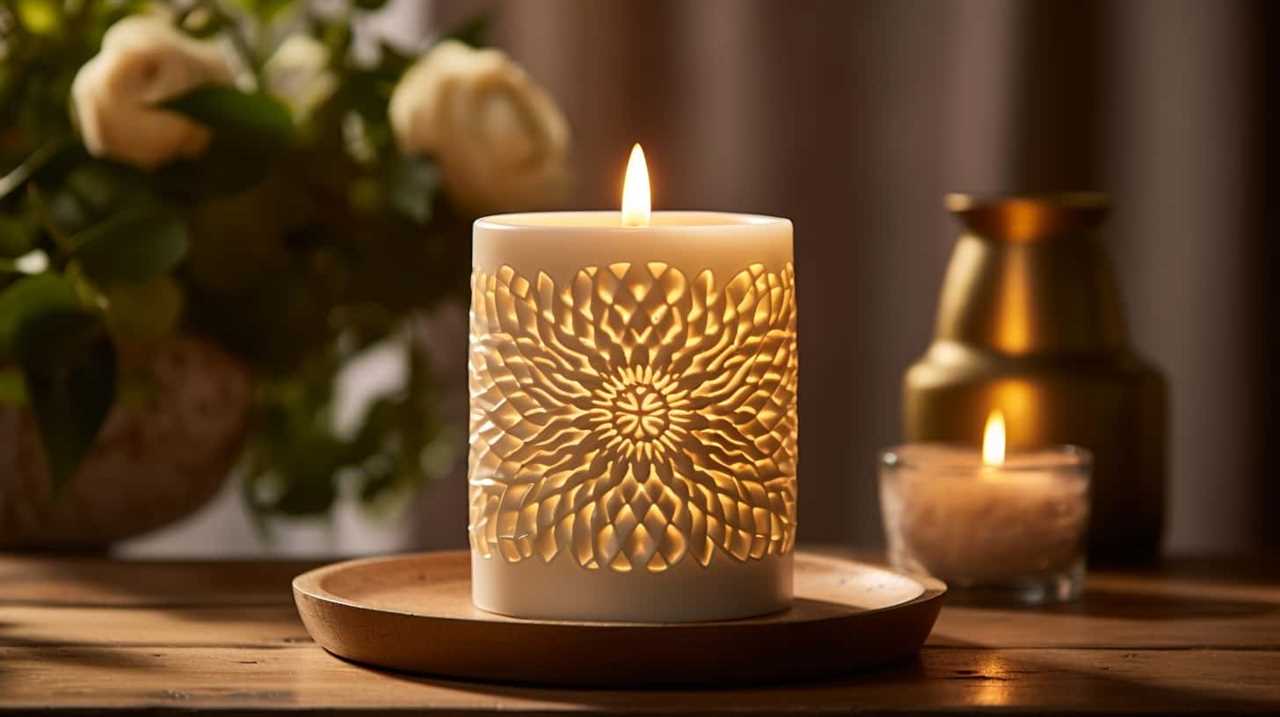
How to Properly Display and Arrange the Kwanzaa Candle Holder
How can we effectively showcase and arrange the Kwanzaa candle holder? Proper display techniques not only highlight the cultural significance of the candle holder but also create an inviting and meaningful atmosphere for celebrating Kwanzaa. Here are three key considerations:
- Placement:
Position the Kwanzaa candle holder, known as a kinara, on a central location such as a table or a mantel. This allows for easy visibility and ensures that it becomes the focal point of the celebration. - Lighting:
Light the candles in the kinara from left to right, starting with the black candle in the center. This symbolizes the seven principles of Kwanzaa, with each candle representing a different principle. Keep the candles lit during the entire week of Kwanzaa. - Decorations:
Enhance the display by incorporating traditional African fabrics, symbols, and colors. Adorn the surrounding area with African artwork, baskets, or fruits to further honor and embrace African heritage.
Where to Find and Purchase a Kwanzaa Candle Holder
To find and purchase a Kwanzaa candle holder, start by exploring local African markets or online retailers specializing in cultural and holiday decor. These markets and online retailers often offer a wide range of traditional Kwanzaa items, including candle holders.
Additionally, consider visiting local African craft fairs or cultural events, where you may find unique and handmade candle holders.
When searching online, use keywords such as ‘Kwanzaa candle holder’ or ‘Kwanzaa candle holder where to buy’ to narrow your search and find reputable sellers. It’s important to ensure that the candle holder you choose is authentic and represents the values and principles of Kwanzaa.
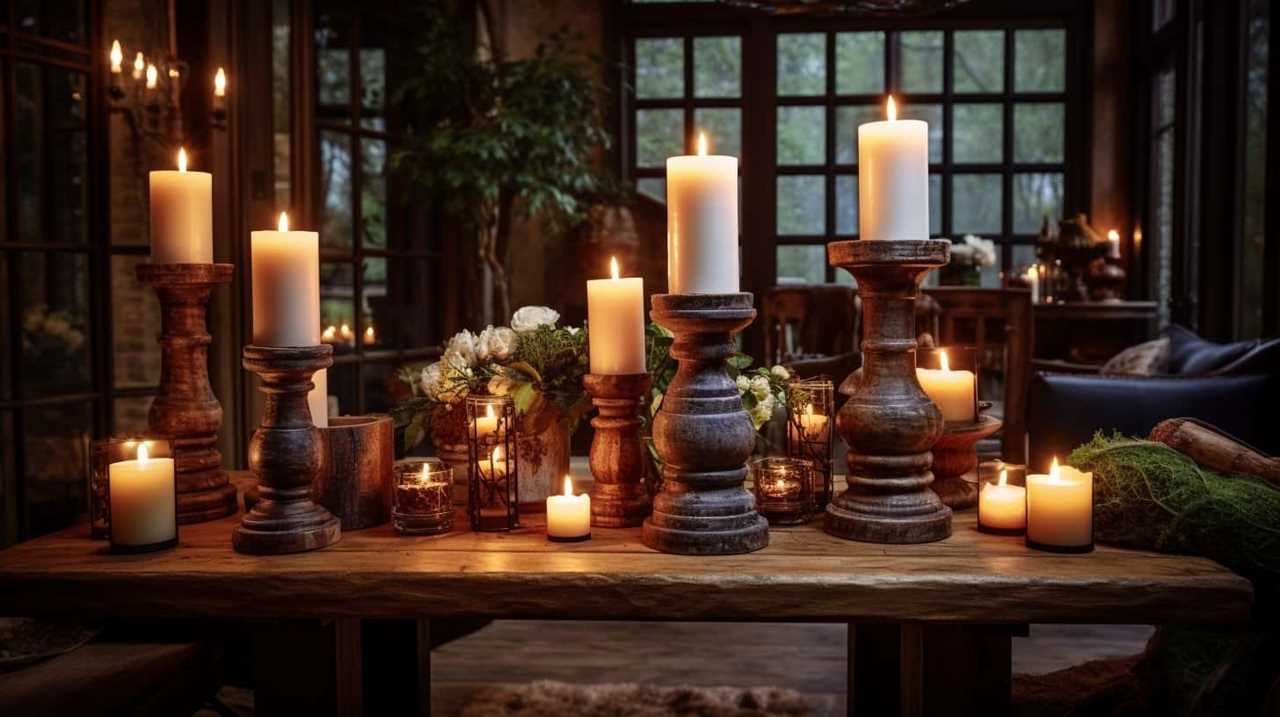
Take the time to read reviews and compare prices before making a purchase. By supporting local businesses or online retailers specializing in cultural items, you can serve both your own needs and contribute to the preservation of cultural traditions.
Frequently Asked Questions
Can I Use Any Type of Candle Holder for Kwanzaa, or Does It Have to Be Specifically Designed for the Celebration?
For Kwanzaa, it is important to have a candle holder specifically designed for the celebration. While there may be alternative options, the traditional candle holder, called a kinara, holds great significance in the placement of the candles.
Are There Any Specific Colors or Patterns That Are Traditionally Used for Kwanzaa Candle Holders?
Traditional colors and patterns for Kwanzaa candle holders vary, but they often incorporate the symbolic colors of Kwanzaa: red, black, and green. However, individuals are free to customize their candle holders to reflect their personal style and preferences.
Can I Use Electronic or Battery-Operated Candles Instead of Traditional Candles for the Kwanzaa Candle Holder?
Yes, you can use battery-operated candles instead of traditional candles for the Kwanzaa candle holder. This allows for a safer and more convenient option, while still maintaining the symbolic significance of the candles.
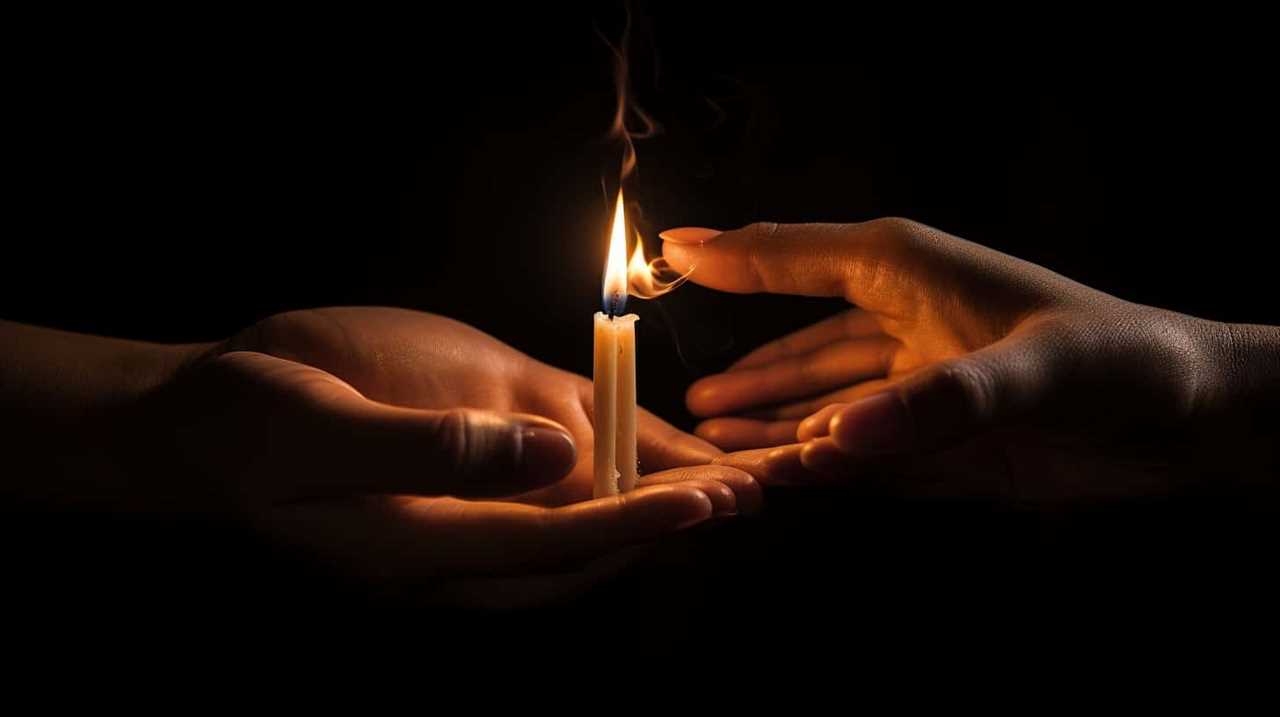
How Long Should the Candles Burn Each Day During the Kwanzaa Celebration?
During the Kwanzaa celebration, the candles symbolize the principles of Kwanzaa. Each candle represents one of the seven principles and is lit every day. Children can participate by helping to light the candles each day.
Are There Any Specific Safety Precautions I Should Take When Using a Kwanzaa Candle Holder?
When using a Kwanzaa candle holder, it is important to observe safety precautions. Alternatives to traditional candle holders include electric ones or placing the candles in a fireproof container.
Conclusion
In conclusion, the Kwanzaa candle holder, also known as a kinara, is a significant symbol in the celebration of Kwanzaa. It holds seven candles, each representing a principle of the holiday.
One interesting statistic is that over the years, the popularity of Kwanzaa and the use of kinara have been steadily increasing, with more people embracing and practicing this cultural tradition.
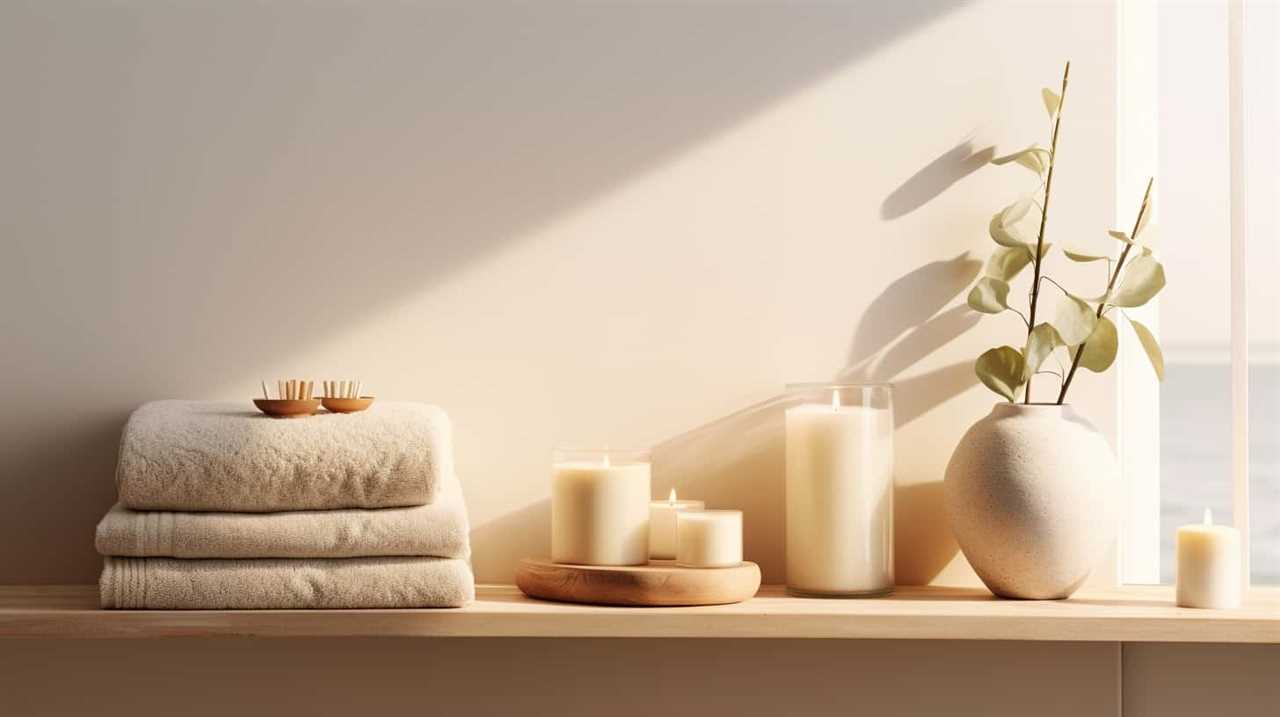
This shows the enduring relevance and importance of Kwanzaa in celebrating African-American heritage and values.
I’m Jane and I love candles. I have candles everywhere in my house–in every room, on every surface. I love the smell of candles, and I love how they make my place feel warm and cozy.
Candles are really important to me. They help me relax and de-stress after a long day. They remind me of happy memories, and they make me feel calm and peaceful. I can’t imagine my life without candles!
Candles
What Happens When a Candle Burns All the Way Down

Have you ever wondered what happens when a candle completely melts? There’s a popular saying that goes, ‘All good things must come to an end.’ So, my dear friends, come along as we delve into the fascinating mysteries surrounding this captivating phenomenon.
In this brief exploration, we will delve into the chemistry behind candle burning, the role of the wick, and the mesmerizing dance of ignition and combustion. We will witness the creation of heat and light, the formation of candle tunnels, and the eventual end of the wick.
Finally, we will discuss the extinguishing of the flame and the aftermath, including clean up and safety precautions. So, grab your serving spirit and let’s discover the wonders that lie within a burning candle.
Key Takeaways
- Candle burning involves a series of chemical reactions, with wax being the primary fuel source.
- The wick plays a crucial role in drawing up the liquid wax, determining the height and brightness of the flame, and regulating the amount of oxygen reaching the flame.
- The ignition temperature of a candle is the temperature at which the wax vaporizes, leading to combustion and the production of heat, light, carbon dioxide, and water vapor.
- Candle burning can impact indoor air quality through the release of carbon dioxide and the formation of soot, which can contribute to air pollution and respiratory issues.
The Chemistry of Candle Burning
When a candle burns all the way down, it’s fascinating to understand the chemistry behind its combustion. Candle burning involves a series of chemical reactions that result in the release of heat and light.
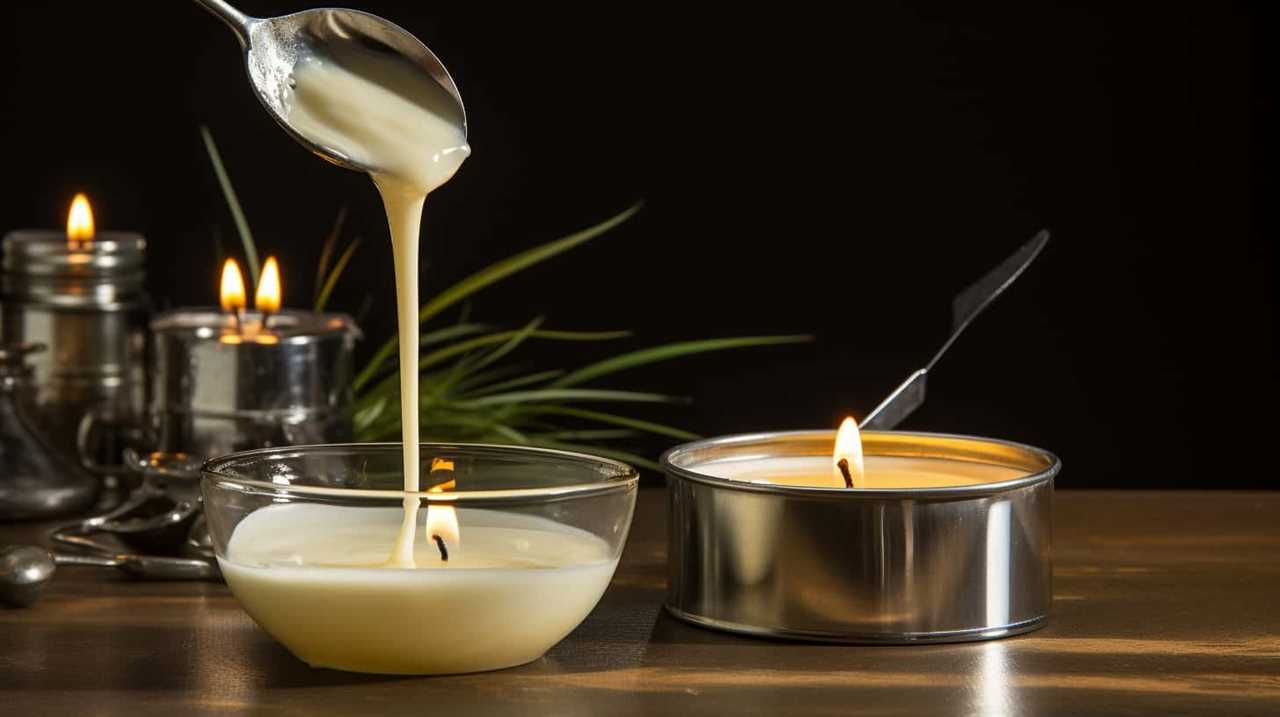
The primary fuel source in a candle is the wax, which is typically made from hydrocarbons like paraffin. As the candle burns, the heat from the flame melts the wax near the wick, turning it into a liquid. This liquid wax is drawn up the wick through capillary action, where it’s vaporized by the heat of the flame.
The vaporized wax then undergoes combustion, combining with oxygen from the air to produce carbon dioxide, water vapor, and heat. This heat production is what allows candles to provide both illumination and warmth.
Understanding the chemistry of candle burning can help us appreciate the beauty and usefulness of these simple yet powerful sources of light and heat.
The Components of a Candle
To fully understand the chemistry of candle burning, we need to explore the components that make up a candle. Candle manufacturing involves carefully selecting and combining various materials to create a functional and aesthetically pleasing product.
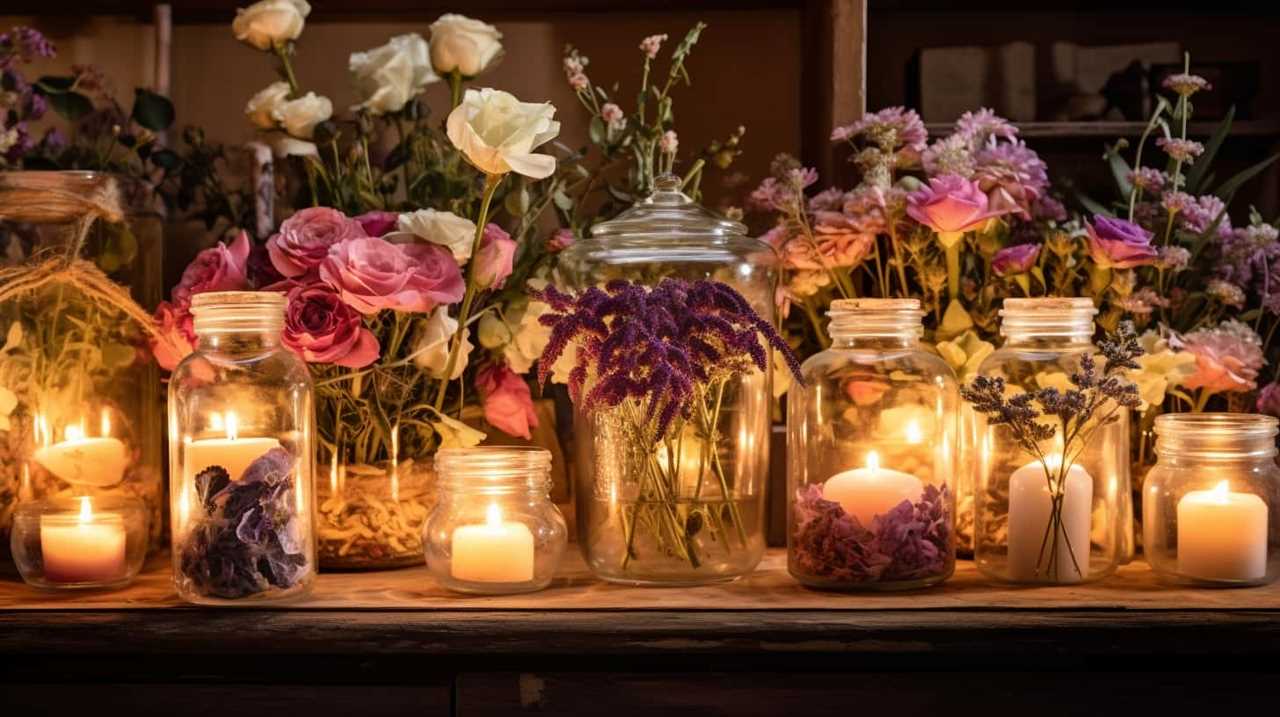
The main components of a candle include:
- Wax: The primary fuel source of a candle, wax can be made from different materials such as beeswax, soy wax, or paraffin. It’s selected based on factors like burn time and scent throw.
- Wick: The wick is responsible for drawing up the liquid wax and vaporizing it, creating the flame. It’s usually made from braided cotton or linen.
- Wick sustainer: This small metal piece secures the wick to the bottom of the candle, providing stability and preventing it from falling over.
- Additives: Candle manufacturers often add additives like colorants and fragrances to enhance the visual appeal and scent of the candle.
When a candle burns, the wax melts and is drawn up the wick, where it vaporizes and reacts with oxygen, producing heat and light. The burning temperature depends on the type of wax used, with different waxes having different melting and burning points. Understanding these components is crucial in comprehending the science behind candle burning.
The Role of the Wick
The wick plays a crucial role in the burning mechanism of a candle. As the flame ignites the wick, it draws up the liquid wax through capillary action, where it’s vaporized and then burned.
The composition and size of the wick also affect the height, brightness, and stability of the flame.
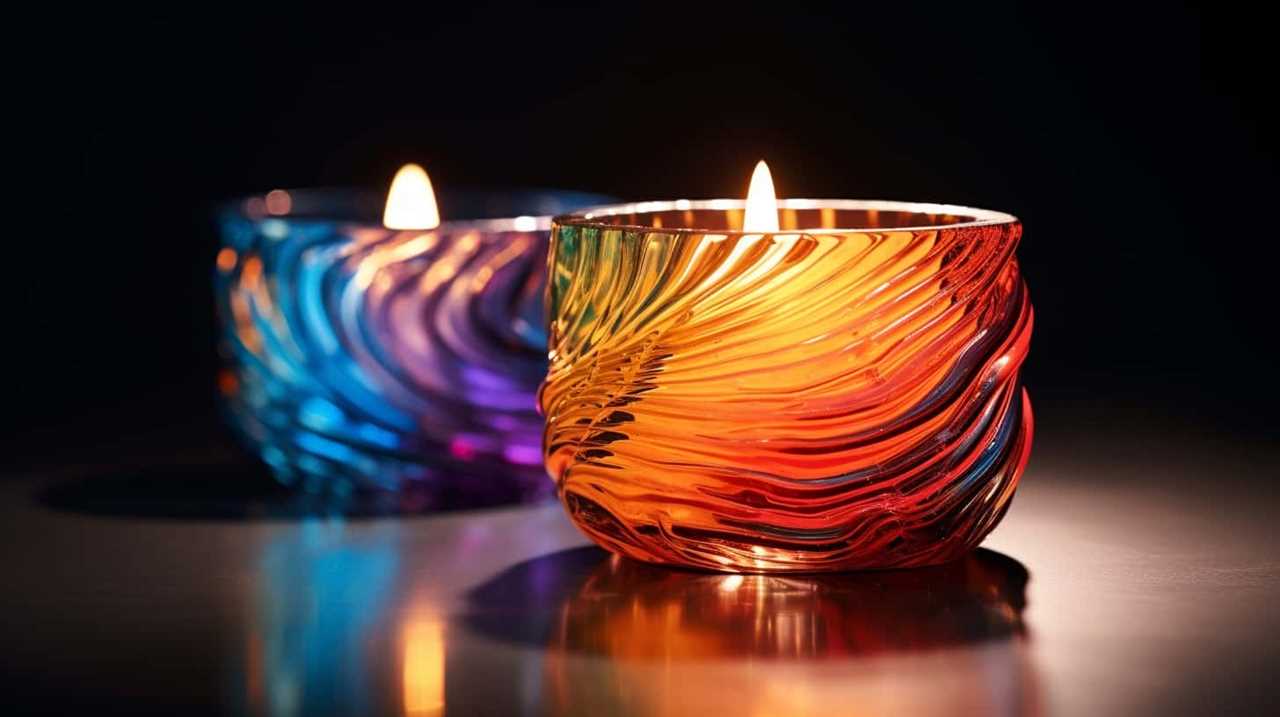
Wick’s Burning Mechanism
We play a crucial role in the burning mechanism of a candle wick. As the wick burns, it draws liquid wax up to its tip through capillary action. This liquid wax is then vaporized and reacts with oxygen in the air, creating a flame. Our role in this process is twofold:
- Wick’s effect on flame height:
- We determine the height of the flame by controlling the rate at which liquid wax is drawn up the wick. A longer wick will draw up more liquid wax, resulting in a taller flame.
- We also help regulate the amount of oxygen reaching the flame, which influences its size and intensity.
- Wick’s role in candle tunneling:
- By burning evenly and consistently, we prevent the formation of a tunnel-like cavity in the center of the candle, known as tunneling. This ensures that the entire candle burns efficiently and evenly.
Understanding our role in the burning mechanism of a candle wick allows us to appreciate the importance of maintaining a properly trimmed wick to ensure an optimal burning experience. In the next section, we’ll explore the impact of the wick on the flame itself.
Wick’s Impact on Flame
As the wick burns, we play a vital role in determining the size and intensity of the flame. But our impact goes beyond just the visual aspect of the flame. The wick’s design and composition can also affect the fragrance and burn time of the candle.
The wick’s effect on candle fragrance is often overlooked, but it’s an important factor to consider. A properly chosen wick can help disperse the fragrance evenly, ensuring that the scent is released consistently throughout the candle’s burn time. On the other hand, a poorly chosen wick may not distribute the fragrance effectively, resulting in a weaker scent experience.
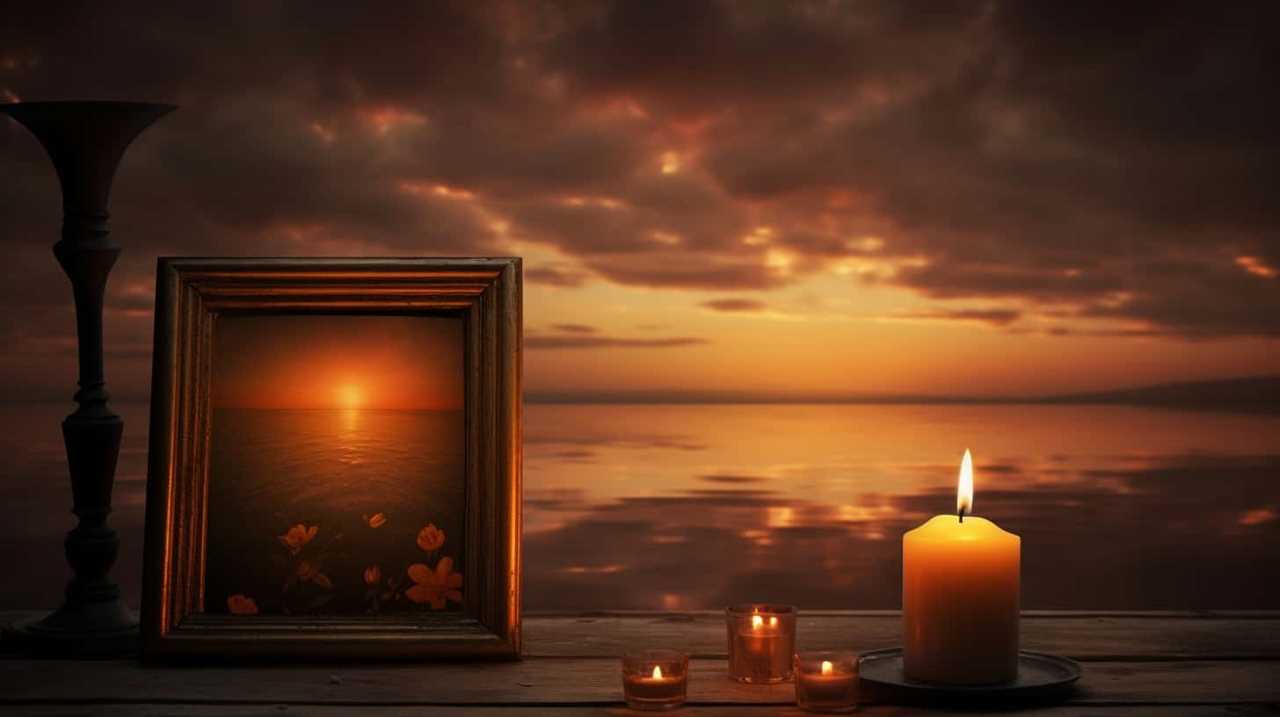
Additionally, the wick’s impact on candle burn time is significant. A wick that’s too small or too large can affect the rate at which the wax is consumed. A small wick may result in a longer burn time, but it could also create a smaller and weaker flame. Conversely, a large wick may produce a bigger and brighter flame, but it may cause the candle to burn faster, shortening its overall lifespan.
The Ignition and Combustion Process
When a candle burns all the way down, we witness an intriguing process of ignition and combustion. Here is a brief explanation of this process:
- Ignition Temperature:
- The ignition temperature is the minimum temperature required to initiate the combustion of a substance. In the case of a candle, it’s the temperature at which the wax vaporizes and mixes with oxygen from the air, creating a flammable mixture that can be ignited.
- The ignition temperature of different candle waxes may vary, but it’s typically around 200-250 degrees Celsius.
- Combustion Products:
- During the combustion process, the candle wax reacts with oxygen, producing carbon dioxide, water vapor, and other byproducts.
- The carbon particles in the flame emit visible light, giving us the characteristic glow of a burning candle.
Understanding the ignition and combustion process helps us appreciate the science behind a candle’s transformation. Now, let’s delve into the next section and explore the production of heat and light.
The Production of Heat and Light
During the combustion process, a candle produces heat and light. This production process is a result of the chemical reaction between the wax and the flame.

As the flame ignites the wick, the heat melts the wax near the wick, creating a liquid pool. This liquid wax is drawn up the wick by capillary action, where it’s vaporized by the heat of the flame.
The vaporized wax then reacts with oxygen in the air, producing carbon dioxide, water vapor, and energy in the form of heat and light.
The amount of heat and light produced by a candle depends on factors such as the size and composition of the wick, as well as the type of wax used.
It’s important to note that the energy consumption of a candle is relatively low compared to other sources of light and heat, making it a sustainable and efficient choice.
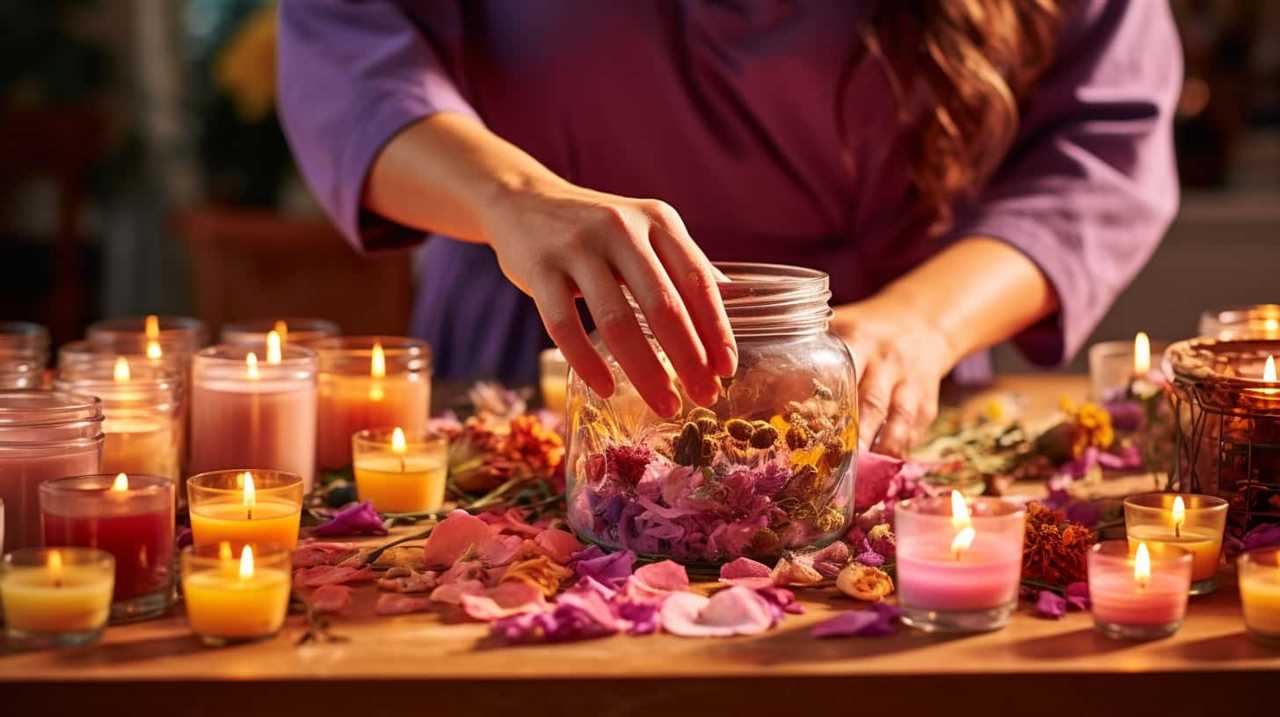
The Release of Carbon Dioxide
The combustion process of a candle also results in the release of carbon dioxide. When a candle burns, it undergoes a chemical reaction with the oxygen in the air, producing carbon dioxide as a byproduct. This release of carbon dioxide plays a crucial role in the candle’s combustion process.
The role of oxygen:
- Oxygen is necessary for the candle to burn because it acts as a reactant in the combustion reaction.
- As the candle burns, the oxygen molecules combine with the carbon atoms in the wax, resulting in the formation of carbon dioxide.
Impact on air quality:
- The release of carbon dioxide from burning candles can have an impact on indoor air quality, especially in poorly ventilated spaces.
- High levels of carbon dioxide can lead to discomfort, drowsiness, and even headaches in some individuals.
Understanding the role of oxygen and the impact of carbon dioxide release on air quality allows us to make informed choices when using candles, ensuring a safe and comfortable environment for ourselves and those we serve.
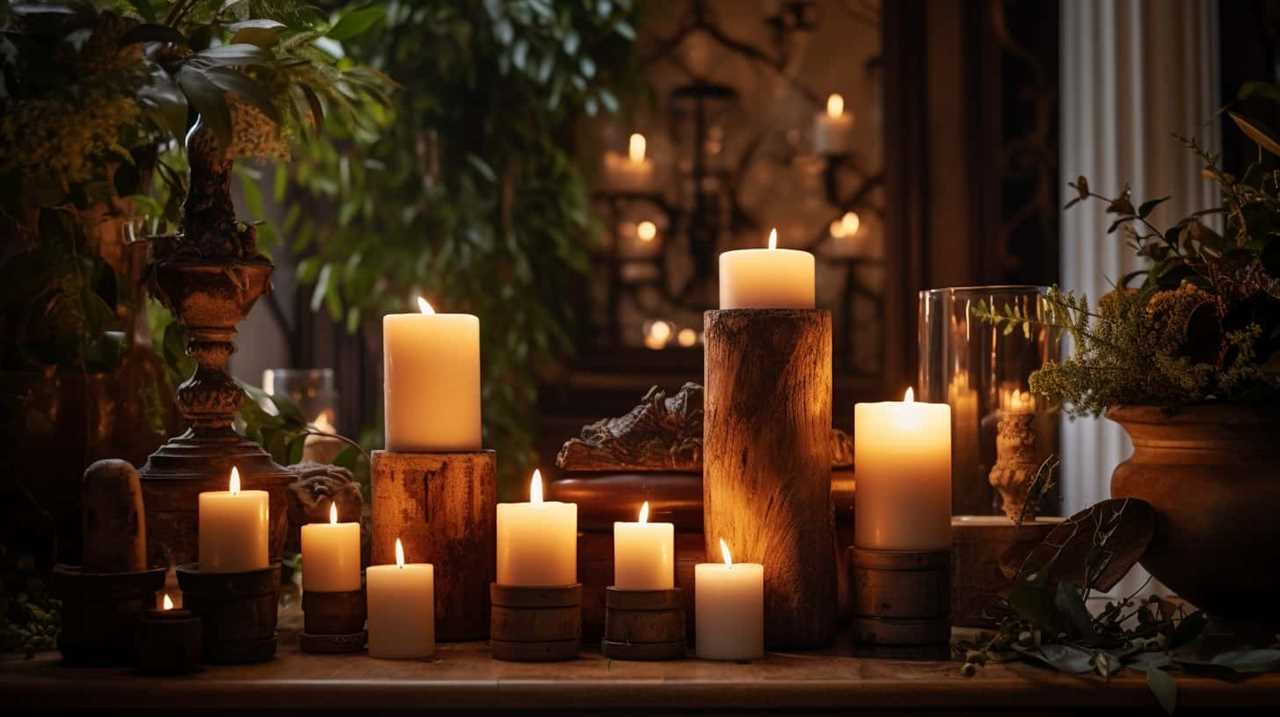
The Formation of Soot
One significant aspect of candle combustion is the formation of soot. When a candle burns, it releases tiny particles of carbon known as soot. Soot is formed when the carbon in the wax doesn’t completely burn and instead condenses into a solid form. These particles are then carried into the air as smoke and can have a significant impact on air quality.
Soot can contribute to the formation of smog and air pollution, leading to respiratory issues and other health problems. It can also settle on surfaces in our homes, leaving behind black stains and potentially causing damage. Therefore, it’s important to be mindful of the formation of soot when burning candles and take steps to minimize its impact on air quality.
The Melting and Pooling of Wax
As the candle burns all the way down, we can observe the melting and pooling of wax. The melting temperature of wax varies depending on its composition, but most candles melt between 120 and 160 degrees Fahrenheit.
When the flame reaches the bottom of the candle, the heat transfers to the surrounding wax, causing it to melt. As the wax melts, it pools around the wick, creating a reservoir of liquid wax. The pooling of wax is essential for the candle to continue burning, as it provides fuel for the flame.
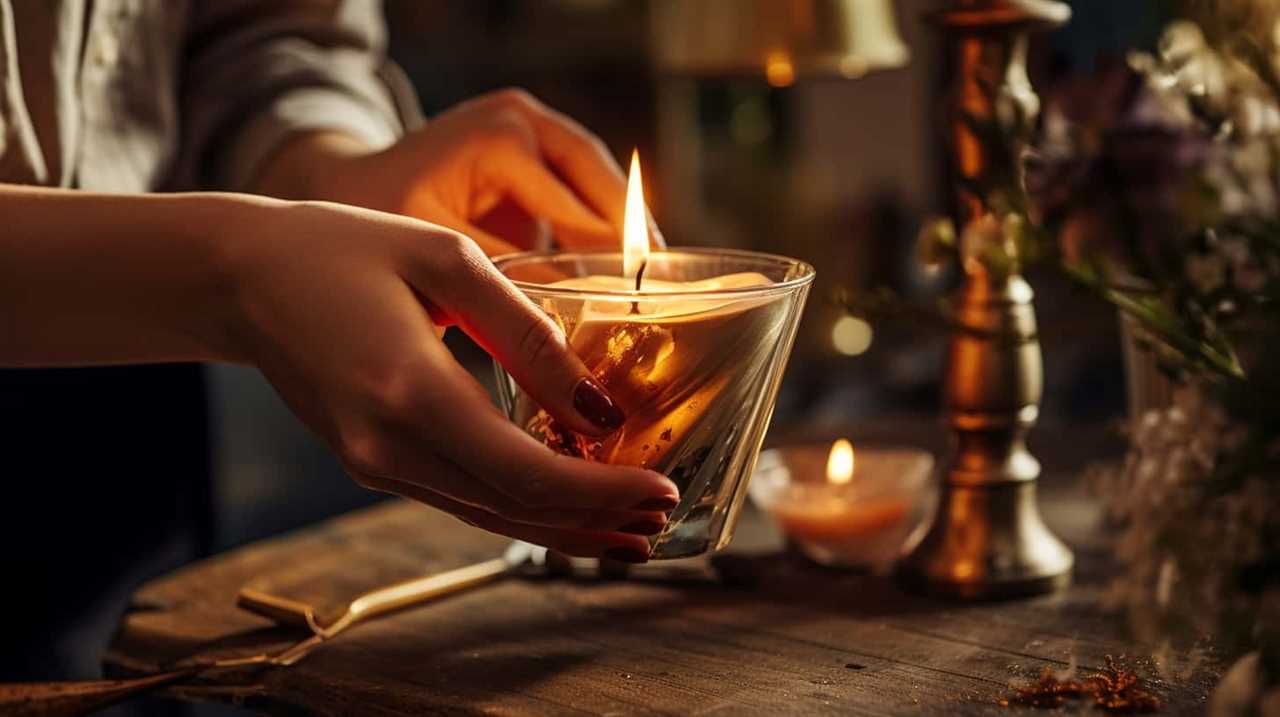
The composition of the wax determines its burn time and the quality of the flame. Paraffin wax, for example, is commonly used in candles and has a low melting temperature, making it easy to burn. Beeswax, on the other hand, has a higher melting temperature, resulting in longer burn times and a cleaner flame.
The Gradual Decrease in Flame Height
After observing the melting and pooling of wax, we can now discuss the gradual decrease in flame height as the candle burns all the way down. As the candle continues to burn, the flame height gradually decreases. This decrease in flame height is caused by the gradual decrease in heat produced by the burning wick. The heat generated by the flame is what initially melts the wax and creates the pool of liquid wax around the wick. However, as the flame height decreases, the amount of heat being produced decreases as well. This gradual decrease in heat has an impact on the surrounding wax. With less heat being generated, the surrounding wax cools down and solidifies, eventually extinguishing the flame completely.
To further understand the relationship between flame height and heat, let’s take a look at the following table:
| Flame Height | Heat Produced |
|---|---|
| High | High |
| Medium | Medium |
| Low | Low |
| Extinguished | None |
This table illustrates how the flame height and heat produced are directly related. As the flame height decreases, so does the heat being generated, until eventually the flame is extinguished and no heat is produced. This gradual decrease in flame height and heat ultimately leads to the candle burning all the way down and coming to an end.
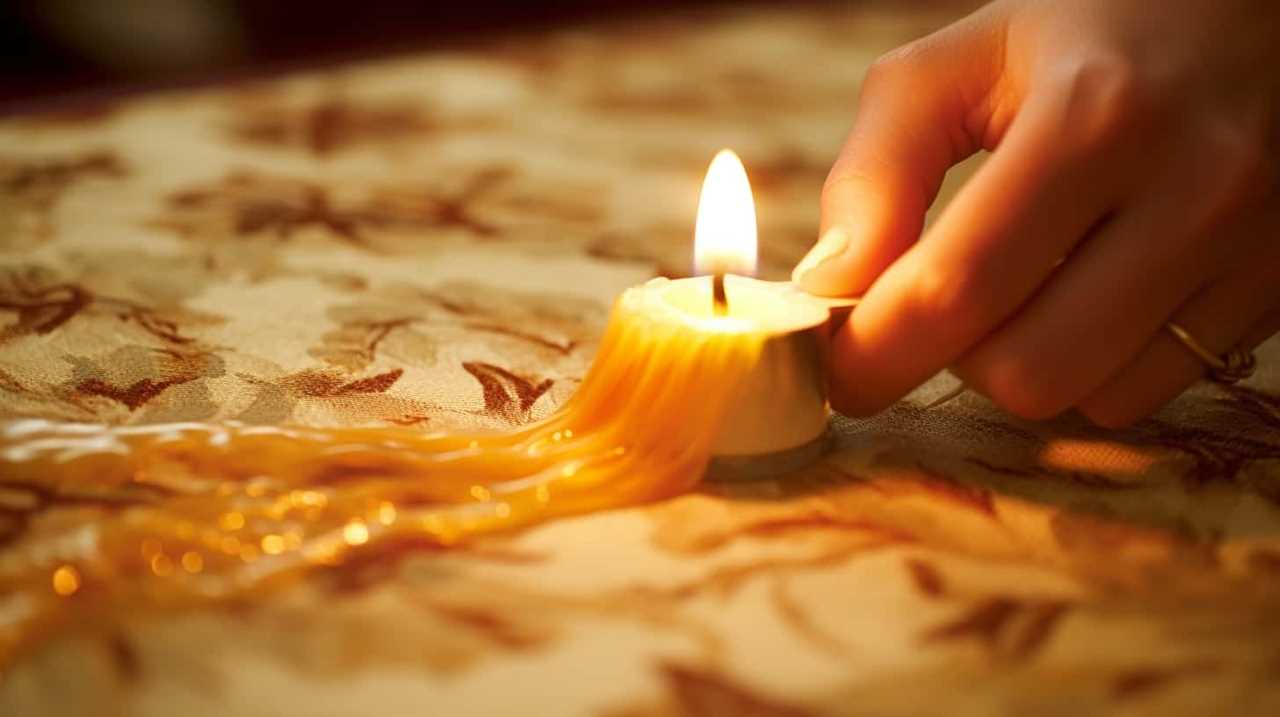
The Formation of Candle Tunnels
When a candle burns all the way down, it can sometimes form candle tunnels. Candle tunnels are narrow, hollow channels that form inside the candle wax, leaving the outer edges untouched. This can be caused by an uneven burn or improper wick trimming.
To prevent candle tunneling, it’s important to allow the candle to burn for at least one hour per inch of diameter and trim the wick to ¼ inch before each use. Candle tunnels can affect the overall burn time and fragrance throw of the candle, so it’s important to address this issue to ensure a complete and even burn.
Causes of Candle Tunnels
Throughout the burning process, a significant amount of unburned wax and soot can accumulate on the walls of the candle jar, leading to the formation of candle tunnels. The causes of candle tunnels can vary, but they generally result from improper burning techniques or candle design.
Here are some common causes of uneven burning and ways to prevent tunneling:
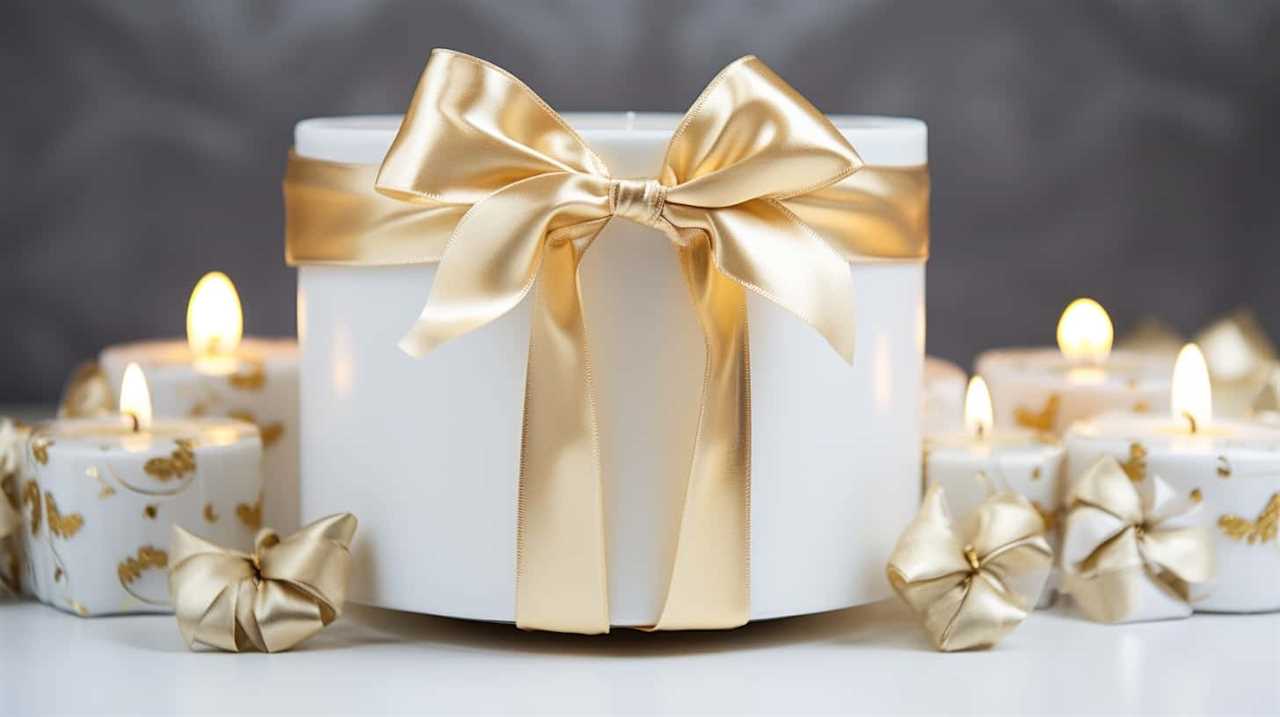
- Uneven wick trimming: If the wick isn’t trimmed to the recommended length of about 1/4 inch, it can create an uneven burn and contribute to tunneling. Regularly trim the wick before lighting the candle to ensure a balanced burn.
- Drafty environment: Air drafts can disrupt the flame and cause the candle to burn unevenly. Avoid placing candles in drafty areas and ensure a still environment for an even burn.
Preventing Candle Tunneling
To prevent the formation of candle tunnels, we need to address the underlying causes and implement preventative measures. Proper candle maintenance is crucial in preventing tunneling.
First, it’s important to trim the wick to ¼ inch before each use. This helps maintain a controlled flame, preventing excessive heat and uneven burning. Additionally, ensure that the candle is placed on a level surface and away from drafts. This will promote even melting and prevent the formation of tunnels.
Burning the candle for a minimum of 1 hour per inch in diameter is also recommended. This allows the wax to melt evenly and prevents tunneling. Lastly, avoid burning candles for more than four hours at a time to prevent overheating and tunneling.
Effects of Candle Tunnels
Candle tunnels, formed when a candle burns all the way down, can have detrimental effects on the overall performance and lifespan of the candle. These tunnels are narrow channels that form along the inner walls of the candle, leaving unburned wax around the edges.
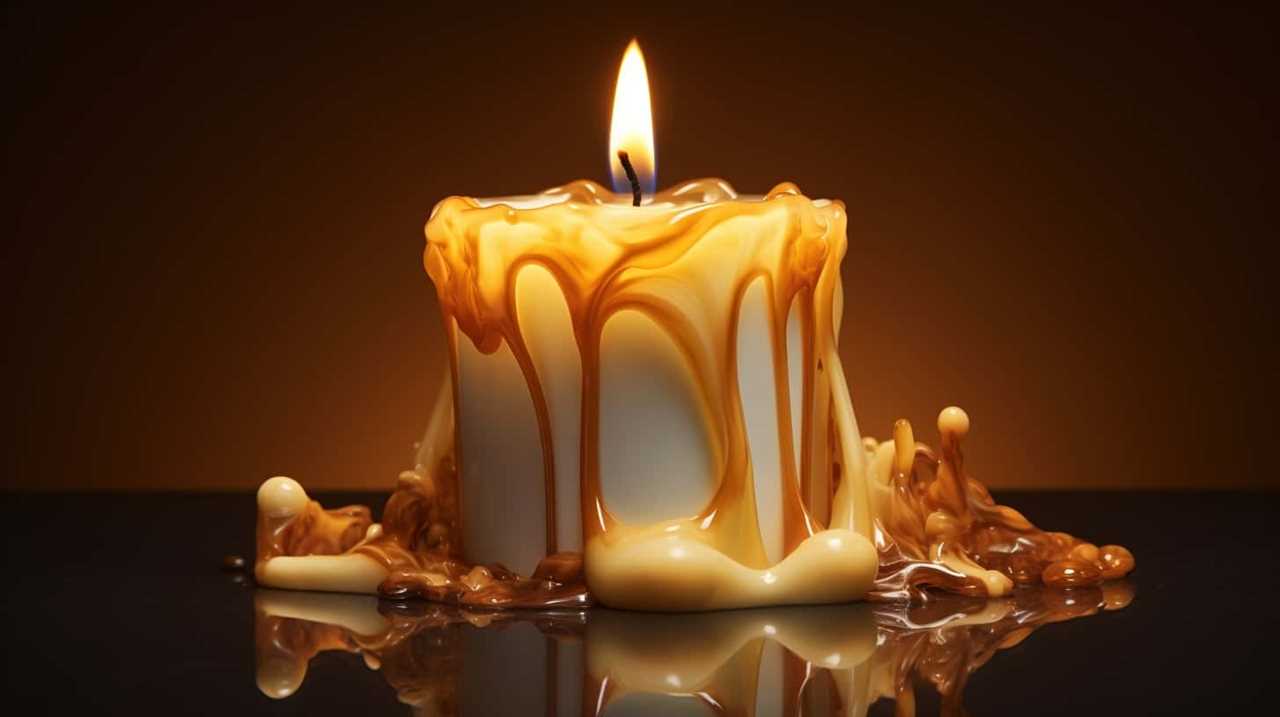
Here are the main effects of candle tunnels:
- Causes of uneven burning:
- Tunneling is usually caused by the first burn of the candle, where the wax isn’t allowed to melt completely to the edges.
- Using a candle with a small wick or placing it in a drafty area can also contribute to uneven burning.
- Impact of candle tunnels on fragrance distribution:
- Candle tunnels restrict the release and distribution of fragrance, as the tunnel prevents the melted wax from reaching the outer edges where the fragrance oils are usually concentrated.
- This can result in a weaker scent throw and less effective fragrance diffusion throughout the room.
To maintain optimal performance and fragrance distribution, it’s important to prevent the formation of candle tunnels by properly burning the candle during its initial use.
The End of the Wick
As the candle burns all the way down, we frequently notice the gradual disappearance of the wick. This is a natural occurrence that happens when the wax is fully consumed.
However, it’s important to note that proper wick maintenance is essential for candle safety. A well-maintained wick ensures a clean and efficient burn, reducing the risk of accidents such as excessive sooting or the flame becoming too large.
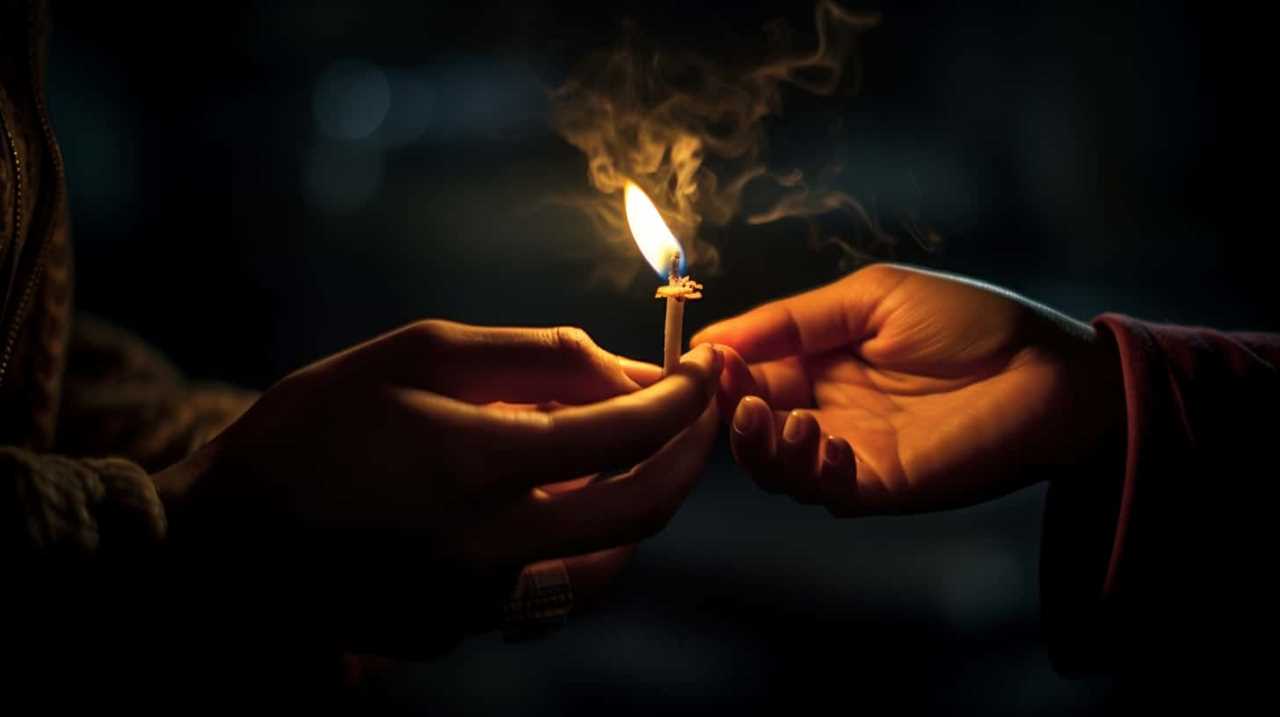
To maintain the wick, it’s recommended to trim it to about 1/4 inch before each use. This helps to prevent the flame from flickering and promotes an even burn.
Additionally, keeping the candle away from drafts and flammable objects further enhances safety.
The Extinguishing of the Flame
As the candle burns all the way down, the flame begins its final flicker, dancing and wavering on the verge of extinction. The once bright and vibrant light gradually dims, until it becomes a mere ember, struggling to hold on to its existence.
Eventually, the flame succumbs to the lack of fuel and oxygen, and finally goes out, leaving behind a trail of smoke and the faint scent of burnt wax.
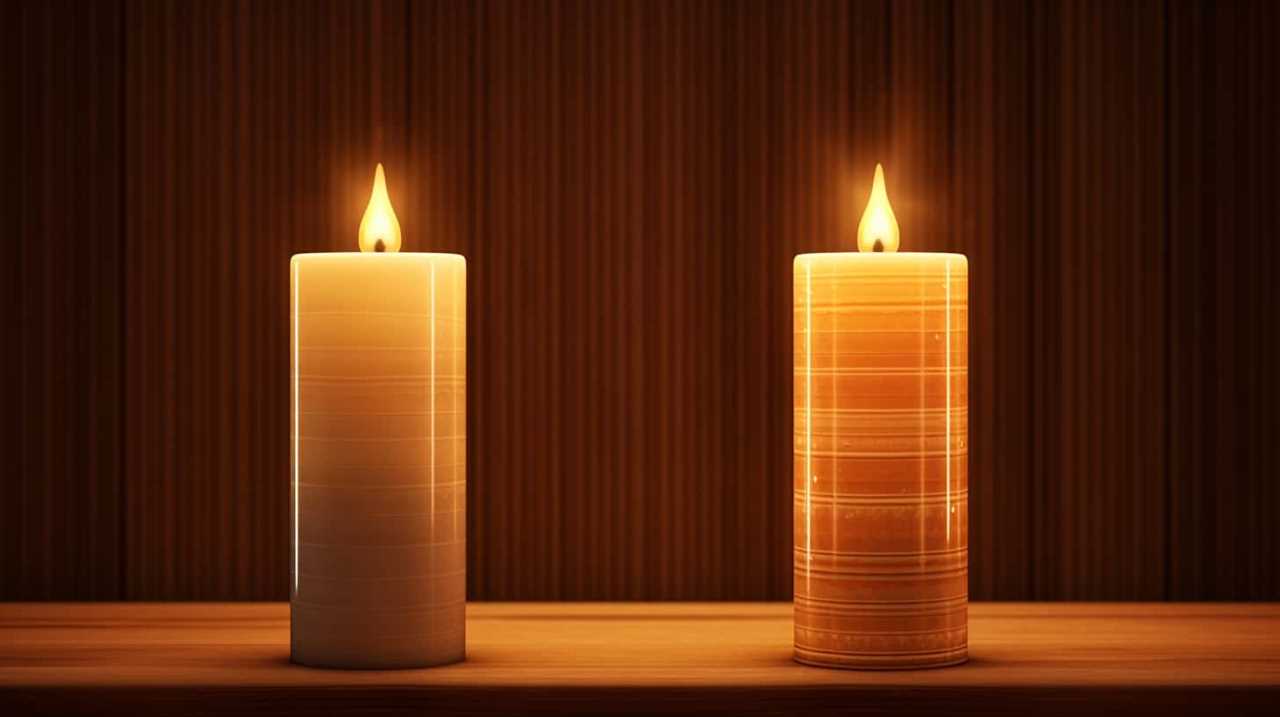
Flame’s Final Flicker
When the flame of a candle burns all the way down, we witness the moment of its final flicker before it’s extinguished. This final flicker is a fascinating phenomenon, influenced by the flame’s flickering patterns and the impact of air flow. Here are two key aspects to consider:
- Flickering Patterns:
- As a candle burns low, the flame’s flickering becomes more erratic and unsteady.
- The flickering can intensify, causing the flame to dance and waver.
- Impact of Air Flow:
- The availability of oxygen plays a crucial role in sustaining the flame.
- When the wax is nearly consumed, the shrinking pool of fuel reduces the flame’s stability and makes it vulnerable to even slight air movements.
Understanding these aspects helps us appreciate the beauty of the flame’s final flicker, as it gracefully dances its last dance before gently fading away.
Last Dying Ember
After witnessing the flame’s final flicker, we reach the last stage of a candle burning all the way down: the extinguishing of the flame. It’s a moment that marks the end of the candle’s journey and the completion of its purpose.
The candle’s final glow, however dim, creates a serene ambiance, inviting us to reflect on the light it has brought into our lives.

As we approach the extinguishing of the flame, we may choose to partake in various extinguishing rituals. These rituals can include gently blowing out the flame, using a snuffer to slowly suffocate it, or even using the melted wax to smother the remaining embers. Each ritual holds its own significance, allowing us to bid farewell to the candle’s presence and honor its service to us.
The Aftermath: Clean up and Safety Precautions
Our first step after a candle has burned all the way down is to clean up the remnants and ensure safety precautions are taken. Here are some cleaning tips to help you with the aftermath:
- Remove the wax: Use a butter knife or a plastic scraper to gently scrape off the hardened wax from surfaces.
- Clean the holders: Wash candle holders with warm soapy water to remove any remaining wax residue. Dry them thoroughly before reuse.
Now, let’s talk about safety measures to prevent accidents:
- Extinguish properly: Always blow out candles before leaving the room or going to bed. Never leave a burning candle unattended.
- Keep away from flammables: Place candles at least one foot away from anything that can catch fire, such as curtains, decorations, or furniture.
Frequently Asked Questions
How Long Does It Take for a Candle to Burn All the Way Down?
When a candle burns all the way down, it can take varying amounts of time depending on the size of the candle. Additionally, if a candle burns in a vacuum, it will extinguish due to lack of oxygen.
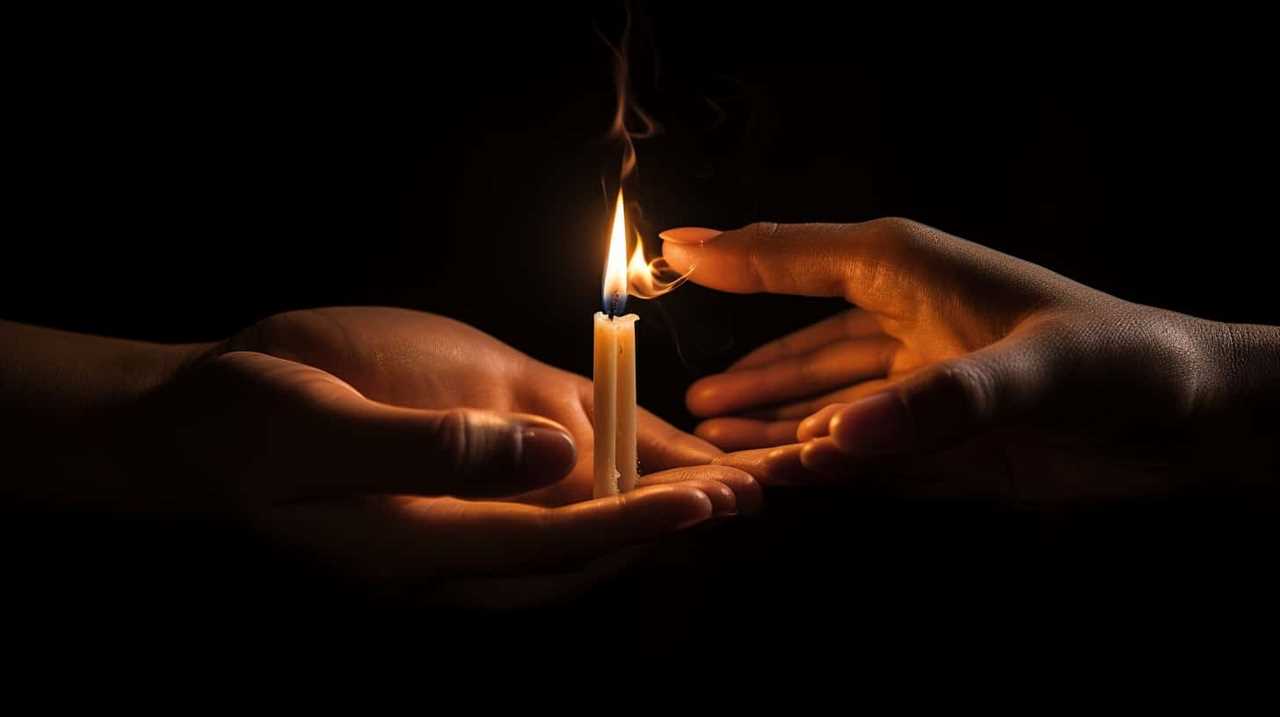
Can a Candle Burn Without a Wick?
We were curious if a candle can burn without a wick. As we researched, we discovered that without a wick, the candle cannot sustain a flame. The wick provides the fuel source by drawing up the melted wax.
What Causes a Candle to Flicker?
When a candle flickers, it is caused by the impact of air flow on the flame. The movement of air disrupts the balance of heat and fuel, causing the flame to waver.
Why Does the Flame of a Candle Turn Yellow?
When a candle burns all the way down, the flame turns yellow due to the presence of impurities in the wax. These impurities create chemical reactions that alter the color of the flame.
Can a Candle Burn Underwater?
Yes, a candle can burn underwater, but with safety precautions. When submerged, the flame will go out due to lack of oxygen. However, the wick will continue to smolder until it dries out.
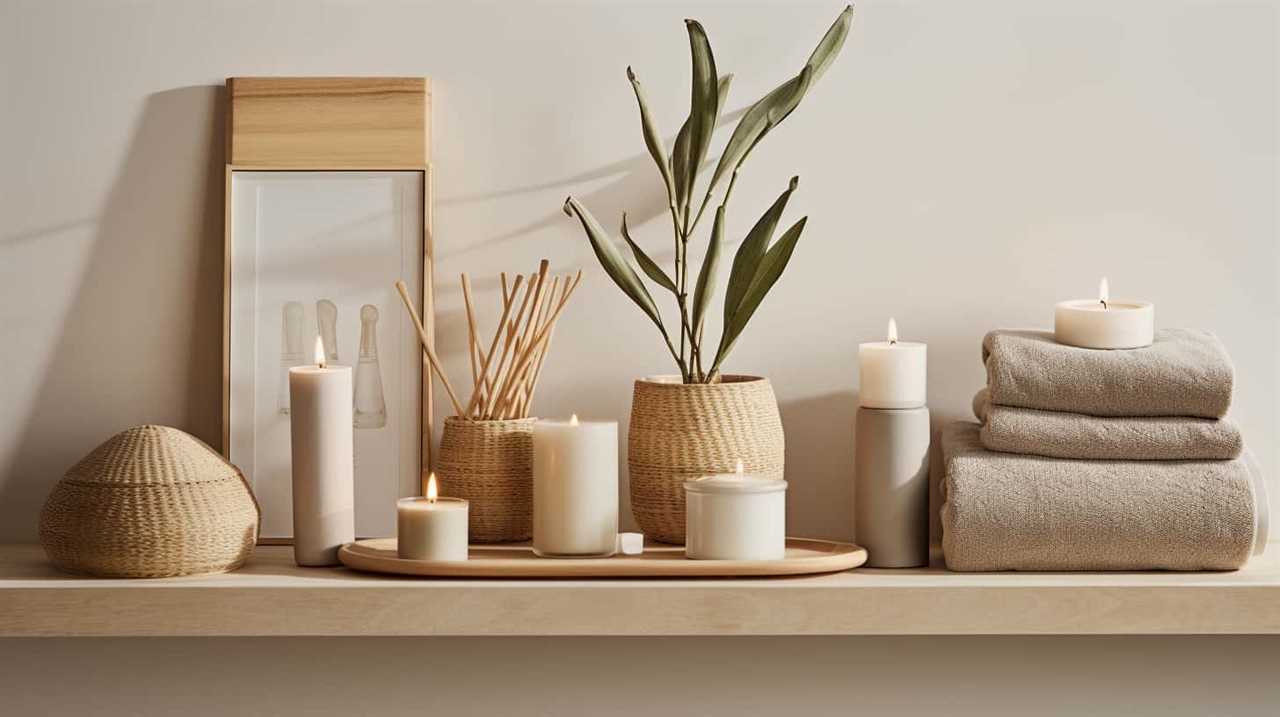
Conclusion
In conclusion, when a candle burns all the way down, it goes through a fascinating chemical process that involves the ignition and combustion of its components. The wick plays a crucial role in providing fuel for the flame, while producing heat and light.
It’s interesting to note that sometimes candle tunnels can form, creating unique patterns as the wax melts. Once the flame reaches the end of the wick, it’s extinguished, leaving behind a mesmerizing aftermath.
For example, imagine a candle that burns completely, leaving behind a beautiful, intricate wax sculpture.
I’m Jane and I love candles. I have candles everywhere in my house–in every room, on every surface. I love the smell of candles, and I love how they make my place feel warm and cozy.
Candles are really important to me. They help me relax and de-stress after a long day. They remind me of happy memories, and they make me feel calm and peaceful. I can’t imagine my life without candles!
-
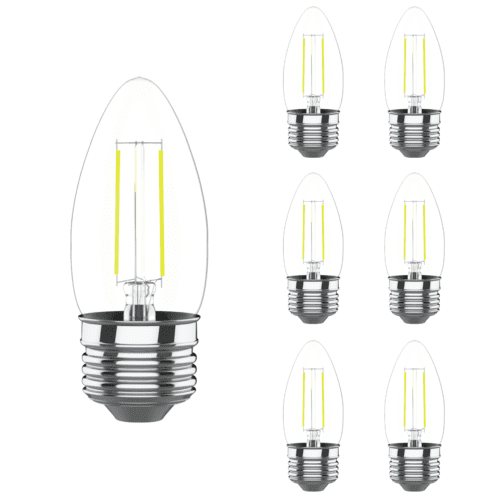
 Beginners Guides1 week ago
Beginners Guides1 week agoThe Similarities of Candle and Light Bulb Lamps
-

 Beginners Guides7 days ago
Beginners Guides7 days agoHow to Determine If Candles Will Melt Outside
-
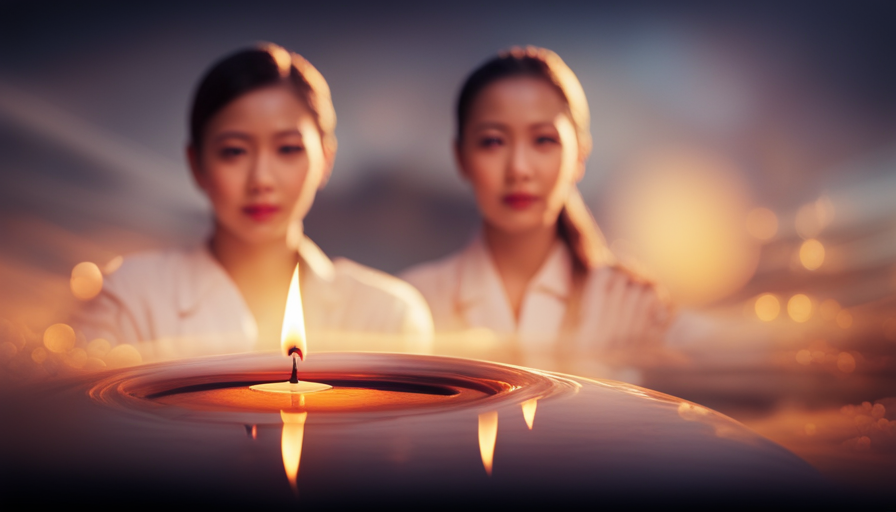
 Beginners Guides3 months ago
Beginners Guides3 months agoHow To Burn A Candle Without A Wick
-
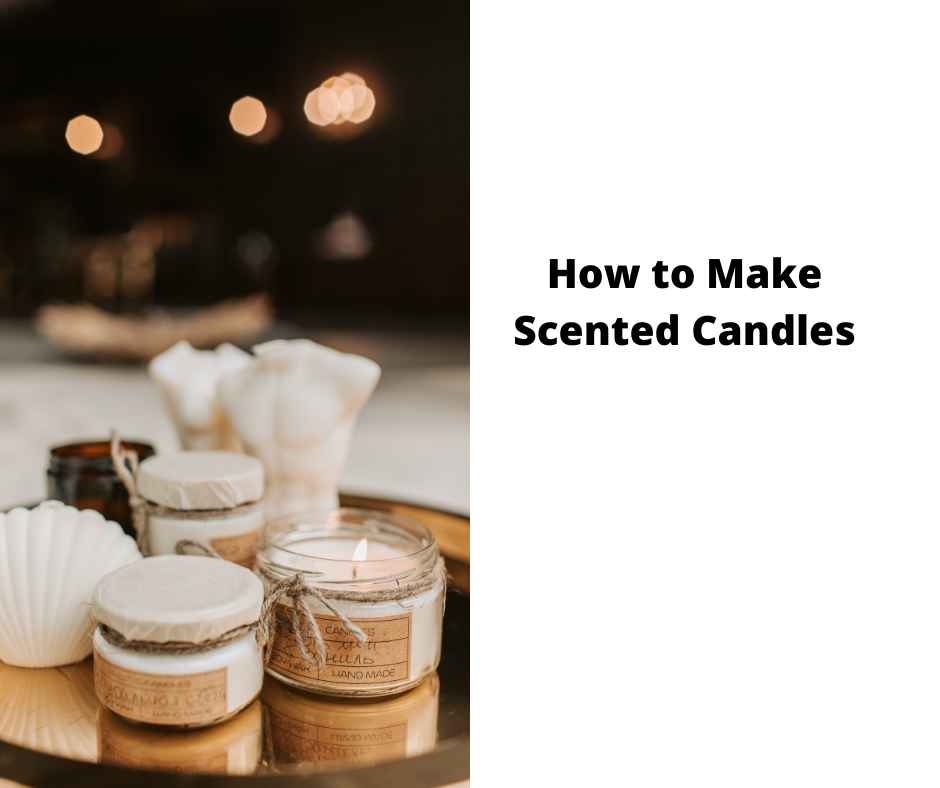
 Candles3 weeks ago
Candles3 weeks agoHow to Make Scented Candles
-

 Beginners Guides3 weeks ago
Beginners Guides3 weeks agoAre Yankee Candles Vegan?
-
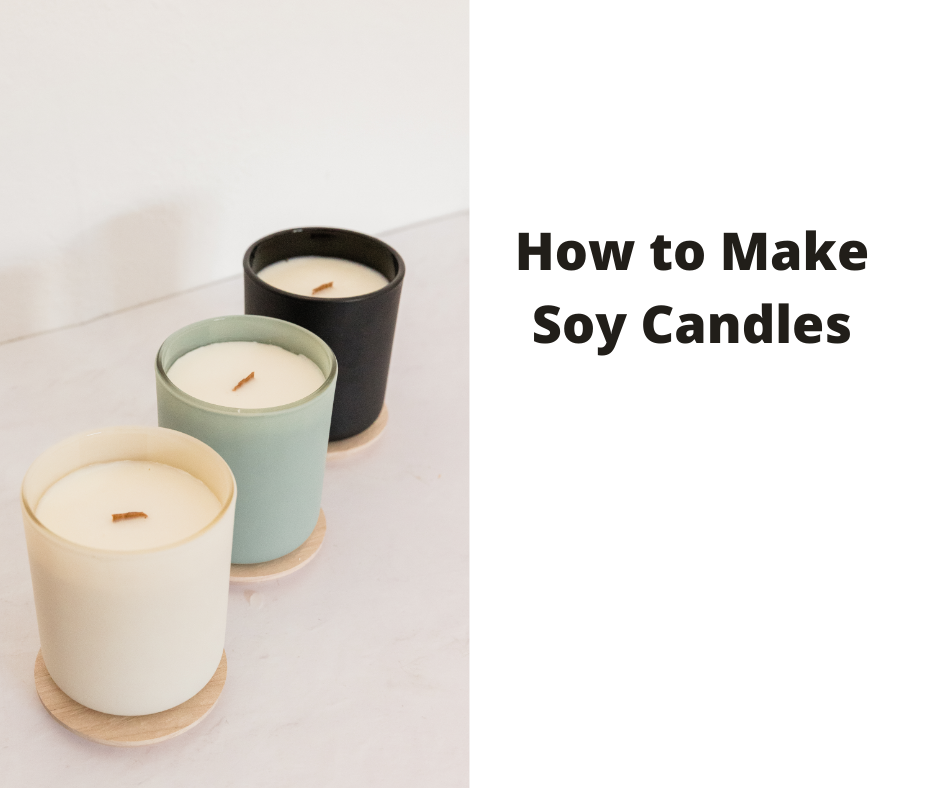
 Beginners Guides3 weeks ago
Beginners Guides3 weeks agoHow to Make Soy Candles
-
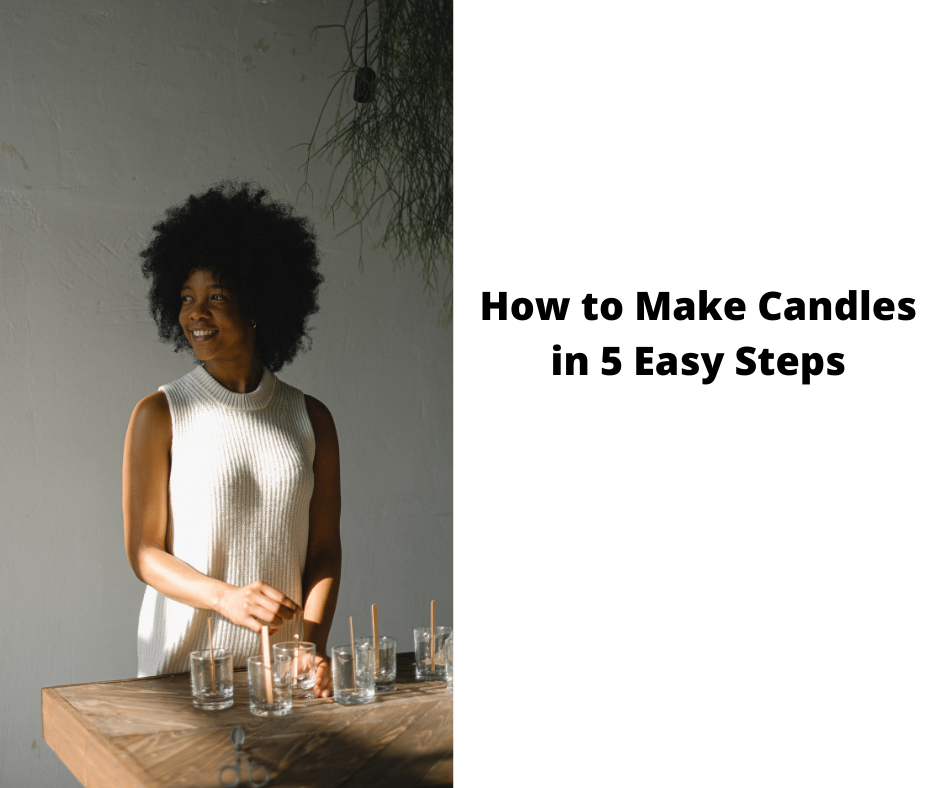
 Beginners Guides1 month ago
Beginners Guides1 month agoHow to Make Candles in 5 Easy Steps
-

 Beginners Guides7 days ago
Beginners Guides7 days agoWhy is My Candle Not Sticking to the Glass?









